inbox and Environment news: Issue 518
November 14 - 20, 2021: Issue 518
Flowering Now: Blueberry Ash
Happening Now: Spotted Gums Shedding Bark - Part Of An Endangered Ecological Community
- Acacia floribunda
- Acrotriche divaricata
- Adiantum aethiopicum
- Allocasuarina litoralis
- Allocasuarina torulosa
- Angophora costata
- Angophora floribunda
- Billardiera scandens
- Breynia oblongifolia
- Cassytha paniculata
- Cayratia clematidea
- Cissus hypoglauca
- Corymbia gummifera
- Corymbia maculata
- Dianella caerulea
- Dodonaea triquetra
- Doodia caudata
- Eleocarpus reticulatis
- Entolasia stricta
- Eucalyptus botryoides
- Eucalyptus paniculata
- Eucalytpus punctata
- Eucalyptus umbra
- Eustrephus latifolius
- Geitonoplesium cymosum
- Glochidion ferdinandi
- Gymnostachys anceps
- Hakea sericea
- Hydrocotyle peduncularis
- Livistona australis
- Lomandra longifolia
- Macrozamia communis
- Notelaea longifolia
- Oxylobium ilicifolium
- Pandorea pandorana
- Pittosporum undulatum
- Platylobium formosum
- Pseuderanthemum variabile
- Pteridium esculentum
- Pultenaea flexilis
- Syncarpia glomulifera
- Synoum glandulosum
- Themeda australis
- Xanthorrhoea macronema
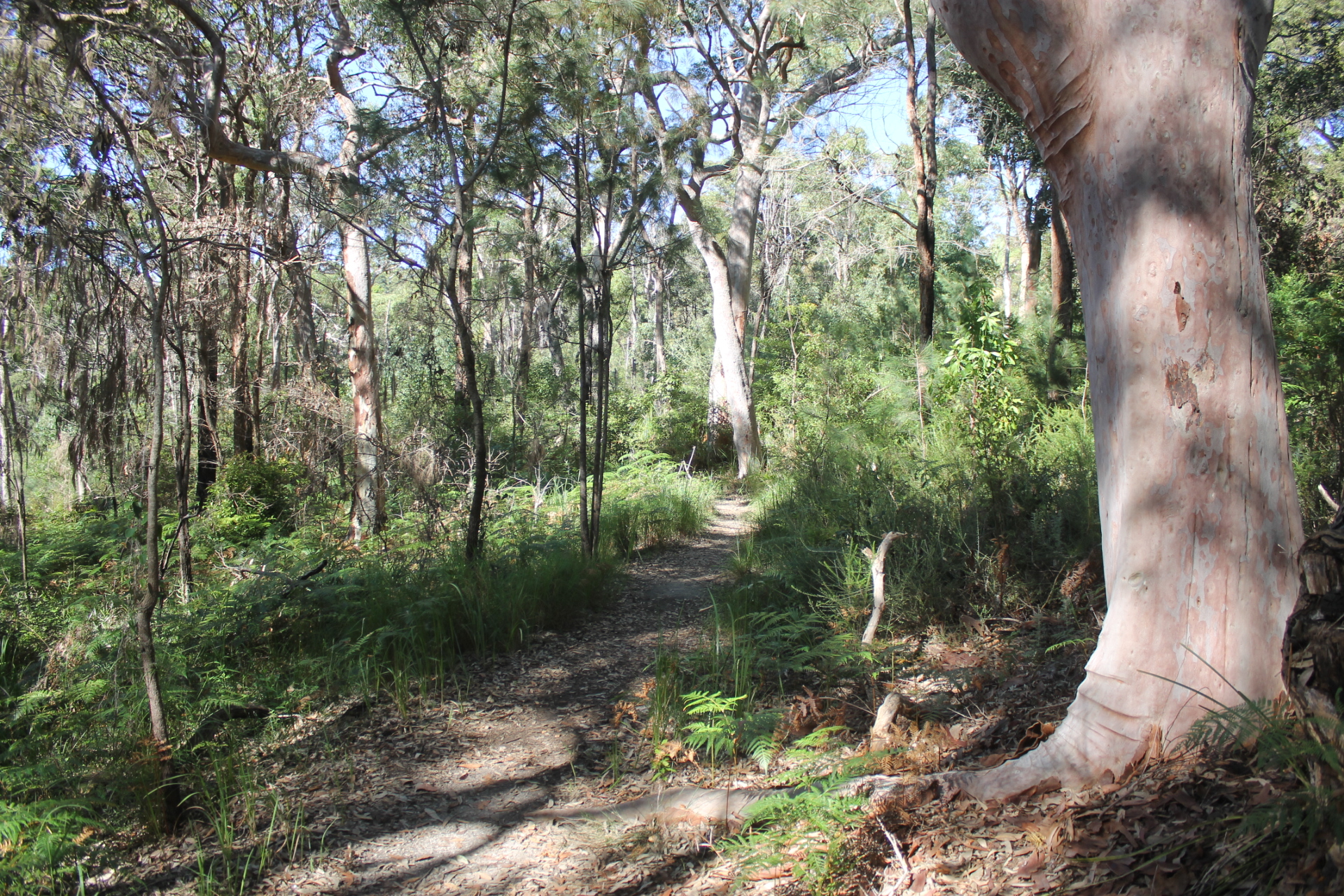
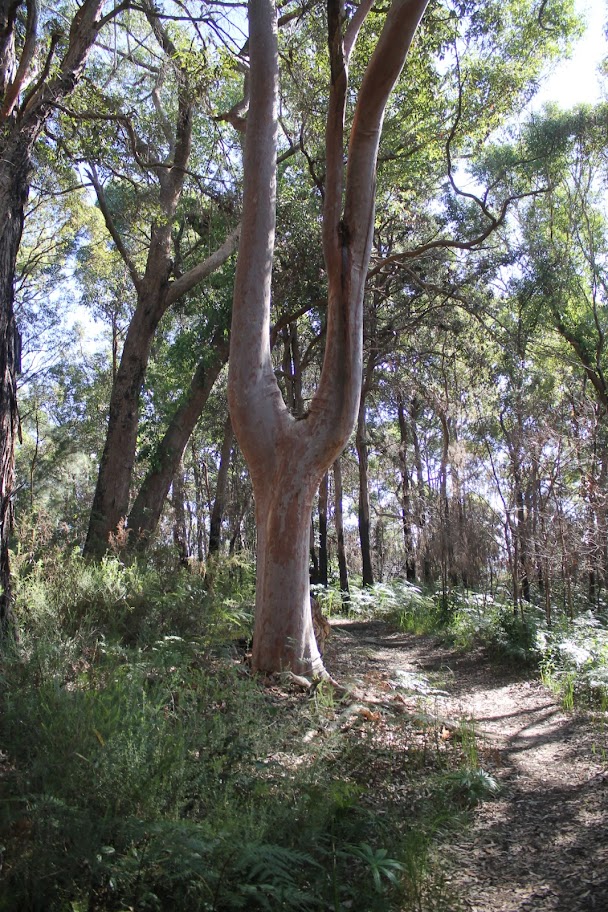
- Benson, D. and Howell, J., 1990, Taken for Granted: The bushland of Sydney and its suburbs, Kangaroo Press, Kenthurst.
- Benson, D. and Howell, J. (1994) The natural vegetation of the Sydney 1:100 000 Map Sheet. Cunninghamia 3(4):677-787.
- ANPS - Australian Native Plants society, Corymbia maculata, from: http://anpsa.org.au/c-mac.html
- Pittwater Spotted Gum Forest - endangered ecological community listing, NSW Department of Planning, Industry and Environment
Woolworths Installs Recycled Plastic Seats In Australian Stores
Careel Creek: Dusky Moorhen In Residence - Please Keep Your Dogs On Their Leads
Dusky Moorhen in Careel Creek, Saturday October 30, 2021 - photos by A J Guesdon
Dusky Moorhen in Careel Creek, Thursday November 30, 2021 - photos by A J Guesdon
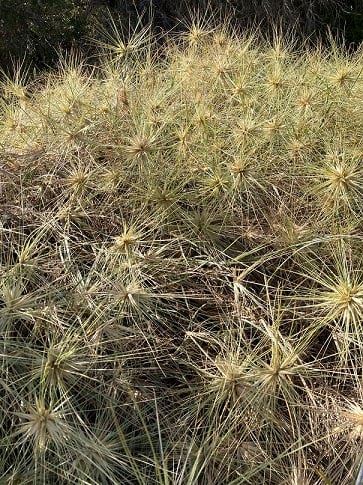 Pittwater Natural Heritage Association (PNHA): Pittwater Nature No:8
Pittwater Natural Heritage Association (PNHA): Pittwater Nature No:8
Councils Urged To Get Scrap Together To Turn Food Waste Into Compost
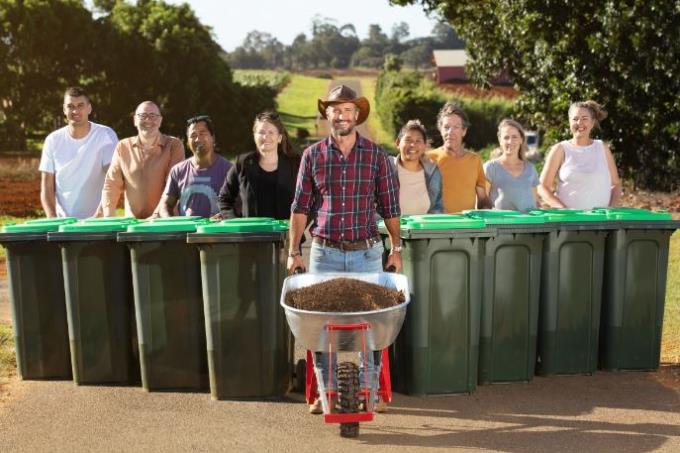 More food waste will be saved from landfill thanks to a tailored education campaign to help communities turn more of their food scraps into valuable compost.
More food waste will be saved from landfill thanks to a tailored education campaign to help communities turn more of their food scraps into valuable compost.Wild Pollinator Count: November 14-21
November 2021 Forum For Friends Of Narrabeen Lagoon Catchment: Fishing Bats And Water Rats (Rakali)
.jpg?timestamp=1631741816240)
.jpg?timestamp=1631741908384)
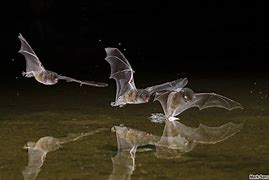

Draft Marine Park Management Plan Released
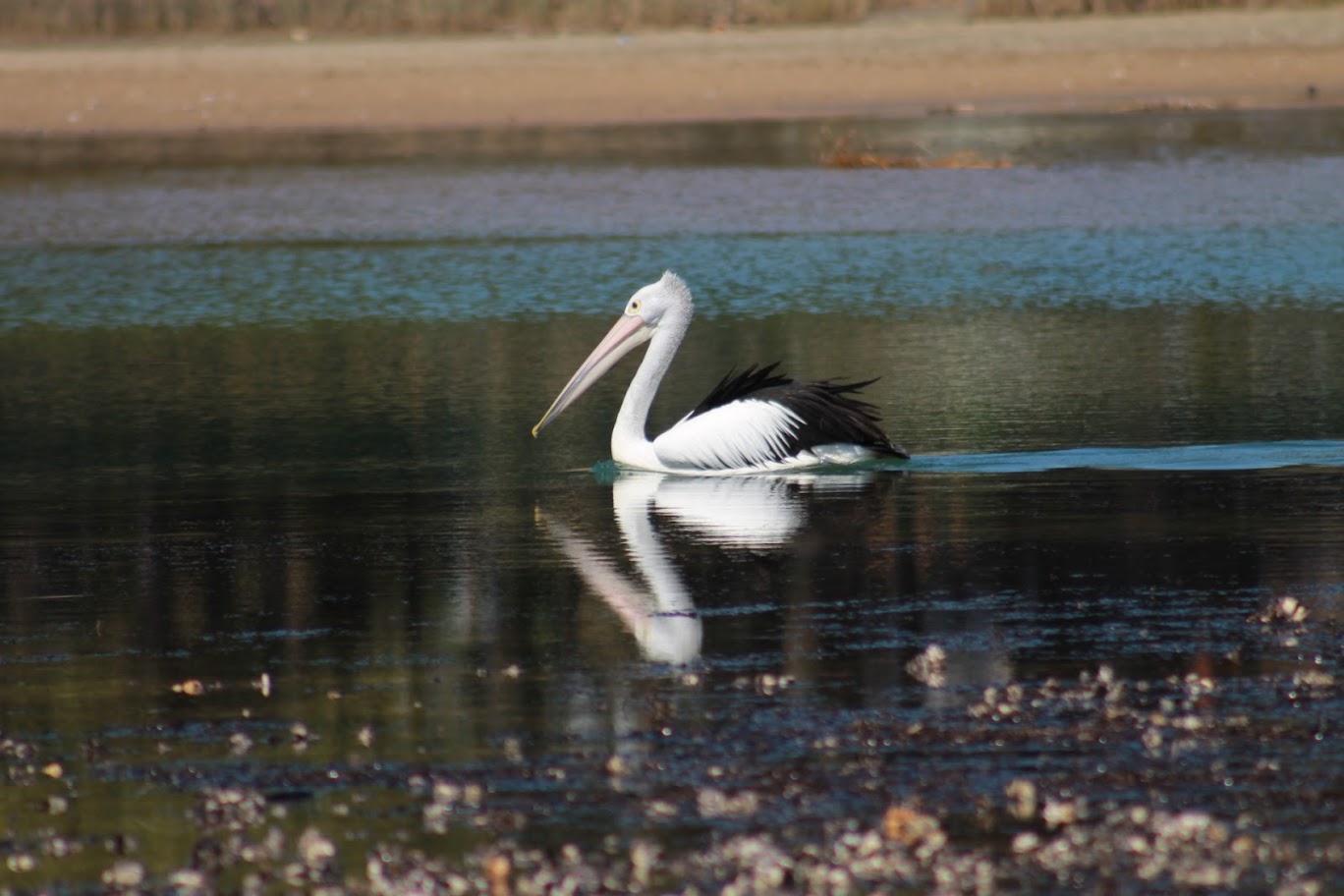
Home Gardeners In Sydney Basin To Help Protect Local Fruit And Vegetable Production: Get Your Free Sticky Trap
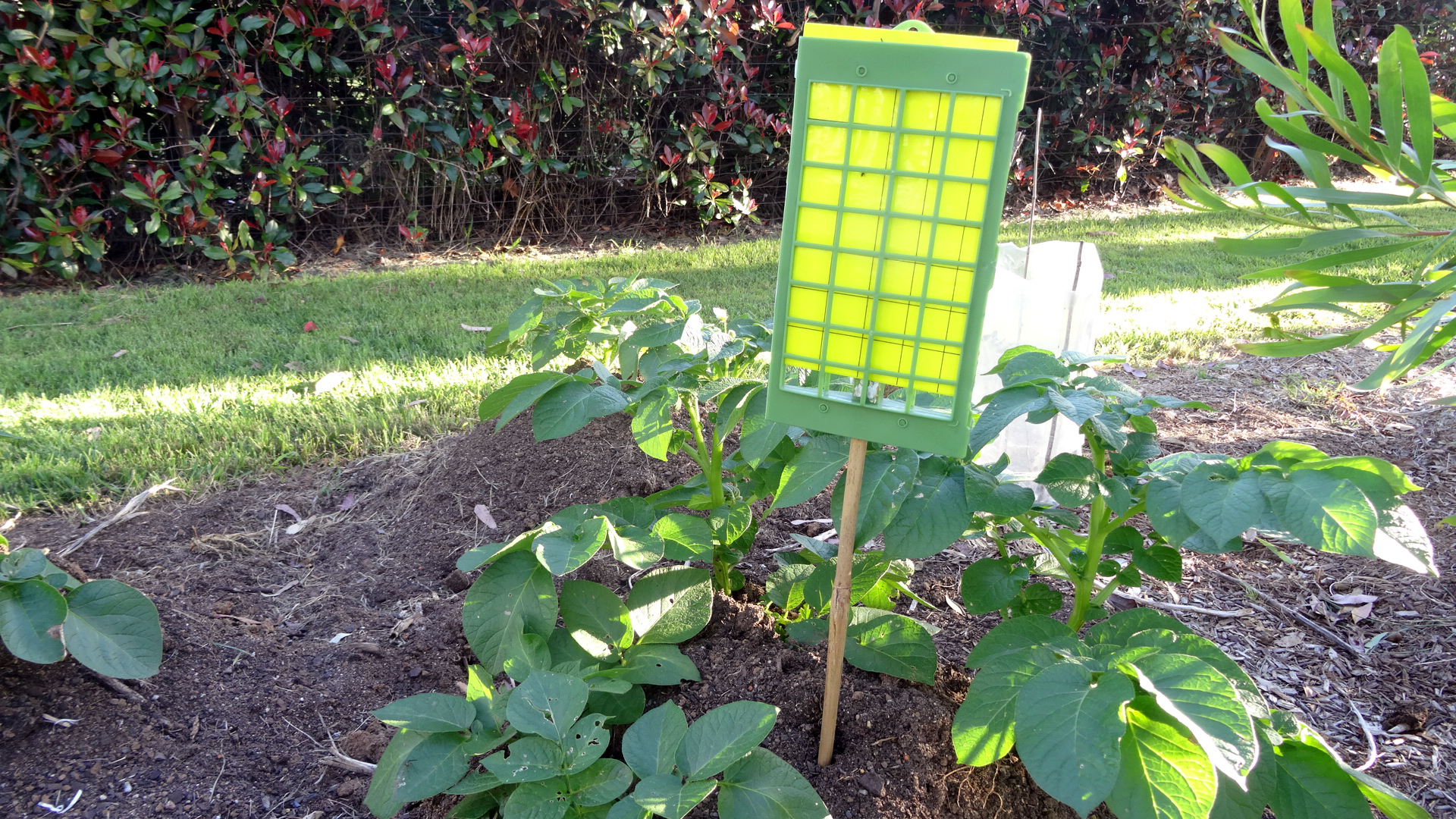
Migratory Bird Season
Baby Wildlife Season

Harry the ringtail possum. Sydney Wildlife photo
Blockade Australia Purpose Statement + Actions
“I’m sick of Australia destroying country and sacred sites to get their resources. That’s why I am here doing this action today to put a stop to it myself.” - Wilkarr Kurikutahr
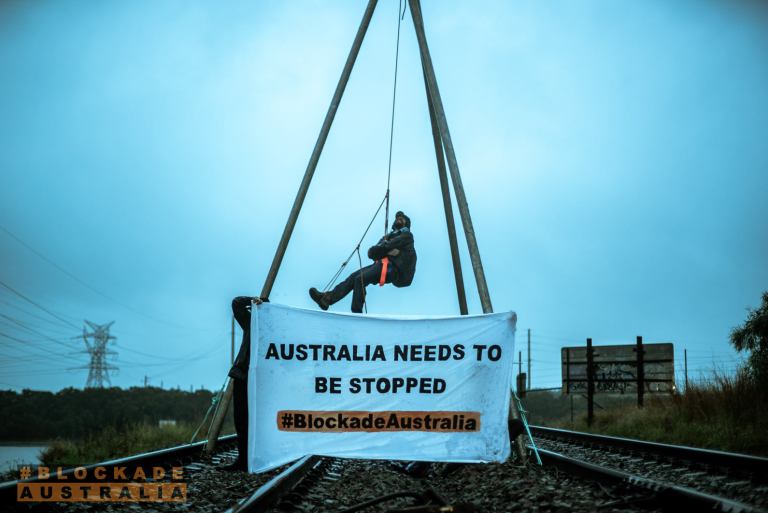
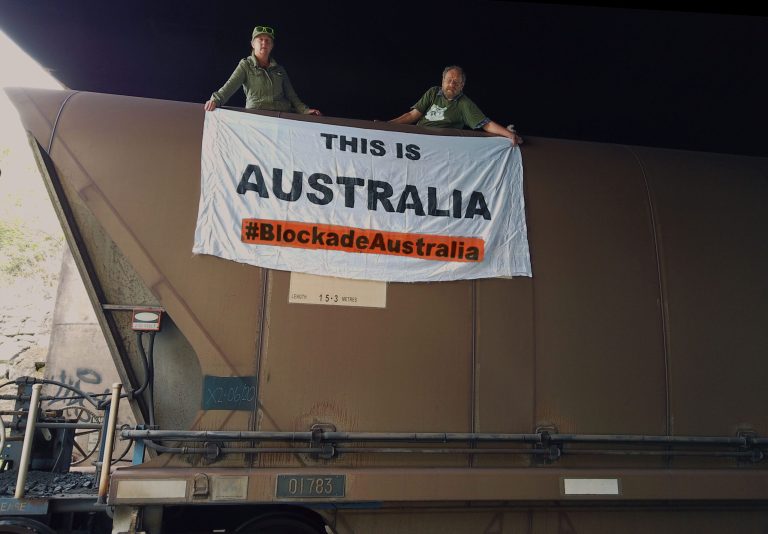
NSW, ACT And SA To Be Founding Members Of Net Zero Emissions Policy Forum At Glasgow
- provide a repository of existing policies and resources that can be accessed by participants
- facilitate collaboration between governments to design policies and to work together to solve the problems of achieving net zero emissions
- enable problem solving to address policy challenges and speed up the transition to net zero.
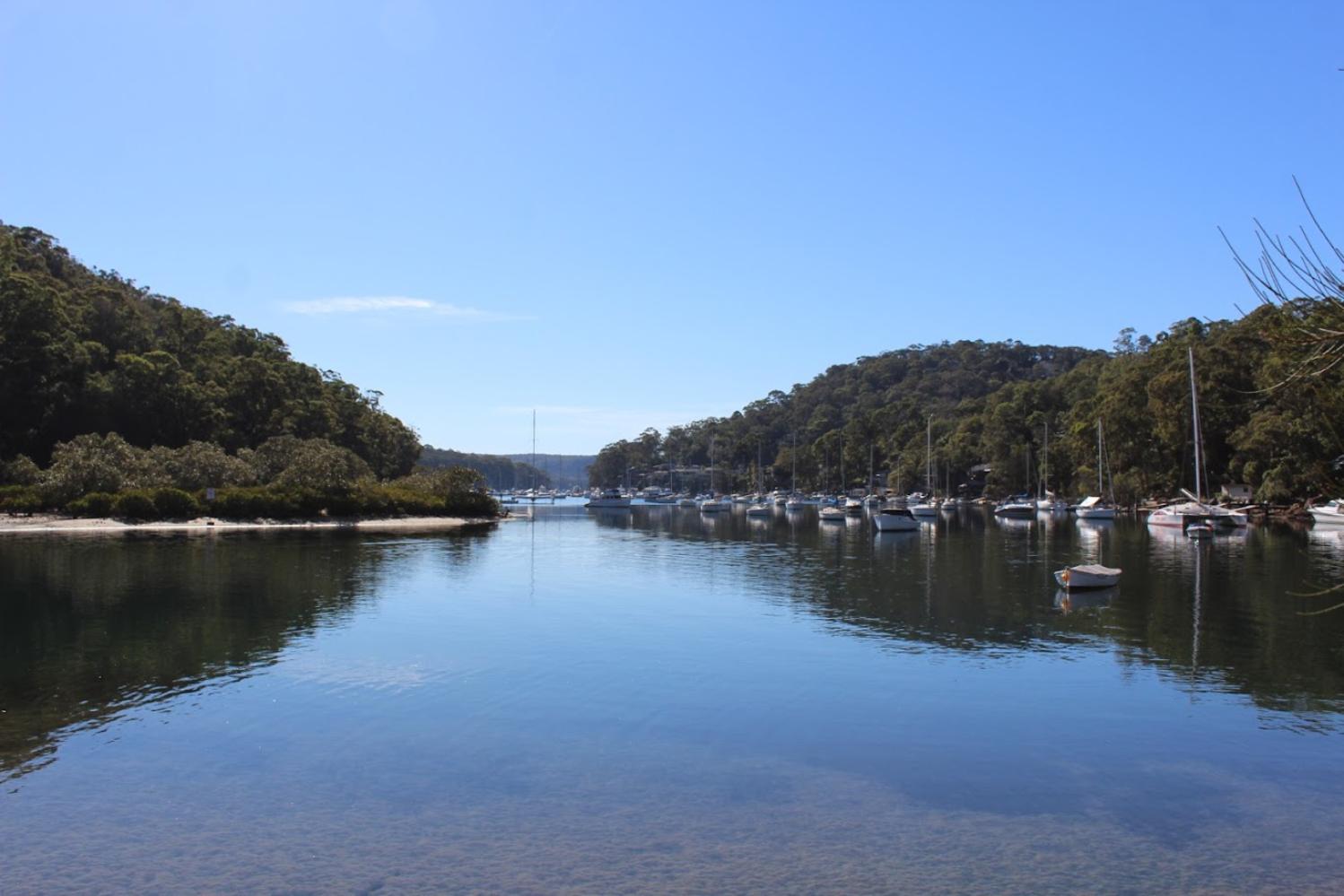
NSW National Parks Commits To Net Zero By 2028
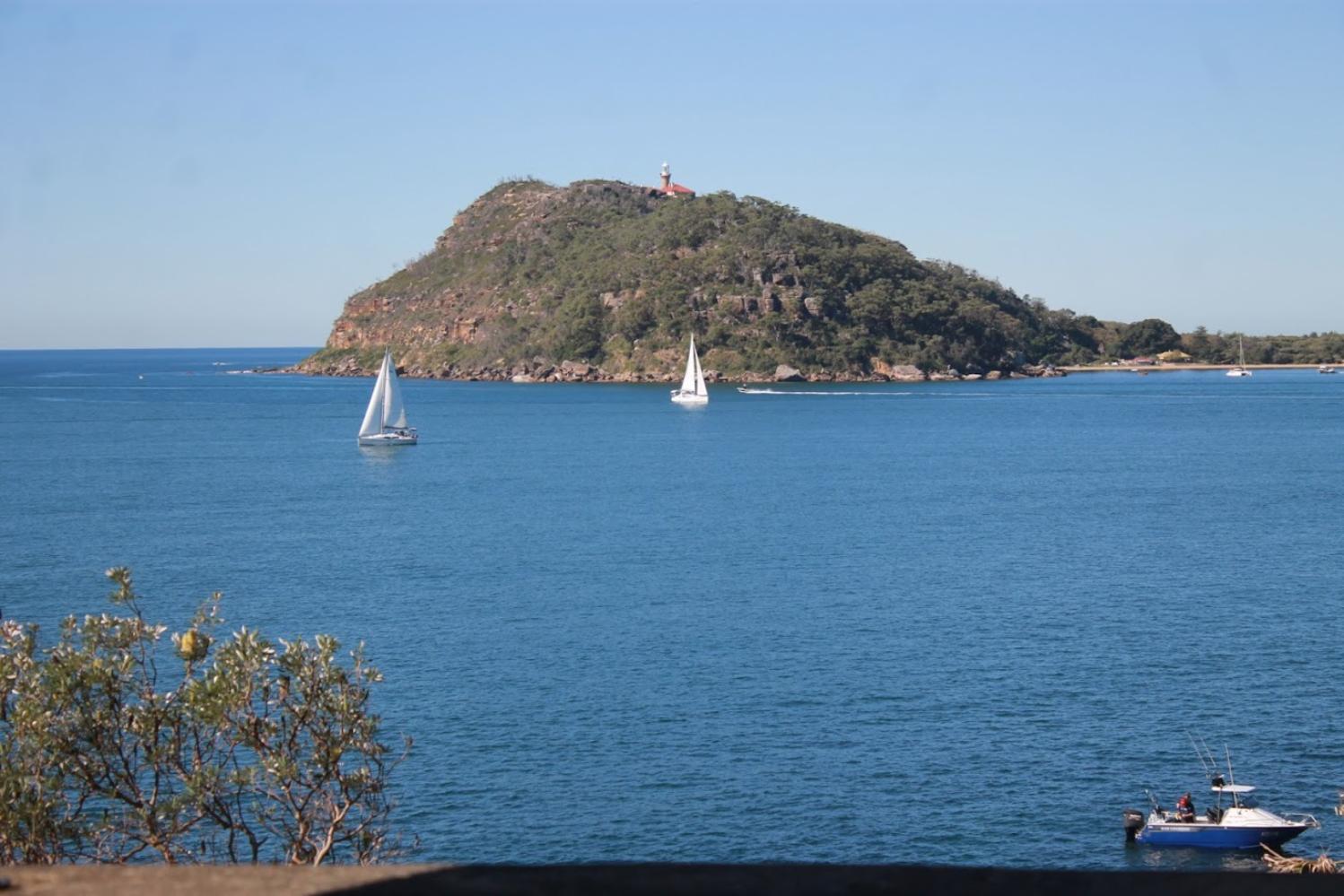
Australia's First Renewable Energy Zone Declared
$13 Million To Halve Kooragang Island's Emissions And Support Jobs
ORICA PARTNERS WITH GOVERNMENT TO REDUCE KOORAGANG ISLAND SITE GHG EMISSIONS BY 48%
- The primary source of GHG emissions at the Kooragang Island facility is from the production of ammonia and nitric acid, both intermediaries in the production of ammonium nitrate. The production of nitric acid generates nitrous oxide as a by-product of catalytic oxidation of ammonia.
- In 2022, Orica will upgrade three nitric acid processing plants at its Kooragang Island site used in the production of ammonium nitrate, with technology designed to abate nitrous oxide emissions.
- This will be the first time the technology has been deployed in Australia, and is designed to deliver up to 95 per cent abatement efficiency from unabated levels. We expect to see a reduction in emissions by 567,000 tCO2e per year, and deliver a cumulative emissions reduction of at least 4.7 MtCO2e by 2030 based on forecast production.
- To facilitate the project, the New South Wales Government’s Net Zero Industry and Innovation Program will co-invest $13.06 million, together with Orica’s $24 million financed by a 5-year debt facility provided by the Federal Government’s Clean Energy Finance Corporation. The Clean Energy Regulator has also approved the project as eligible to generate Australian Carbon Credit Units.
- Kooragang Island employs 253 full time workers and contractors, and in 2019, $120 million was contributed to the New South Wales economy with over 1,500 additional jobs supported at state level. For every $1 million investment by Kooragang Island, an indicative $170,000 in additional activity occurs and 15 additional jobs are supported in the broader economy.
- Together with environmental outcomes, the project will ensure Orica’s domestic manufacturing operations remain competitive in a low carbon economy and continue to contribute to the local economy. Almost half of the $37 million project will be spent with local New South Wales suppliers. This builds on Orica’s history supporting local socio-economic development with two-thirds of suppliers to the site being located either in the Hunter Valley (38 per cent) or across New South Wales (28 per cent)
- Orica has recently announced a target to reduce scope 1 and 2 operational emissions by 40% (on FY19 levels), and an ambition to achieve net zero emissions by 2050iii.
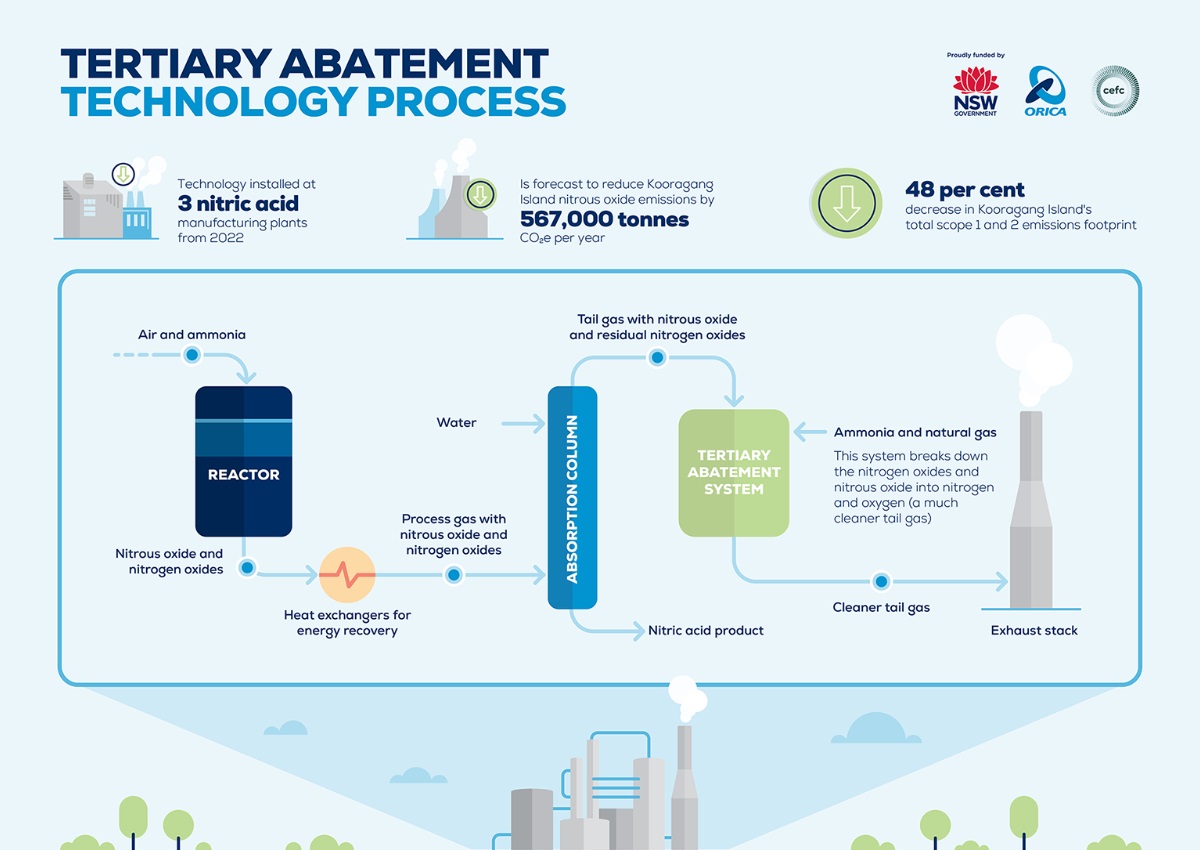
New NSW Frog Species 'Hopping' Into Protection
.jpg?timestamp=1636656869806)
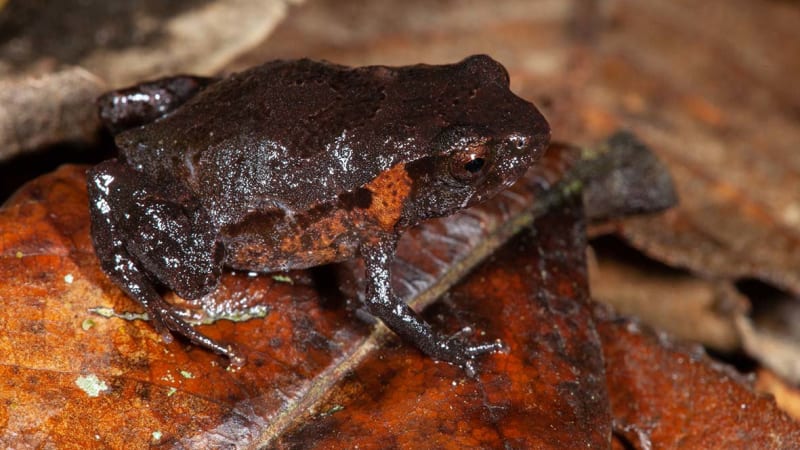
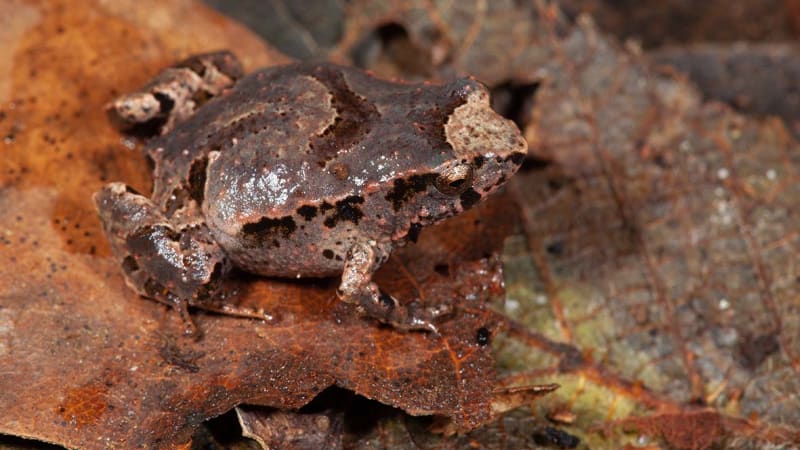
Fine Issued For Emissions From Liddell Power Station
Fines For Coal Mine For Dirty Water Discharge: Whitehaven's Tarrawonga Coal Mine
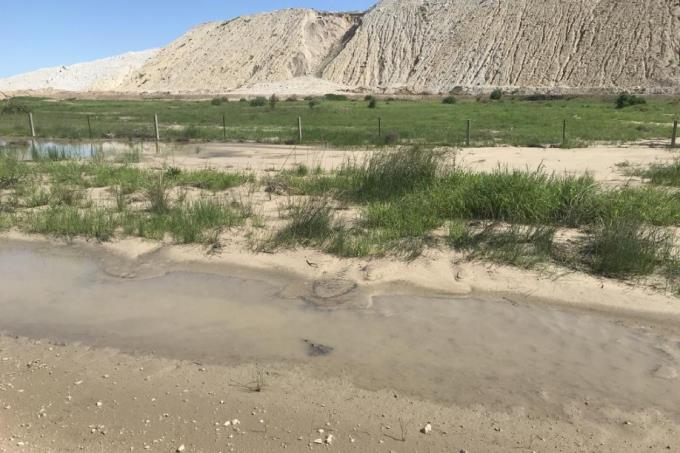 Whitehaven’s Tarrawonga Coal Mine has been fined and ordered to do an environmental audit after it allegedly discharged dirty water from a failed sediment dam at its mine near Boggabri, in north western NSW.
Whitehaven’s Tarrawonga Coal Mine has been fined and ordered to do an environmental audit after it allegedly discharged dirty water from a failed sediment dam at its mine near Boggabri, in north western NSW.$40 Million Clean Technology Grants Open
- electrification and energy systems
- primary industry and land management
- powerfuels, including hydrogen.
Green Hydrogen Feasibility Study Positions Port Of Newcastle To Drive A More Diverse Hunter Economy
NSW Government Plan To Revitalise Peat Island And Mooney Mooney Released
- Nearly 270 new homes at Mooney Mooney to deliver more housing supply,
- Retention of nine unlisted historical buildings on the island, and four on the mainland, to be restored and used for new community and commercial opportunities,
- New retail and café or restaurant opportunities,
- Approximately 9.65 hectares of open space, including opportunities for walking and cycling tracks, parklands and recreational facilities,
- Retention of the chapel and surrounding land for community use, and
- 10.4 hectares of bushland dedicated as a conservation area.
Grattan on Friday: Scott Morrison has a bingle or two on the campaign trail
Michelle Grattan, University of CanberraIt seemed remarkable chutzpah that Scott Morrison, back from Glasgow where Australia remains a criticised laggard despite its embrace of a 2050 target, would hit the trail to campaign on climate policy.
Alternatively, as some suggest, perhaps the prime minister just wanted to tick that box early, before moving onto more congenial issues.
Either way, it didn’t turn out well.
His policy to promote electric cars, which contained minimal substance, backfired. And he wedged himself with a too-smart-by-half attempt to wedge Labor on carbon capture and storage.
Morrison surely must have seen the dangers of exposing himself on electric cars, after all he’d said in denouncing Bill Shorten’s policy in 2019.
The quotes from then were grenades for the throwing. Shorten wanted to end the Aussie weekend, Morrison declared; such a vehicle “won’t tow your trailer. It’s not going to tow your boat. It’s not going to get you out to your favourite camping spot with your family.”
How did Morrison believe he could execute a turnaround in the harsh political spotlight without being called to account? Especially when his political honesty is under the most intense questioning.
Sean Kelly, columnist and former staffer for Julia Gillard and Kevin Rudd, writes in his just-published The Game: A Portrait of Scott Morrison that the PM, “never feels, in himself, insincere or untruthful, because he always means exactly what he says; it is just that he means it only in the moment he is saying it. Past and future disappear.”
Unfortunately for Morrison, the electronic clips don’t disappear. Those on electric cars were there to be played again and again.
Read more: Scott Morrison spruiks electric vehicles – but rules out subsidies and an end-date for petrol cars
Morrison himself explained his about-face by claiming it was a “Labor lie” that he had campaigned against EVs in 2019. “I didn’t. […] I was against Bill Shorten’s mandate policy, trying to tell people what to do with their lives, what cars they were supposed to drive and where they could drive.”
There was another problem with Morrison’s decision to climb into a hydrogen-fuelled car during his first visit to Melbourne in a very long time.
His policy – $178 million for charging and refuelling infrastructure and the like – lacked substance. It had no subsidies, with the government claiming they would not be a good use of taxpayers’ money.
Within hours of the announcement, a devastating critique of the policy came from his own side of politics, delivered by NSW Environment Minister Matt Kean.
Speaking to ABC 7.30, Kean contrasted Morrison’s weak policy with NSW’s robust approach and spelled out how Morrison should be acting.
“I would encourage the federal government to be looking at doing things like providing direct support for people who want to purchase an EV. There are a range of taxes and charges that could be waived,” Kean said.
“We want to see things like the federal government investing more heavily in electric vehicle charging infrastructure. The funding that they’ve put on the table doesn’t even match the funding that we’ve put here just for the state of New South Wales.
"But the biggest thing the federal government can do is deal with the issue of fuel standards. Australia has some of the worst fuel standards anywhere in the world”, which meant it “is becoming the dumping ground for the vehicles the rest of the world doesn’t want”.
The NSW government is forward-leaning on climate issues, and Kean and Morrison have some interesting history. The PM sledged him spectacularly last year after Kean said “some of the most senior members” of the Morrison government were concerned about its climate change policies.
Read more: Morrison to link $500 million for new technologies to easing way for carbon capture and storage
In one of those “in the moment” prime ministerial statements, Morrison responded that Kean “doesn’t know what he’s talking about” and declared “most of the federal cabinet wouldn’t even know who Matt Kean was”.
They certainly know now. Kean is treasurer as well as environment minister in the Perrottet government, and that government is willing to chivvy the Feds when it feels like it.
In another climate announcement this week, Morrison said the government would contribute $500 million for a new $1 billion fund, administered by the Clean Energy Finance Corporation, to help small companies commercialise low-emissions technology.
The legislation will contain a provision widening the remit of the CEFC to allow it to invest in carbon capture and storage, which it is banned from doing at present.
Labor has consistently opposed such a widening, so the government briefed that this would put pressure on the opposition. But Labor took one look at the trap and seems determined to avoid it. It indicated it might support the change, given the $500 million would be “new money” for the CEFC rather than a redirection of existing funds. In the meantime, a couple of renegade Queensland Coalition senators, Matt Canavan and Gerard Rennick, flagged they’d vote against the fund.
More generally, Morrison this week sharpened the Coalition-Labor contrast he has set up on climate policy, between a government that encourages and supports and an opposition that would regulate and tax.
He encapsulated his desired dichotomy by saying that “we believe climate change will ultimately be solved by ‘can do’ capitalism, not ‘don’t do’ governments seeking to control people’s lives and tell them what to do, with interventionist regulation and taxes that just force up your cost of living and force businesses to close”.
Indeed, he seeks to use the contrast broadly. “I think that’s a good motto for us to follow not just in this area, but right across the spectrum of economic policy in this country,” he told a business audience. “We’ve got a bit used to governments telling us what to do over the last couple of years. I think we have to break that habit.”
This reverts to Liberal Party “free enterprise” ideology, which has had to take a battering in the pandemic as the government spent wildly to keep things afloat. It also taps into the post-lockdown sentiment of those exhausted by restrictions and orders and welcoming “freedom” again.
But in terms of climate policy, the reality is far from so simple.
Read more: Book review: Sean Kelly's The Game: A Portrait of Scott Morrison
The point has been made many times that “taxes” – taxpayers’ money – are financing the multiple billions the Morrison government has committed to encouraging “capitalist” solutions.
While expounding “can do capitalism”, the government is in fact pursuing an interventionist approach by putting all its eggs in the technology-support basket and not enough in the market-creation one.
“Scotty from Marketing” likes slogans, but “can do capitalism” doesn’t ring like one with a future. “Capitalism” works as an economic system (with more than a little help from governments), but it is beyond clunky as part of a sound bite.![]()
Michelle Grattan, Professorial Fellow, University of Canberra
This article is republished from The Conversation under a Creative Commons license. Read the original article.
White sharks can easily mistake swimmers or surfers for seals. Our research aims to reduce the risk
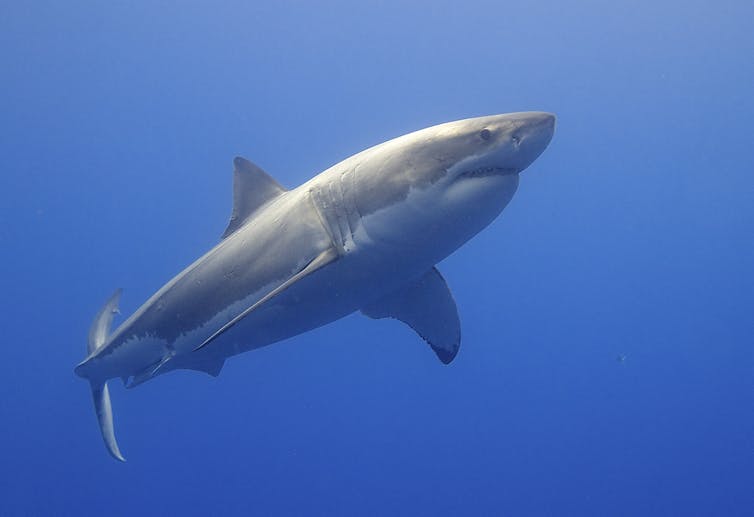
The presumed death of 57-year-old Paul Millachip in an apparently fatal shark bite incident near Perth on November 6 is a traumatising reminder that while shark bites are rare, they can have tragic consequences.
Despite the understandably huge media attention these incidents generate, there has been little scientific insight into how and why they happen.
Sharks in general, and white sharks in particular, have long been described as “mindless killers” and “man-eaters”.
But our recent research confirms that some bites on humans may be the result of mistaken identity, whereby the sharks mistake humans for their natural prey based on visual similarities.
Sharks have an impressive array of senses, but vision is thought to be particularly important for prey detection in white sharks. For example, they can attack seal-shaped decoys at the surface of the water even though these decoys lack other sensory cues such as scent.
The visual world of a white shark varies substantially from that of our own. White sharks are likely colourblind and rely on brightness, essentially experiencing their world in shades of grey. Their eyesight is also much less acute than ours – in fact, it’s probably more akin to the blurry images a human would see underwater without a mask or goggles.
The Mistaken Identity Theory
Bites on surfers have often been explained by the fact that, seen from underneath, a paddling surfer looks a lot like a seal. But this presumed similarity has only previously been assessed based on human vision, using underwater photographs to compare their silhouettes.
Recent developments in our understanding of sharks’ vision have now made it possible to examine the mistaken identity theory from the shark’s perspective, using a virtual system that generates “shark’s-eye” images.
In our study, published last month, we and our colleagues in Australia, South Africa and the United Kingdom compared video footage of seals and of humans swimming and paddling surfboards, to predict what a young white shark sees when looking up from below.
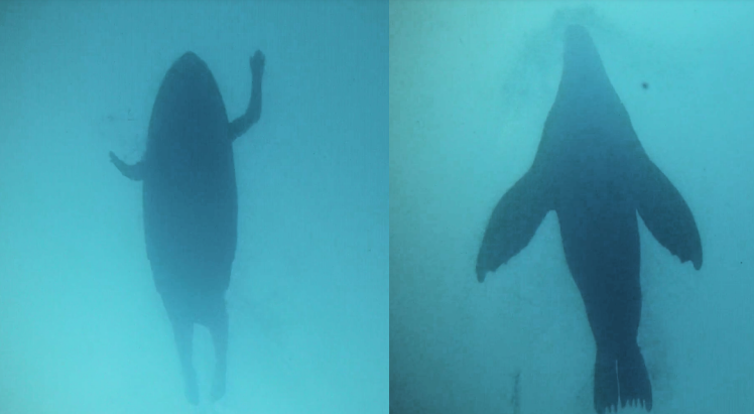
We specifically studied juvenile white sharks – between of 2m and 2.5m in length – because data from New South Wales suggests they are more common in the surf zone and are disproportionately involved in bites on humans. This might be because juvenile sharks are more likely to make mistakes as they switch to hunting larger prey such as seals.
Our results showed it was impossible for the virtual visual system to distinguish swimming or paddling humans from seals. This suggests both activities pose a risk, and that the greater occurrence of bites on surfers might be linked to the times and locations of when and where people surf.
Our analysis suggests the “mistaken identity” theory is indeed plausible, from a visual perspective at least. But sharks can also detect prey using other sensory systems, such as smell, sound, touch and detection of electrical fields.
Read more: Why do shark bites seem to be more deadly in Australia than elsewhere?
While it seems unlikely every bite on a human by a white shark is a case of mistaken identity, it is certainly a possibility in cases where the human is on the surface and the shark approaches from below.
However, the mistaken identity theory cannot explain all shark bites and other factors, such as curiosity, hunger or aggression are likely to also explains some shark bites.
Can This Knowledge Help Protect Us?
As summer arrives and COVID restrictions lift, more Australians will head to the beach over the coming months, increasing the chances they might come into close proximity with a shark. Often, people may not even realise a shark is close by. But the past weekend gave us a reminder that shark encounters can also tragically result in serious injury or death.
Understanding why shark bites happen is a good first step towards helping reduce the risk. Our research has inspired the design of non-invasive, vision-based shark mitigation devices that are currently being tested, and which change the shape of the silhouette.
We still have a lot to learn about how sharks experience their world, and therefore what measures will most effectively reduce the risks of a shark bite. There is a plethora of devices being developed or commercially available, but only a few of them have been scientifically tested, and even fewer – such as the devices made by Ocean Guardian that create an electrical field to ward off sharks – have been found to genuinely reduce the risk of being bitten.![]()
Laura Ryan, Postdoctoral Researcher, Department of Biological Sciences, Macquarie University and Charlie Huveneers, Associate professor, Flinders University
This article is republished from The Conversation under a Creative Commons license. Read the original article.
The ‘Ringo Starr’ of birds is now endangered – here’s how we can still save our drum-playing palm cockatoos
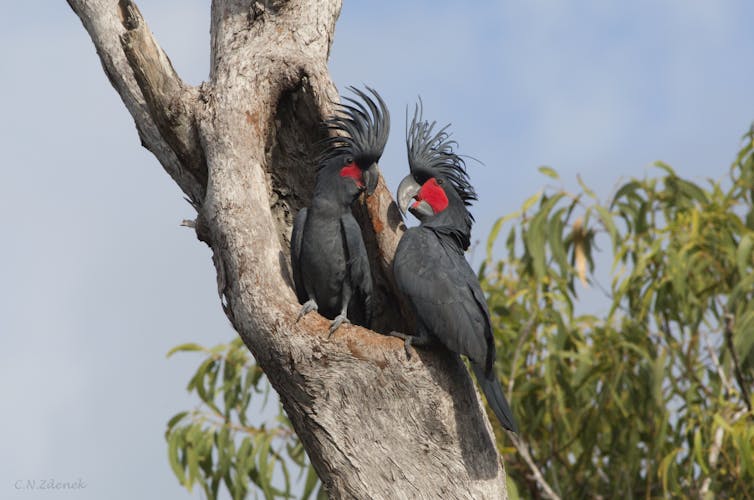
Environmental scientists see flora, fauna and phenomena the rest of us rarely do. In this series, we’ve invited them to share their unique photos from the field.
Australia’s largest parrot, the palm cockatoo, is justifiably famous as the only non-human animal to craft tools for sound. They create drumsticks to make a rhythmic beat. Sadly, the “Ringo Starr” of the bird world is now threatened with extinction – just as many other parrots are around the world.
This week, the Queensland government moved this species – also known as the goliath cockatoo – onto the endangered list, due to our research on palm cockatoo populations over more than 20 years.
Our analysis predicts a severe decline from 47% to as high as 95% over the next half-century. Given the current population is estimated at just 3,000 birds, it is likely to drop to as low as 150 birds. They could all but disappear from Australia in our lifetimes.
Is it too late? Not yet. There are concrete ways to protect these magnificent, elusive birds by conserving habitat and their all-important breeding hollow trees, by reintroducing cool burns (including unburnt areas), and finding out more about these special parrots.
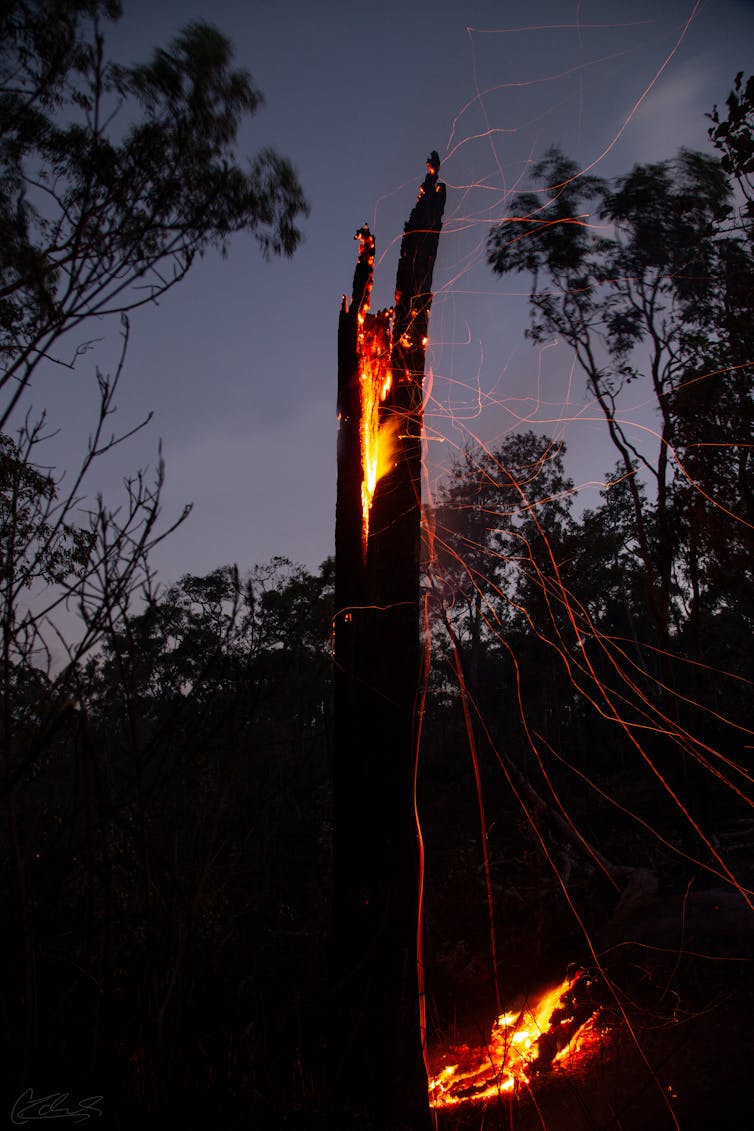
So Why Are Palm Cockatoos In Trouble?
Palmies, as we call these charismatic birds, hail from an ancient lineage on the parrot evolutionary tree. In Australia they only live on the Cape York Peninsula in far north Queensland, where they face a perfect storm of threats and vulnerability.
They’re losing habitat due to poor fire management and ongoing land-clearing, but they also have extremely low breeding rates, with females laying a single egg every two years.
Of the offspring, only 23% of their chicks live until they fledge. On average, this means each breeding pair successfully raises just one chick every 10 years. And who knows if that fledgling will make it to sexual maturity at five or more years old?
Read more: Bird-brained and brilliant: Australia's avians are smarter than you think
One challenge in studying these birds is the difficulty in identifying individual birds over time. To date there has been no successful capture of palmies to mark them via leg bands or GPS trackers. Without knowing who’s who, major problems with breeding success could be masked by an ageing population, given their life expectancy is up to 60 years.
Our research on palm cockatoo genetics and vocal dialects reveals their three major populations on the peninsula are poorly connected, meaning little movement of birds between groups.
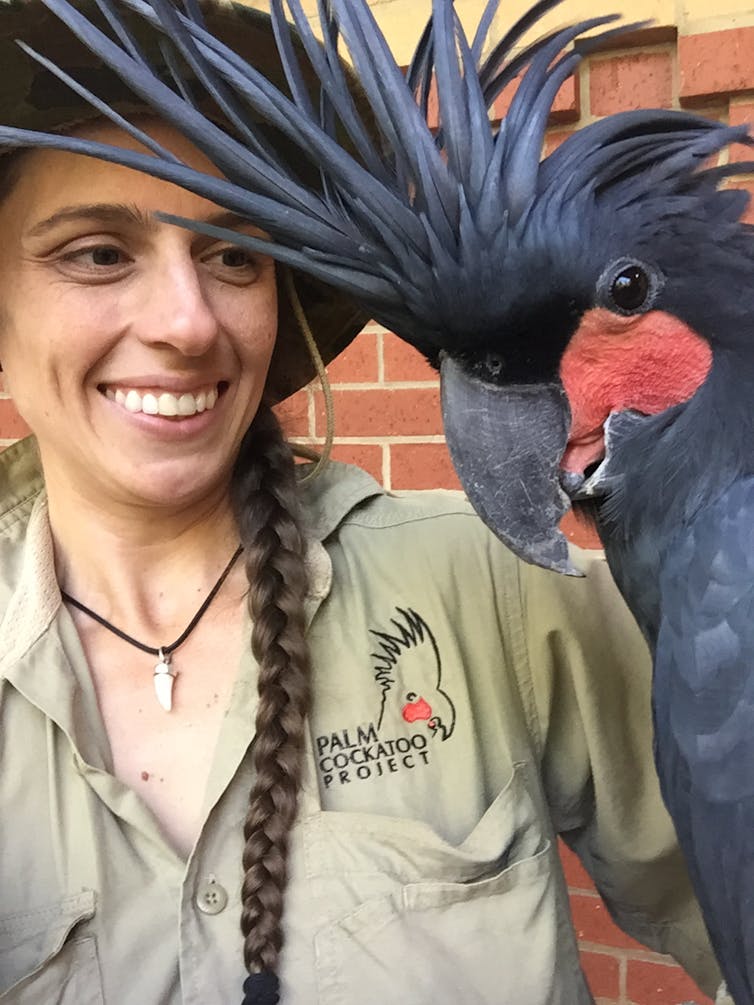
Each group has developed “cultural” traits which have not spread between the populations. For example, the famous drumming display mainly occurs in the eastern population, where the birds also make distinctive calls including a unique human-like “hello”.
The downside is that if one population is in trouble, the others are unable to pick up the slack and provide breeding reinforcements.
How Do We Save Them?
Palmies are in real trouble. Saving them from extinction will take a concerted effort.
We urgently need a better understanding of why they have such trouble breeding, to figure out if it’s similarly bad across all three populations, and to work out how palmies use the landscape.
At the same time, we have to get better at managing the landscape they need to survive. What does that look like? It means cool burns to prevent extreme bushfires burning down their ancient nesting trees – plus avoiding any further felling of these priceless trees.
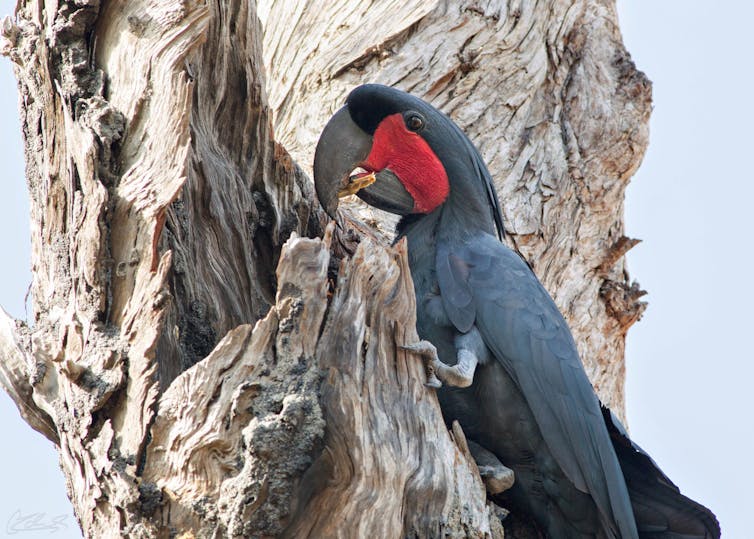
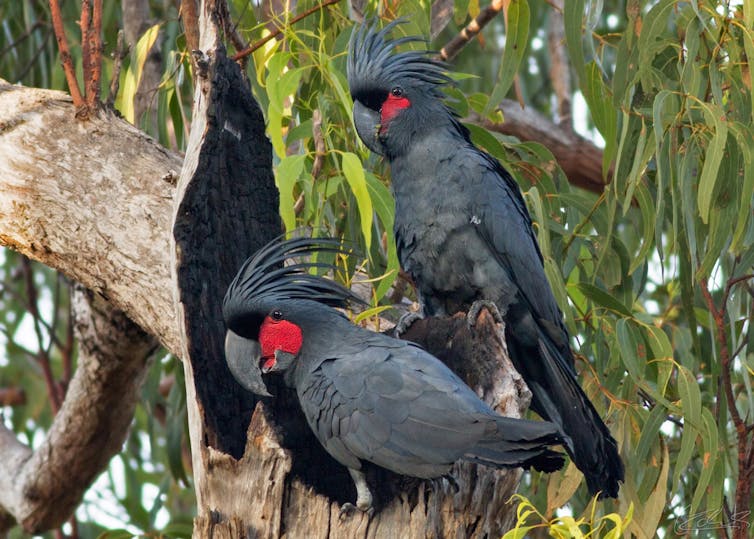
These trees are a key part of the puzzle. Palmies are picky breeders. For these birds, not just any tree hollow will do. They require large, old hollow-bearing trees to breed in, which can be up to 300 years old.
The hollowing process typically starts with a small burn at the base, giving termites access to the insides of the trunk. Eventually, these trees resemble vertical hollow pipes. The palmies then spend months splintering sticks and bringing them to the hollow to make a nesting platform up to a metre deep – the only parrot to do in the entire world.
Unfortunately, these “piped” trees are especially vulnerable to big fires, which also lower termite populations and reduce the chances of future hollows being formed.
Protecting Their Habitat
We’ve found using a brush cutter and rake to clear the grass and debris for three metres around nesting trees is enough to save them from fires. This is of course labour intensive.
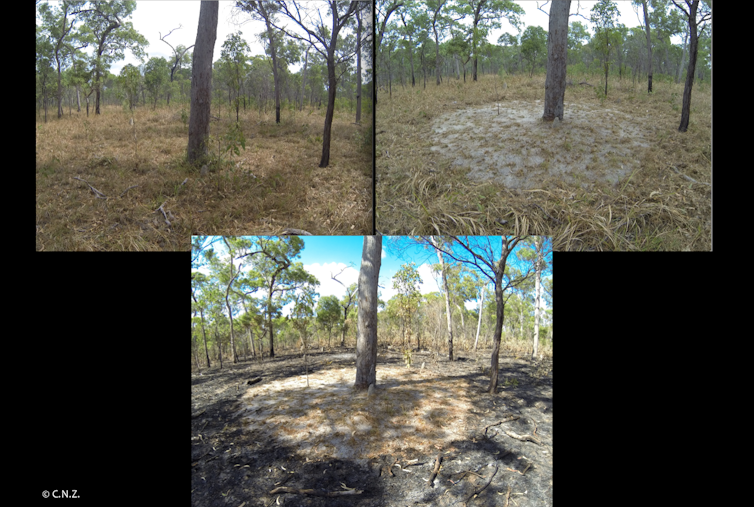
A longer-term strategy is to manage fire better. The frequency and intensity of bushfires in tropical Australia has changed for the worse since Europeans started managing the landscape. A return to the traditional cool burns employed by indigenous people from the Uutaalnganu, Kanthanampu and Kuuku Ya’u language groups could largely resolve this problem.
Land clearing also reduces habitat. Though long saved by distance, Cape York is now seeing strip-mining, road building, and quarrying, which all contribute to habitat loss. We can reduce the damage done if skilled ecologists survey proposed clearance areas ahead of time.
Another vital step towards keeping this species alive is to broadly assess and protect as much as possible of the remaining palm cockatoo breeding habitat on Cape York.
We also need better ways of detecting their nest hollows. We’ve researched these birds for over two decades, and can confidently say that birds don’t come any harder to study than palmies.
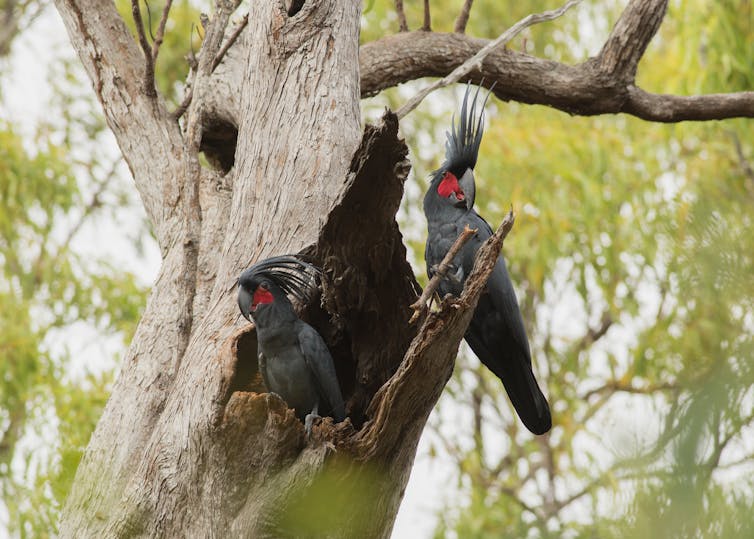
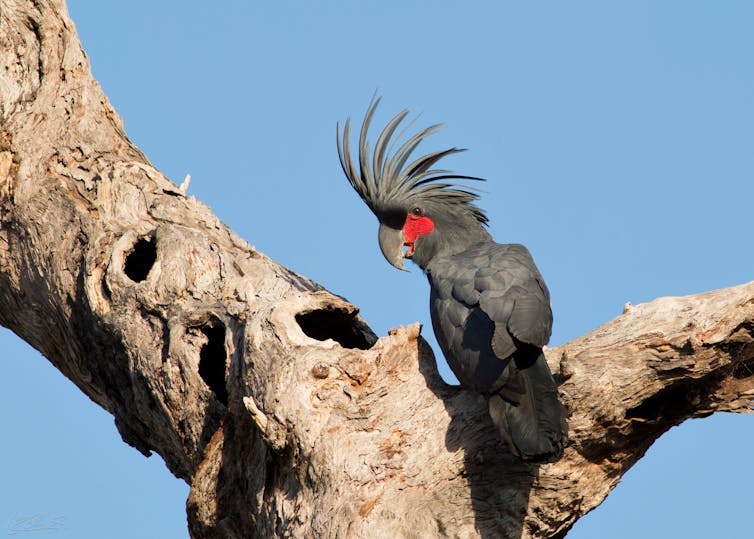
Hunting for their nests is time consuming and expensive because palmies can lay their egg any day in an eight month breeding season, with pairs often switching among several hollows on their territories. This spreads our survey teams thin.
We’ve also found that palmies go quiet during nesting and are super wary of humans, making finding their nesting hollows especially difficult.
Despite all the challenges in saving them, it is worthwhile. Even after watching them for 20 years, we have not tired of their company. They’re magnificent birds with unique behaviour and a surprising number of parallels with humans, such as drumming, blushing, tool-making, and their “Hello” call.
To bring them back from the edge, we must work quickly to figure out why and where their breeding survival rates are so low, improve how we use fire, and protect their habitat and the all-important old trees.![]()
Christina N. Zdenek, Lab Manager/Post-doc at the Venom Evolution Lab, The University of Queensland and Rob Heinsohn, Professor of Evolutionary and Conservation Biology, Australian National University
This article is republished from The Conversation under a Creative Commons license. Read the original article.
Morrison to link $500 million for new technologies to easing way for carbon capture and storage

Prime Minister Scott Morrison will on Wednesday announce $500 million towards a new $1 billion fund to promote investment in Australian companies to develop low-emissions technologies.
But the government will use the legislation for the fund to try to wedge Labor.
The $500 million will be provided to the Clean Energy Finance Corporation, with the legislative package including the expansion of the remit of the CEFC to enable it to invest in carbon capture and storage (CCS).
The CEFC can invest in a broad range of low-emissions technologies, with the only exceptions being nuclear and CCS. The government has previously tried to remove the barrier to the CEFC investing in CCS but has been frustrated by the Senate.
By linking the $500 million to the expansion of the CEFC’s investment remit, the government believes it will put pressure on Labor, which opposed the wider brief for the corporation.
While the government’s legislation would remove the prohibition relating to CCS, there would be no change to the nuclear prohibition.
The government regards CCS, which is controversial and as yet unproven at scale, as a priority technology under its Technology Investment Roadmap.
The proposed fund is the latest in a round of announcements this week as Morrison campaigns on his technology-based energy policy for net-zero by 2050.
But Tuesday’s unveiling of his policy to encourage the take-up of electric vehicles – with $178 million for modest initiatives but no subsidies to assist purchasers – ran into immediate flak, with strong criticisms from experts and the opposition, who said it was totally inadequate.
NSW Environment Minister Matt Kean made it clear the Morrison government should be doing a great deal more.
He said he would like to see it directly support electric vehicles so they would be cheaper for families and businesses. A number of taxes and charges could be waived.
The federal government should also invest more heavily in in electric vehicle charging infrastructure, he told the ABC on Tuesday night.
But Kean said the biggest thing the federal government could do was deal with the issue of fuel standards – Australia had some of the worst fuel standards in the world, worse than China or India.
NSW on Wednesday will announce support for the fleet industry to purchase electric vehicles.
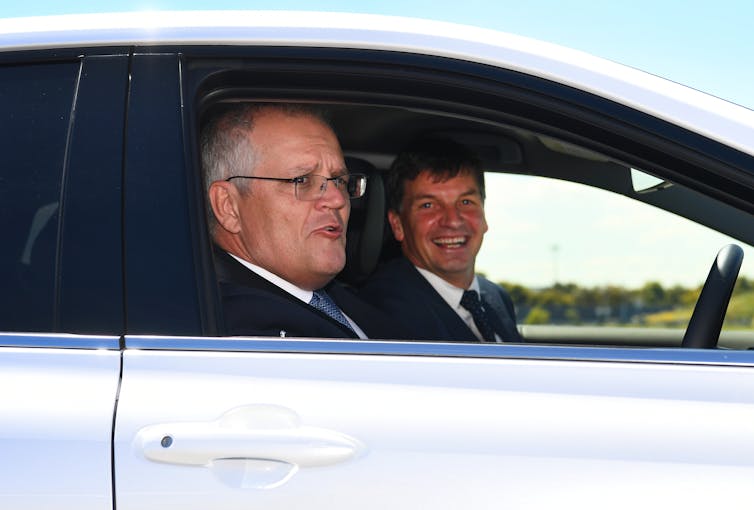
At a news conference on Tuesday Morrison was confronted by reporters over his 2019 trenchant attacks on Labor’s electric vehicle policy, which he said would “end the weekend”. Despite the quotes, Morrison denied he had campaigned against EVs at the election.
“I didn’t. That is just a Labor lie. I was against Bill Shorten’s mandate policy, trying to tell people what to do with their lives, what cars they were supposed to drive and where they could drive.”
The proposed “low emissions technology commercialisation fund” would include $500 million from private sector investors.
Morrison says in a statement the fund would back Australian early stage companies to develop new technologies.
Emissions reduction minister Angus Taylor says it would “address a gap in the Australian market, where currently small, complex, technology-focussed start-ups can be considered to be too risky to finance”.
The investments would be in the form of equity, not grants or loans.
The latest initiative brings the government’s public investment commitments to low emissions technologies by 2030 to more than $21 billion.
The government will introduce legislation to establish the fund – expected to earn a positive return for taxpayers – in this term of parliament.
The government’s list of example of potential areas for the fund’s investments include:![]()
- direct air capture of CO₂ and permanent storage underground
- materials or techniques with the potential to reduce emissions in the production in steel and aluminium
- soil carbon measurement technologies
- livestock feed technologies to reduce methane emissions from cattle
- improvements to solar panels
- lighter and smaller battery cases
- software developments to improve the operational efficiency of a variety of low-emissions technologies in all sectors of the economy.
Michelle Grattan, Professorial Fellow, University of Canberra
This article is republished from The Conversation under a Creative Commons license. Read the original article.
As the world surges ahead on electric vehicle policy, the Morrison government’s new strategy leaves Australia idling in the garage
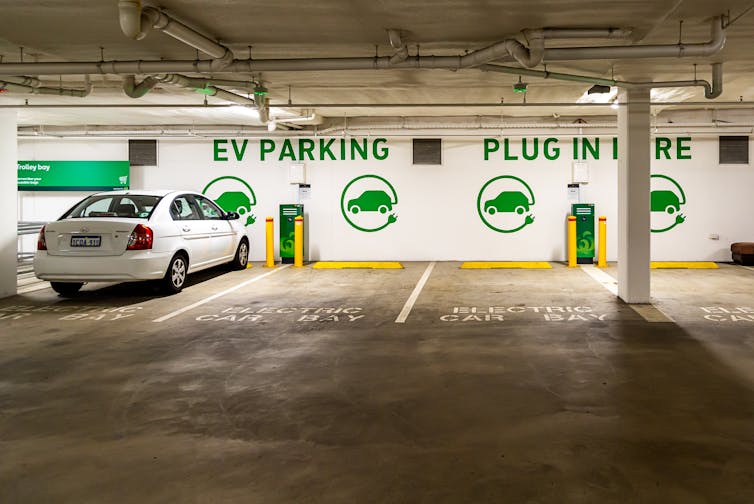
The Morrison government will today announce its long-awaited electric vehicle strategy, coinciding with COP26 climate change talks underway in Glasgow. The new policy contains some welcome new funding, but is largely notable for what it omits.
In a welcome move, the government has allocated an additional A$250 million for electric vehicles, primarily aimed at charging infrastructure. But unlike every leading electric vehicle market globally, the plan delivers no financial or tax support to help Australian motorists make the switch to a cleaner car.
And the government has failed to explain how the policy will help Australia achieve net-zero emissions by 2050, just as it failed to do when releasing its economy-wide emissions reduction plan last month.
It’s encouraging to see the Morrison government move past its claim of a few years ago that electric vehicles would “end the weekend”. But the new plan is not the national electric vehicle strategy Australia deserves, and badly needs.
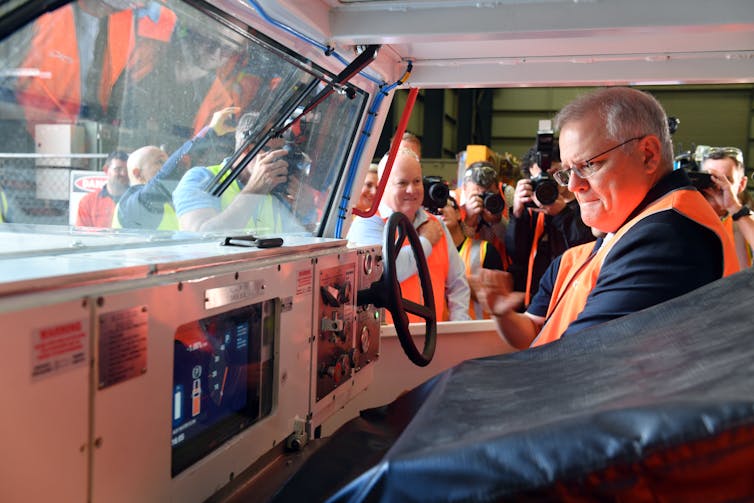
Falling Short
Transport produces almost 20% of Australia’s greenhouse gas emissions – 60% of which is from cars. And the rate of transport emissions is fast increasing.
The government says the policy, titled the Future Fuels and Vehicles Strategy, will lead to 30% of all new car sales being electric by 2030 – which would mean 1.7 million electric cars on Australian roads.
But in 2019, government modelling predicted electric vehicles would comprise 27% of new sales by 2030. So the new measures announced will lead only to a 3% increase in what would have happened anyway.
At COP26 last week, Australia signed a global agreement to make electric vehicles the “new normal” by 2030. One in three cars being electric vehicles hardly meets this goal.
Most concerningly, the government’s plan is inconsistent with global targets to achieve net zero emissions by 2050. The United States, for example, is aiming for at least 50% electric vehicle sales by 2030.
Oddly, it appears the government would prefer Australian motorists remain dependent on expensive, foreign fuel for transport. Its investment in July of $260 million to increase diesel reserves – notably more than the new electric vehicle funding – supports this theory.
Read more: Clean, green machines: the truth about electric vehicle emissions
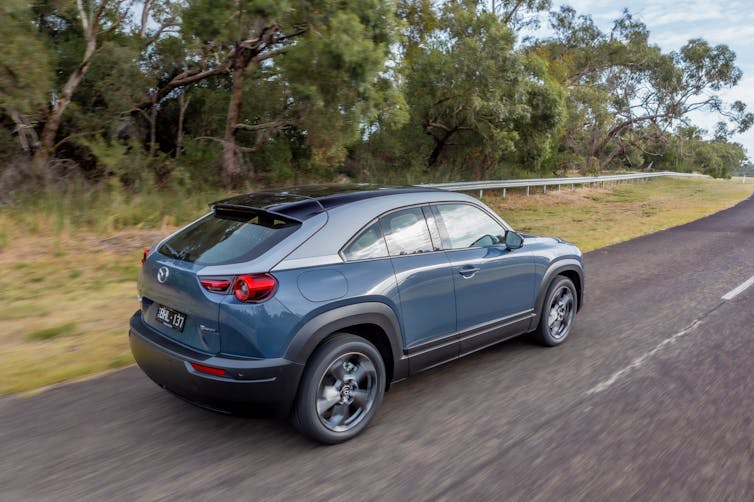
Australia’s Token Effort
Globally, about 5% of all new cars sold are electric and this is rapidly increasing. Yet in Australia, the figure is about 1%.
So what measures does the new strategy contain to shift the needle? In two words, not much. It includes:
$250 million to support public charging infrastructure, fleet infrastructure, vehicle trials and smart charging infrastructure in households
continued low-interest financing support for fleets via the Clean Energy Finance Corporation
an overdue update to the Green Vehicle Guide.
It’s better than nothing. But the government has claimed electric vehicles will deliver around 15% of national emission reductions required by 2050. It’s hard to see how the measures released today will get us there.
The government has also claimed high international demand for electric vehicles could constrain global supply and slow deployment in Australia.
But as carmakers have pointed out, they have little reason to send new, cheaper electric models to Australia because it lacks the policies to stimulate electric vehicle demand.
Read more: The US jumps on board the electric vehicle revolution, leaving Australia in the dust
The Plan Australia Deserves
The Morrison government must go back to the drawing board and produce a national electric vehicle strategy consistent with global climate efforts.
That would mean aiming for at least half of new car sales being electric by 2030, and 100% by 2035. This translates to about one million electric vehicles sold in Australia by 2027 and at least 2.5 million by 2030.
It’s a massive increase from the 30,000 or so electric vehicles sold over the past five years, and at least 50% higher than what’s forecast under today’s strategy.
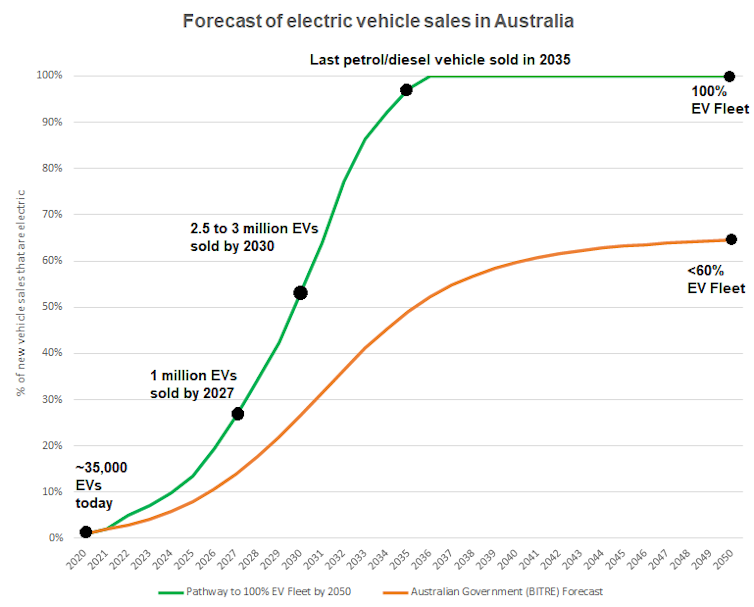
Australia can learn much from overseas jurisdictions on how to boost electric vehicle sales. Until electric vehicle targets are met, the following state and federal policies are needed:
increase supply by introducing a national sales mandate for electric vehicles, and penalise manufacturers that don’t meet them
reduce upfront costs by making electric vehicles exempt from GST, stamp duty and registration fees (as is done in Norway)
support fleet adoption by making electric vehicles exempt from fringe benefits tax
fund infrastructure by committing to support the rollout of 100,000 public charging points by 2027 (in line with the European Union’s target).
Penalise states that go it alone on taxing electric vehicle usage. Instead, focus on road charges that address Australia’s multi-billion dollar city congestion problem rather than unfairly taxing rural and regional electric vehicle drivers due to the longer distances they have to drive.
Read more: Here's why electric cars have plenty of grunt, oomph and torque

Why Australia Must Act
The benefits of electric vehicles go far beyond tackling climate change.
We estimate Australians spend more than $30 billion each year on imported fuel. This alone should be enough to spur governments to support electric vehicle adoption and keep this money in Australia.
Recent analysis by the Australian Conservation Foundation also found maintaining the current approach to transport emissions could cost Australia up to $865 billion between 2022 and 2050.
Aside from greenhouse gas emissions, the costs were attributed to air, noise and water pollution. But better zero-emission transport policies could enable Australia to reduce these costs by up to $492 billion.
Clearly, electric vehicles deliver a net economic benefit, even after accounting for the cost of incentives and loss of fuel tax revenue.
As the rest of the world charges ahead, the Morrison government’s new strategy looks ever more foolish.
Read more: Wrong way, go back: a proposed new tax on electric vehicles is a bad idea ![]()
Jake Whitehead, Tritum E-Mobility Fellow & Advance Queensland Industry Research Fellow, The University of Queensland; Jessica Whitehead, Industry Fellow, The University of Queensland, and Kai Li Lim, St Baker E-Mobility Fellow, The University of Queensland
This article is republished from The Conversation under a Creative Commons license. Read the original article.
Scott Morrison spruiks electric vehicles – but rules out subsidies and an end-date for petrol cars
Michelle Grattan, University of CanberraAfter demonising Labor’s policy on electric cars before the 2019 election, the federal government has put electric vehicles at the centre of a new “Future Fuels and Vehicles Strategy” to be released by Prime Minister Scott Morrison on Tuesday.
The policy puts another A$178 million into the government’s future fuels fund, bringing it to $250 million, for investment to encourage low emission vehicles.
The expanded fund will focus on four areas of investment: public electric vehicle charging and hydrogen refuelling infrastructure; heavy and long-distance vehicle technologies; commercial fleets, and household smart charging.
The government estimates its strategy will result in more than $500 million combined private and public co-investment for the uptake of future fuels and involve the creation of more than 2600 new jobs.
But the policy is minimalist, ruling out consumer subsidies and concessions or mandating a phase out of new petrol and diesel-powered vehicles.
In 2019 Morrison was scathing about the ALP electric vehicle policy – which set a target of 50% of all new car sales being electric vehicles by 2030.
While saying the government didn’t have a problem with electric vehicles per se, Morrison in 2019 claimed “Bill Shorten wants to end the weekend when it comes to his policy on electric vehicles where you’ve got Australians who love being out there in their four-wheel drives”.
Read more: COP26: here's what it would take to end coal power worldwide

Morrison says in his Tuesday announcement with emissions reduction minister Angus Taylor, “Australians love their family sedan, farmers rely on their trusted ute and our economy counts on trucks and trains to deliver goods from coast to coast.
"We will not be forcing Australians out of the car they want to drive or penalising those who can least afford it through bans or taxes. Instead, the strategy will work to drive down the cost of low and zero emission vehicles, and enhance consumer choice.
"We will do this by creating the right environment for industry co-investment.”
Sales of new technology vehicles are increasing quickly: battery electric and plug-in hybrid vehicles were a record 8,688 sales in the first half of this year, representing 1.57% of the total light vehicle market. This compared to 6,900 in 2020.
But the rise is coming off a low base. About 1% of new vehicles sold in Australia are electric – which lags behind the global average of 5%.
The government policy says by 2030 battery electric and plug-in hybrid electric vehicles are projected to make up 30% of annual new passenger and light commercial vehicle sales. This would translate into more than 1.7 million battery electric and plug-in vehicles on Australian roads by 2030.
The government says it will promote and bring forward priority market reforms to state and territory ministers “to ensure the electricity grid is EV-ready”.
The additional electric vehicle uptake enabled by the new investment will reduce greenhouse gas emissions by 8 million tonnes by 2035, the government says.
Labor’s electric vehicle policy, released earlier this year, promised to deliver a discount to cut the cost of non-luxury electric cars. It would cost about $200 million over three years.
Read more: Scott Morrison is hiding behind future technologies, when we should just deploy what already exists
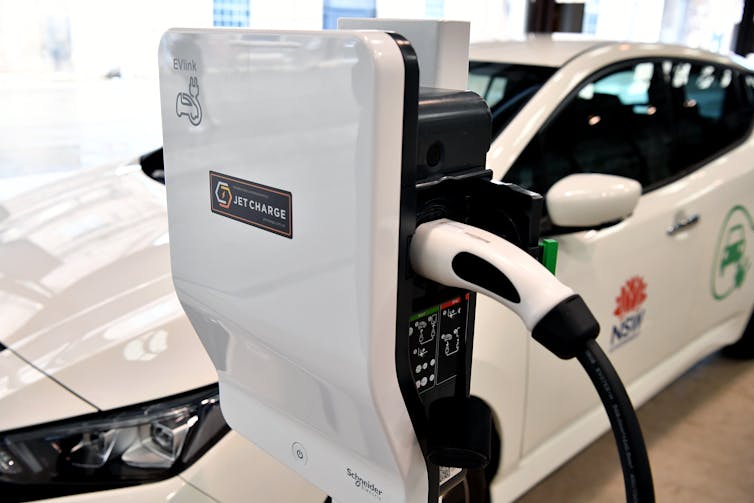
The government says during consultation for the new strategy, there were calls for subsidies or tax concessions to reduce the price difference between conventional and low emission vehicles.
But, it argues, “reducing the total cost of ownership through subsidies would not represent value for the taxpayer, particularly as industry is rapidly working through technological developments to make battery electric vehicles cheaper.
"The Australian Taxation Office will investigate issuing updated guidance for businesses on the tax measures of low emission vehicles to provide clarity for fleet purchasing.”
The government’s position on subsidies is at odds with industry experts, who say the measure is important to encourage motorists to make the switch to clean vehicles.
An exclusive poll of 62 of Australia’s preeminent economists, published by The Conversation in June, found they overwhelmingly backed subsidies for all-electric vehicles and for public charging stations.
The majority also backed setting a date to ban the import of traditionally-powered cars – a move adopted by many other nations including China, the United Kingdom and France.
Back from Glasgow and out on the campaign trail this week, Morrison is promoting aspects of his net zero by 2050 technology policy. On Monday he was in Newcastle announcing a $1.5 million grant through the Australian Renewable Energy Agency (ARENA) as part of a study to assess the feasibility of a green hydrogen hub at the Port of Newcastle.![]()
Michelle Grattan, Professorial Fellow, University of Canberra
This article is republished from The Conversation under a Creative Commons license. Read the original article.
COP26: cities create over 70% of energy-related emissions. Here’s what must change

Cities are responsible for 71-76% of energy-related CO₂ emissions. Today, the United Nations climate summit in Glasgow will convene to discuss this urgent global problem.
Carbon emissions in cities are generated through activities including the construction and operation of buildings, manufacture of building materials such as steel and concrete, and through the movement of people, goods and services.
The sector has been described as the “sleeping giant” of carbon emissions. This includes Australia, where a pre-COVID forecast estimated the population will reach 30 million by 2029 – requiring many more buildings to be constructed this decade and beyond.
Over the next 30 years, lifecycle emissions associated with new homes in Australia are expected to exceed the federal government’s economy-wide net-zero emissions targets. Where we locate new buildings and how they’re built is crucial to reducing emissions and managing our exposure to the impacts of climate change.
Australia’s cities are predominantly coastal, but development is underway in areas we know will face sea level rise. Homes and suburbs are not being built to withstand heatwaves and other climate change threats.
We must take significant and rapid action now to ensure cities play their part in limiting dangerous global warming, so they can cope with the climate challenges ahead.
Read more: The Great Australian Dream? New homes in planned estates may not be built to withstand heatwaves
What’s Happening At COP26?
At COP26 today, national, regional, local governments and the private sector will come together to work towards a zero-emission built environment.
A coalition known as #BuildingToCOP26 aims to halve the built environment’s emissions by 2030. Ahead of COP26, it outlined three goals for the sector. They cover targets to decarbonise buildings, committing to the United Nations’ Race to Zero campaign and adopting shared goals for emissions reductions.
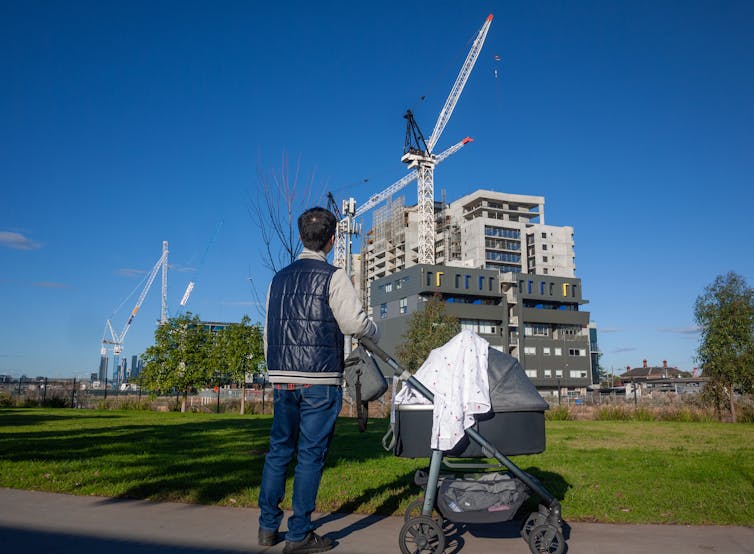
Research consistently shows the clear need to act. Yet our study this year found city planning in Victoria does not sufficiently address climate change.
While Australian states have set goals for emission reductions, these are not yet activated through land use planning and development regulations. We found climate change impacts like sea level rise and urban heat were not sufficiently addressed.
Blind spots like these mean the implications of climate change on our built environment – and on property values – are being mispriced and underestimated.
Without significant, rapid change, society will be further exposed to climate risks.
All of us will bear the cost – through higher council rates to pay for infrastructure damage, rising home and contents insurance costs, and in some cases, being refused any insurance at all. This could devalue your property and put your mortgage at risk.
New Zealand recently made it mandatory for big banks, insurers and firms to disclose their climate risk. This leaves Australia increasingly isolated as a climate laggard and exposed to stranded climate assets (when buildings and properties are worthless due to their climate exposure or lack of insurability).
During extreme weather events, fuelled by climate change, there will be impacts to essential services such as water supply, power, and telecommunications.
These will affect all areas of life – schooling, livelihoods, commercial activities, and retirement plans and funding of them – and the damage is likely to be disproportionately felt by society’s most vulnerable.
Through our super funds, many Australians are investing in properties and businesses that may be exposed to a raft of climate risks, jeopardising our future financial security.
Measures to reduce emissions from the built environment should include a focus on design of buildings and suburbs and active transport options for walking and cycling.
More energy-efficient buildings can reduce emissions and help us adapt to higher temperatures.
Read more: The Great Australian Dream? New homes in planned estates may not be built to withstand heatwaves
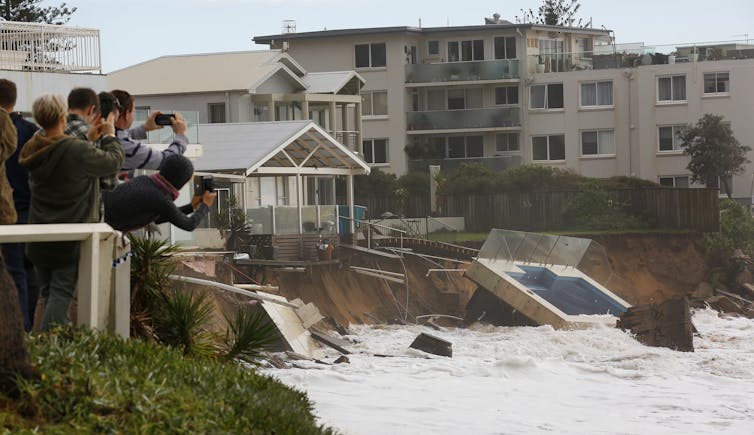
Barriers To Climate Action In The Sector
Without urgent change, Australia’s 2050 goal of reaching net-zero emissions is at risk. Looking at the new homes required to house Australia’s population to 2050, for example, lifecycle emissions generated in construction and operation obliterates the net-zero target. And that doesn’t even account for emissions from the rest of the building sector.
We must rapidly change how we make and implement decisions around urban planning, property, construction and design. We developed a Built Environment Process Map to help with this task.
It describes the fundamental activities involved in producing the built environment. This can help ensure climate change goals are effectively implemented over a city’s life stages and integrated across sectors and actors.
Our research on the Australian property and construction sectors identified barriers to climate change action. They include:
a lack of clear, trustworthy information for key stakeholders about climate change
a perception among stakeholders that investing in climate change action when it’s not mandatory will threaten their economic competitiveness
a lack of a stable regulatory environment, which hampers investor certainty.
Frontrunners in the Australian property and construction sector are not waiting.
Some property and construction firms and local governments are taking progressively more sophisticated approaches to climate change mitigation and adaptation.
But a lack of government regulation is hampering broad-scale action on climate risks, adaptation and mitigation efforts.
Governments Must Act Now
Existing emissions reduction efforts in the industry now need to be supported and mainstreamed through regulatory change. We also urgently need change in the electricity sector to set us on the path of net-zero emissions.
We can’t afford decisions today that lock in further greenhouse gas emissions.
What happens this week in the COP26 is crucial if we are to work towards a zero-emissions built environment, and achieve the critical goal of limiting warming to 1.5℃ this century.
Anna Hurlimann, Associate Professor in Urban Planning, The University of Melbourne; Georgia Warren-Myers, Senior Lecturer in Property, The University of Melbourne, and Judy Bush, Lecturer in Urban Planning, The University of Melbourne
This article is republished from The Conversation under a Creative Commons license. Read the original article.
Big-business greenwash or a climate saviour? Carbon offsets raise tricky moral questions
Christian Barry, Australian National University and Garrett Cullity, Australian National UniversityMassive protests unfolded in Glasgow outside the United Nations climate summit last week, with some activists denouncing a proposal to expand the use of a controversial climate action measure to meet net-zero targets: carbon offsetting.
Offsetting refers to reducing emissions or removing carbon dioxide (CO₂) from the atmosphere in one place to balance emissions made in another. So far, more than 130 countries have committed to the net zero by 2050 goal, but none is proposing to be completely emissions free by that date – all are relying on forms of offsetting.
The use of offsets in meeting climate obligations has been rejected by climate activists as a “scam”. Swedish climate campaigner Greta Thunberg, joining the protesters, claimed relying on buying offsets to cut emissions would give polluters “a free pass to keep polluting”.
Others, however, argue offsetting has a legitimate role to play in our transition to a low-carbon future. A recent report by Australia’s Grattan Institute, for example, claimed that done with integrity, carbon offsets will be crucial to reaching net zero in sectors such as agriculture and aviation, for which full elimination of emissions is infeasible.
So who’s in the right? We think the answer depends on the kind of offsetting that is being employed. Some forms of offsetting can be a legitimate way of helping to reach net zero, while others are morally dubious.
Climate Change As A Moral Issue
The debate over offsetting is part of a key agenda item for COP26 – establishing the rules for global carbon trading, known as Article 6 of the Paris Agreement. The trading scheme will allow countries to purchase emissions reductions from overseas to count towards their own climate action.
To examine carbon offsetting in a moral context, we should first remember what makes our contributions to CO₂ emissions morally problematic.
The emissions from human activity increase the risks of climate change-related harms such as dangerous weather events – storms, fires, floods, heatwaves, and droughts – and the prevalence of serious diseases and malnutrition.
The more we humans emit, the more we contribute to global warming, and the greater the risks of harm to the most vulnerable people. Climate change is a moral issue because of the question this invites on behalf of those people:
Why are you adding to global warming, when it risks harming us severely?
Not having a good answer to that question is what makes our contribution to climate change seriously wrong.
The Two Ways To Offset Emissions
The moral case in favour of offsetting is it gives us an answer to that question. If we can match our emissions with a corresponding amount of offsetting, then can’t we say we’re making no net addition to global warming, and therefore imposing no risk of harm on anyone?
Well, that depends on what kind of offsetting we’re doing. Offsetting comes in two forms, which are morally quite different.
The first kind of offsetting involves removing CO₂ from the atmosphere. Planting trees or other vegetation is one way of doing this, provided the CO₂ that’s removed does not then re-enter the atmosphere later, for example as a result of deforestation.
Another way would be through the development of negative emissions technologies, which envisage ways to extract CO₂ from the atmosphere and store it permanently.
The second form is offsetting by paying for emissions reduction. This involves ensuring someone else puts less CO₂ into the atmosphere than they otherwise would have. For example, one company might pay another company to reduce its emissions, with the first claiming this reduction as an offset against its own emissions.
Australia’s Clean Energy Regulator issues Australian Carbon Credit Units for “eligible offsets projects”. These include for projects of offsetting by emissions reduction.
The regulator certifies that a company, for example, installing more efficient technology “deliver abatement that is additional to what would occur in the absence of the project”. Another company whose activities send CO₂ into the atmosphere, such as a coal-fired power station, can then buy these credits to offset its emissions.
So What’s The Problem?
There is a crucial difference between these two forms of offsetting. When you offset in the first way – taking as much CO₂ out of the atmosphere as you put in – you can indeed say you’re not adding to global warming.
That’s not to say even this form of offsetting is problem-free. It’s crucial such offsets are properly validated and are part of a transition plan to cleaner energy generation compatible with everyone reaching net zero together. Tree-planting cannot be a complete solution, because we could simply run out of places to plant them.
But when you offset in the second way, you cannot say you’re not adding to global warming at all. What you’re doing is paying someone else not to add to global warming, while adding to it yourself.
The difference between the two forms of offsetting is like the difference between a mining company releasing mercury into the groundwater while simultaneously cleaning the water to restore the mercury concentration to safe levels, and a mining company paying another not to release mercury into the groundwater and then doing so itself.
Read more: We can't stabilise the climate without carbon offsets – so how do we make them work?
The first can be a legitimate way of negating the risk you impose. The second is a way of imposing risk in someone else’s stead.
Let’s use a few simple analogies to illustrate this further. In morality and law, we cannot justify injuring someone by claiming we had previously paid someone who was about to injure that same person not to do so.
The same is true when it comes to the imposition of risk. If I take a high speed joyride through a heavily populated area, I cannot claim I pose no risk on people nearby simply because I had earlier paid my neighbour not to take a joyride along the same route.
Had I not induced my neighbour not to take the joyride, he would’ve had to answer for the risk he imposed. When I do so in his place, I am the one who must answer for that risk.
Read more: Take heart at what’s unfolded at COP26 in Glasgow – the world can still hold global heating to 1.5℃
In our desperate attempt to stop the world warming beyond the internationally agreed limit of 1.5℃, we need to encourage whatever reduces the climate impacts of human activity. If selling carbon credits is an effective way to achieve this, we should do it, creating incentives for emissions reductions as well as emissions removals.
What we cannot do is claim that inducing others to reduce emissions gives us a moral license to emit in their place.![]()
Christian Barry, Professor of Philosophy at the ANU, Australian National University and Garrett Cullity, Professor, Australian National University
This article is republished from The Conversation under a Creative Commons license. Read the original article.
Take heart at what’s unfolded at COP26 in Glasgow – the world can still hold global heating to 1.5℃

Greta Thunberg has already pronounced the COP26 climate conference a failure. In important respects, the Swedish activist is correct.
The commitments made at the conference are insufficient to hold global heating to 1.5℃ this century. Leading producers and users of coal, including Australia, rejected a proposed agreement to end the use of coal in electricity generation by 2030. The Australian government went further and refused to commit to reducing methane emissions – a position endorsed by the Labor opposition.
And the rapid economic recovery from the COVID-19 pandemic has produced an equally rapid recovery in demand for all forms of energy, resulting in spikes in the prices of coal, oil and gas.
On the other hand, considered over a longer term, the outcomes of the Glasgow conference look rather better.
At the Copenhagen climate summit in 2009, participants agreed to aim at holding global heating below 2℃ this century, but did not deliver policy commitments to achieve this goal. The scenarios considered most plausible at the time yielded estimated heating of around 3℃.
The worst-case scenario, commonly described as “business as usual”, implied a catastrophic increase of up to 6℃ in global temperatures by 2100. As a result of all this, the Copenhagen talks were considered a spectacular failure.
But heading into the final days of the Glasgow summit, the goal of limiting heating below 2℃ looks attainable, and 1.5℃ is still possible. Despite the inevitable disappointments in the decade or so since Copenhagen, there is still room for hope.

1.5℃ To Stay Alive
Ahead of COP26, commitments by each nation had the world on track for 2.7℃ warming this century.
The ten days of the talks so far, however, have yielded new binding commitments. According to one analysis, the commitments put the world on a trajectory to 2.4℃ warming. This assessment is based on current submitted climate pledges by each country, known as nationally determined contributions or NDCs, together with legally binding net-zero commitments.
When we account for additional pledges announced – but not yet formalised – by the G20 countries, the projected temperature rise this century lowers to to 2.1℃, according to analysis by Climate Action Tracker released in September.
So that’s the good news. And of course, those optimistic trajectories assume all pledges are fully implemented.
It has become clear, however, that even 2℃ of global heating would be environmentally disastrous.
Even under the current 1.1℃ of warming since the beginning of large-scale greenhouse gas emissions, Earth has experienced severe impacts such as devastating bushfires, coral bleaching and extreme heatwaves resulting in thousands of human deaths. Such events will only become more frequent and intense as Earth warms further.
This underscores the vital importance of urgently pursuing the 1.5℃ goal. It is, quite literally, a matter of life and death for both vulnerable human populations and for natural ecosystems.
The idea of a target of 1.5℃, supported by many developing countries, was rejected out of hand by major countries at the Copenhagen conference.
The Paris conference in 2015 marked an important, but still partial move towards the 1.5℃ goal. There, nations agreed on a goal to hold global average temperature rise to well below 2℃ above pre-industrial levels, while pursuing efforts to limit the increase to 1.5℃.
We’re yet to see the final communique from Glasgow, and every word in it will doubtless be subject to lengthy negotiation. But it’s almost certain to include a strengthening of the language of the Paris Agreement, hopefully with a formal commitment that warming will be held to 1.5℃.
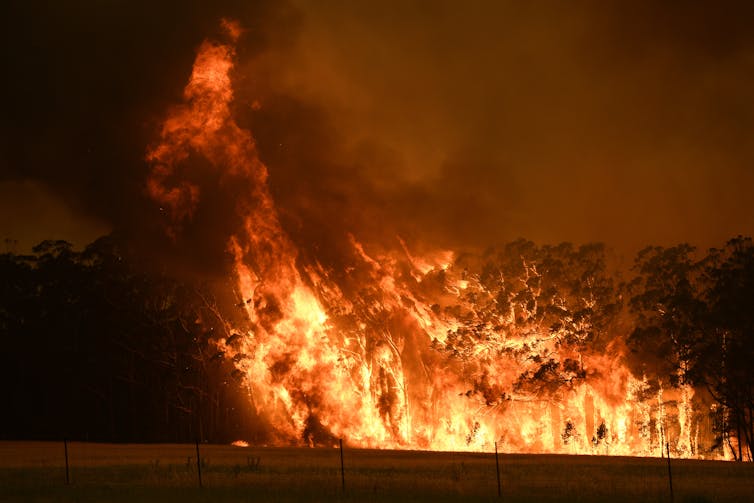
Reason For Hope
As with previous conferences, policy commitments at Glasgow will be insufficient to reach the 1.5℃ target. Most notably, the commitment to reduce methane emissions is, at this stage, merely an aspiration with no concrete policies attached.
And as analysis released on Tuesday found, real-world action is falling far short despite all the net-zero promises. If that “snail’s pace” continues, a temperature rise of 2.4℃, or even 2.7℃, remains a distinct possibility.
But the technologies and policies needed to hold warming to 1.5℃ are now available to us. And they can be implemented without condemning developing countries to poverty or requiring a reduction in living standards for wealthier countries.
The fact we have these options reflects both remarkable technological progress and the success of policies around the world, including emissions trading schemes and renewable energy mandates.
Thanks largely to government support, advances in solar and wind technology kicked off in the early 2000s. This ultimately pushed the cost of carbon-free electricity below that of new coal-fired and gas-fired plants.
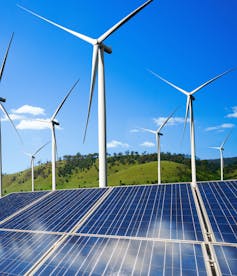
The biggest impact was felt in the European Union, where carbon prices and emissions trading drove a rapid transition. The EU has a clear path to the goal of net-zero emissions by 2050.
The most important requirement is to accelerate the transition to carbon-free electricity. This involves rapidly expanding solar and wind energy and replacing petrol- and diesel-powered vehicles with electric alternatives.
These changes would incur a one-off cost in scrapping existing power plants and vehicles before the end of their operational life, but would reduce energy and transport costs in the long run.
Other important steps are already beginning. They include reducing methane emissions, and adopting carbon-free production methods for steel, cement and other industrial products. Hydrogen produced from water by electrolysis will be crucial here.
There is no guarantee these outcomes will be achieved. The leading national emitters – China, India and the United States – have all been inconsistent in their pursuit of stabilising Earth’s climate.
China is currently wavering as economic difficulties mount. In the US, Donald Trump has not ruled out a presidential bid in 2024 which, if successful, would almost certainly reverse progress there.
Global action on climate change is still not nearly enough, but we’re undeniably moving in the right direction. By the time of the next major COP, presumably in 2026, Earth could finally be on a path to a stable climate.
Read more: Scott Morrison is hiding behind future technologies, when we should just deploy what already exists ![]()
John Quiggin, Professor, School of Economics, The University of Queensland
This article is republished from The Conversation under a Creative Commons license. Read the original article.
COP26: what the draft climate agreement says – and why it’s being criticised
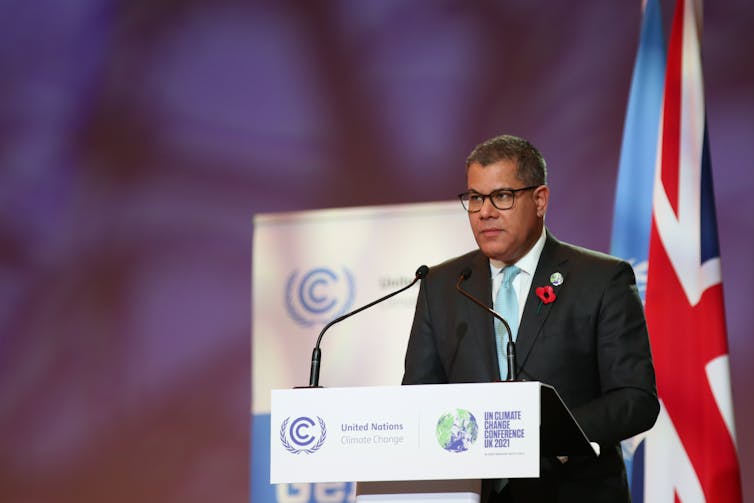
Having led the delegates at the COP26 climate summit in Glasgow to believe that the first draft of the final agreement would be published at midnight Tuesday, the UK presidency will not have made many friends by delaying it till 6am Wednesday morning. There will have been plenty of negotiators – not to mention journalists – who will have needlessly waited up all night.
In fact, COP26 president Alok Sharma will not have made many friends with the text itself either. As the host and chair of the summit, it is the UK’s responsibility to pull together all the negotiating texts which have been submitted and agreed over the last week into a coherent overall agreement.
But the widespread consensus among delegates I have spoken to is that the draft they have produced is not sufficiently “balanced” between the interests and positions of the various country groupings. And for the chair of such delicate negotiations, that is a dangerous sin.
Let’s recap. This COP (the conference of the parties to the UN Framework Convention on Climate Change) is the designated moment under the 2015 Paris Agreement when countries must come forward with strengthened commitments to act. There are two main areas for this. One is emissions cuts by 2030, the so-called “nationally determined contributions” or NDCs. The other, for the developed countries, is financial assistance to the least developed nations.
The problem facing the COP is that we know already that, when added together, countries’ emissions targets are not nearly enough to keep the world to a maximum warming of 1.5°C above pre-industrial times, as the Paris Agreement aims for. And the financial promises don’t even reach the US$100 billion (£74.1 billion) a year that was meant to be achieved in 2020, let alone the much larger sums the most vulnerable countries need.
So what have the poorest countries – and the vociferous civil society organisations demonstrating in Glasgow – been demanding?
First, that NDCs should be strengthened before the scheduled date of 2025. And second, that at least US$500 billion should be provided in climate finance over the five years to 2025, with half of this going to help countries adapt to the climate change they are already experiencing.
Urging – Not Requiring
So what does the UK draft text say? It merely “urges” countries to strengthen their NDCs, proposing a meeting of ministers next year and a leaders’ summit in 2023. But “urges” is UN-speak for: “You may do this if you wish to, but you don’t have to if you don’t.” That is not enough to force countries to get onto a 1.5℃-compatible path. The text must require them to do so.
On finance, the text is even weaker. There is no mention of the US$500 billion demand, although it does call for adaptation funding to be doubled. There is no mention of using the special drawing rights (a kind of global money supply) which the IMF has recently issued for climate-compatible development. And there is insufficient recognition that the most vulnerable countries need much better access to the funds available.
Of course, developing countries do not expect to get all their own way in the negotiations. But commenting on the overall balance of the text between different countries’ positions, one European delegate said to me: “This looks like it could have been written by the Americans.”
It is of course true, as Alok Sharma emphasised in his afternoon press conference, that the text can still be changed. There are several issues on which negotiations are continuing and the text has yet to reflect their progress. Sharma has asked all parties to send in their suggested amendments to the draft and to meet him to discuss their reactions. He will find himself asked for a lot of meetings.
But it matters how this early text is drafted, for two reasons. First, the lack of balance means that it is the least developed countries which will have to do the most work to change it. In Paris the French presidency worked the other way round. They drafted an ambitious text and dared the biggest emitters to oppose it.
Second, the perceived imbalance could affect the trust in the British hosts. Sharma has built himself a strong reputation over the past couple of years preparing for the COP. He will not want to lose that in the crucial last days ahead.
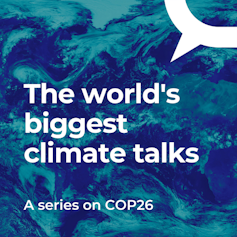
This story is part of The Conversation’s coverage on COP26, the Glasgow climate conference, by experts from around the world.
Amid a rising tide of climate news and stories, The Conversation is here to clear the air and make sure you get information you can trust. More. ![]()
Michael Jacobs, Professorial Fellow, Sheffield Political Economy Research Institute (SPERI), University of Sheffield
This article is republished from The Conversation under a Creative Commons license. Read the original article.
Can climate laggards change? Russia, like Australia, first needs to overcome significant domestic resistance
Ellie Martus, Griffith UniversityFormer US president Barack Obama took specific aim at Russia at the Glasgow COP26 climate talks this week. According to Obama, the fact Russian President Vladimir Putin (as well as Chinese President Xi Jinping) declined to attend the conference reflects “a dangerous absence of urgency, a willingness to maintain the status quo” on climate action.
As the world’s fourth-largest emitter of greenhouse gases and one of the world’s top coal, oil, and gas producers and exporters, Russia is a key player in international climate action. Decarbonisation of carbon-intensive economies like Russia is crucial to reaching global emissions targets.
But like Australia, Russia is seen as an international climate laggard, and must overcome significant resistance to genuine climate policy reform at home.
Despite vastly different political systems, we can draw interesting parallels between Russia and Australia on the climate front.
Read more: To reach net zero, we must decarbonise shipping. But two big problems are getting in the way
Russia’s International Participation On Climate
In a surprise announcement two weeks out from COP26, Putin said Russia will aim to achieve carbon neutrality by 2060. But his decision not to attend COP26 dealt a blow to the summit’s prospects of success.
Russia has long been a reluctant participant in international climate change negotiations. It refused to ratify the Kyoto Protocol until 2004, then failed to sign up for Kyoto’s second commitment period. Similarly, Russia signed the Paris Agreement in 2016, but delayed its final decision on ratification until late 2019.
That’s despite a long tradition of Russian climate science research dating back to the Soviet period.
In the end, ratifying the Paris Agreement was an easy political win, given how weak Russia’s commitments under the agreement are.
Russia’s updated NDC (nationally determined contribution, meaning the action it will take to meet its climate commitments) was submitted in November 2020. It sets an emissions reduction target of 70% relative to 1990 levels by 2030.
The target sounds ambitious but the nation’s economic decline in the 1990s, and subsequent fall in greenhouse gas emissions, means it’s easily achievable. This target also leverages the capacity of Russia’s forests to absorb CO₂, though many scientists dispute the extent of this.
So what explains Russia’s limited commitments to date? The domestic politics surrounding climate change offer clues.
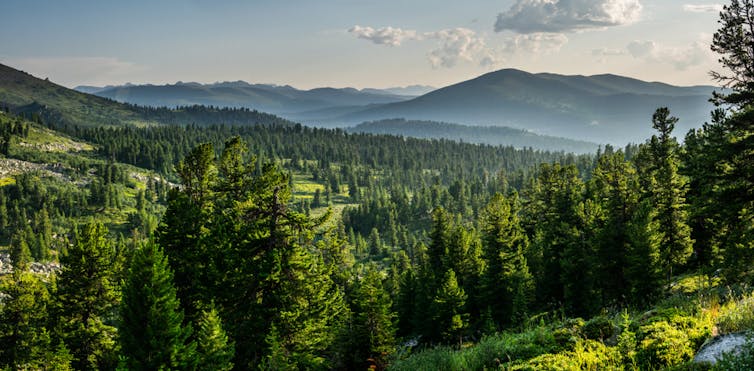
Domestic Climate Politics And Obstacles To Reform
Domestic politics on climate change in Russia are fiercely contested, with key individuals and groups competing for influence. These debates occur mostly at an elite level, with little space given to civil society actors.
Attempts to strengthen domestic climate policy in the past have been met with strong opposition from powerful economic interests.
The coal industry remains one of the most significant obstacles to reform. At a time when a growing number of countries are committed to phasing out coal, Russia is actively seeking to expand its industry. The coal industry has close links with key government ministries, including the powerful ministry for energy. The industry has successfully lobbied for subsidies and state support.
Coal politics in Russia are made more complex by the heavy dependence on coal for employment and heating in certain regions, such as the Kuzbass in Siberia. Attempts to wind down the industry would meet significant opposition from locals and regional elites.
Oil and gas companies are moving ahead with their plans to expand into the Arctic, with a warming climate making the region more accessible. Revenues from oil and gas exports make up a significant portion of Russia’s budget, so its highly unlikely Russia will give this up anytime soon.
Putin’s own position on climate has been ambiguous. He and other members of the elite often portray Russia as a global climate leader and “ecological donor” due to its vast forest resources.
However, Russia’s limited policy commitments to date make such statements little more than symbolic.
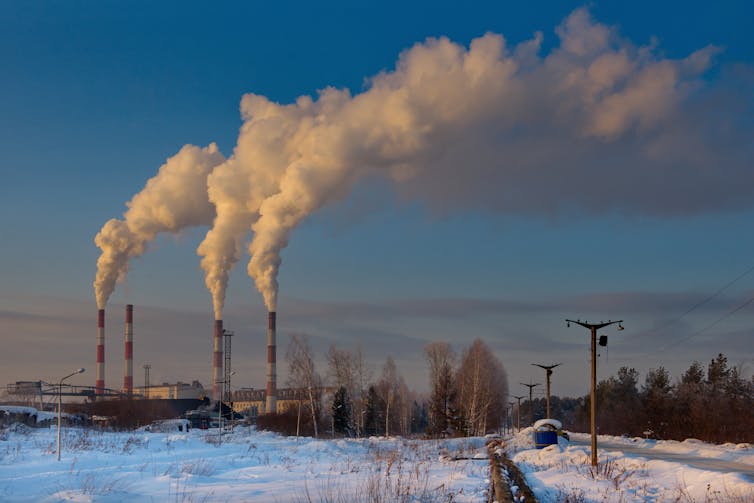
Recent Political Shifts
More recently however, we’ve seen some important developments which suggest a shift may be occurring.
A pro-climate lobby is emerging around the ministry for economic development and other government actors. They take a pragmatic view of climate change and acknowledge the economic cost to Russia of doing nothing.
International pressures are also mounting.
The EU’s Carbon Border Adjustment Mechanism (which puts a carbon price on certain imports) has many in the Russian government concerned, given the significant impact anticipated for key Russian exports. Some in government have also questioned the long-term viability of coal given global decarbonisation trends.
Two of Russia’s major state owned corporations, Rosatom and Gazprom, are at the forefront of an attempt to reposition Russia as a renewable energy superpower, centred on the expanding hydrogen and nuclear industries. Both provide Russia with potential to generate significant export revenues.
Support for a more active stance on climate has also come from some of Russia’s largest private companies. Groups such as EN+ and Rusal have made their own net-zero by 2050 commitments, keen to demonstrate their climate credentials to environmentally sensitive international markets.
This newfound momentum has led to a number of important policy developments, culminating in the net-zero by 2060 announcement. So while the obstacles remain huge, there has been a discernible shift in Russia’s approach to climate change.
What Can Australia Learn?
Both Australia and Russia are regarded as climate laggards and face increased international criticism over their lack of policy ambition.
Both have elements of strong resistance to climate action at a domestic level, particularly in the coal industry. But both also have corporate players acting to reduce emissions in spite of government policy inaction.
While much attention has been focused on net zero targets, little detail has been given by either country about how these will be achieved. And neither Russia nor Australia’s net zero commitments say anything about exported emissions.
Ambitious declarations mean nothing if they’re not backed by serious policy reform. Promises aside, significant work needs to be done in both nations to address the gap between vague, high-level commitments and concrete, implementable policies.
Read more: Scott Morrison is hiding behind future technologies, when we should just deploy what already exists ![]()
Ellie Martus, Lecturer in Public Policy, Centre for Governance and Public Policy, Griffith University
This article is republished from The Conversation under a Creative Commons license. Read the original article.
Scott Morrison is hiding behind future technologies, when we should just deploy what already exists

At the United Nations climate summit in Glasgow last week, more than 40 countries pledged to phase out coal-fired power. Some were big coal-using countries such as Poland, Canada and Vietnam – however Australia was not among them. Australia was similarly absent for a methane reduction pledge.
Achieving the Paris Agreement — limiting global warming to well below 2℃ and preferably 1.5℃ — requires the rapid phase out of coal, oil and fossil gas. Failure to do so will spell the end of the Great Barrier Reef and make a large swathe of Australia virtually unlivable.
Yet the Morrison government’s technology-driven net-zero “plan” contains no concrete measures to end this fossil fuel addiction. It’s more a placeholder than a strategy, fulfilling the government’s need to have a document to wave around. Meanwhile, the government seems intent on sitting back and letting the future happen, rather than creating it.
I’ve spent 25 years working and investing in technology commercialisation, focusing over the past 15 years on clean technologies. I know Australia doesn’t need to wait for new technology before committing to and achieving deep emissions cuts. Most technologies we need already exist – they just need to be deployed, rapidly and at massive scale. And that requires an actual plan.
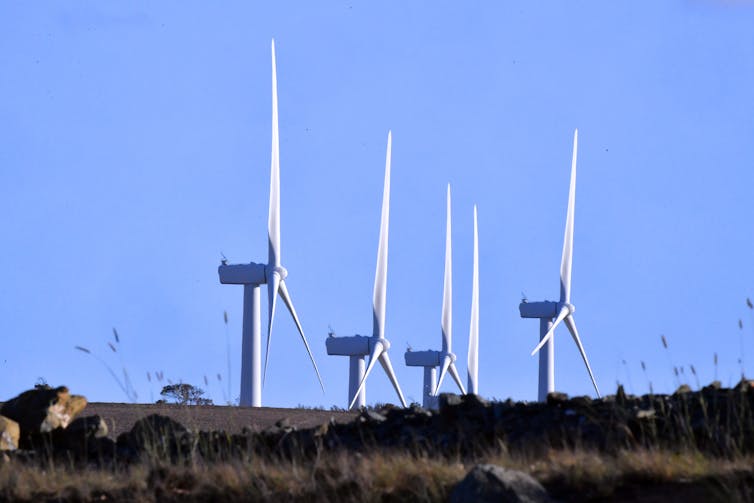
We Have The Technology
The Morrison government’s path to reach net-zero by 2050 relies primarily on technology, but fails to even remotely outline what that would mean in practice.
A total of 70% of the emissions cuts would purportedly be achieved by technology “investment”, “trends” and “breakthroughs”. But it’s not technology per se that reduces emissions, it’s deploying it.
The government missed the opportunity to explain decarbonisation at its simplest: electrify everything we can, and power it with renewables.
Some 84% of Australia’s emissions come from activities related to the energy sector. Recent overseas analysis shows electrification could replace 78% of energy emissions using established technologies. Add technologies being developed, and the figure rises to 99%.
Hydrogen, one of the government’s technologies du jour, is likely to play a modest but important role in domestic decarbonisation. And if we don’t get left behind, it could become a significant export earner.
But what’s required in the near term is much more boring: build lots of wind, solar and storage, retire coal and gas as soon as possible, and electrify transport and heating.
Carbon capture and storage (CCS), a favourite of Australian governments for decades, remains a distraction. First, since CCS adds significant cost but no benefit to a process, it will always require either a carbon price or regulations to be viable. Second, while CCS may play a role at the margins in areas where emissions are hard to abate, such as cement production, its only significant role for coal and gas is as a fig leaf for inaction.
Green steel could be a significant opportunity for Australia, given our abundance of iron ore and access to low-cost clean energy. But while Australia dips a toe in the water, overseas companies like SSAB and Volvo are demonstrating that the days of metalurgical coal — one of Australia’s biggest exports — are numbered.
Clearly, the technologies are here. What we need is deployment.
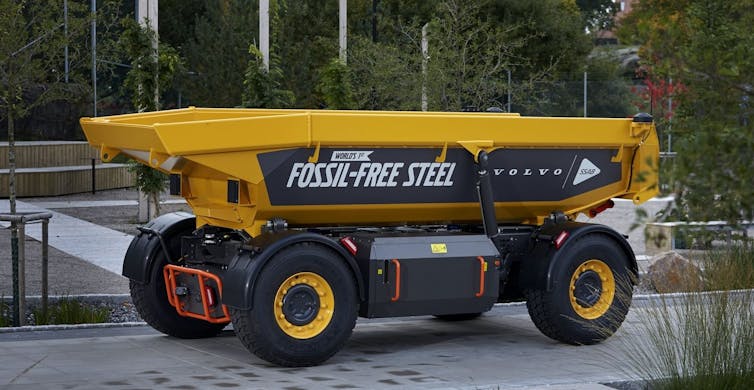
Learn From Henry Ford
A decade ago, energy from wind and solar was significantly more expensive than from coal and gas. But renewables are now the cheapest form of new energy, even including additional costs such as energy storage and transmission.
Renewable energy’s fast fall in price was due to a mix of well-designed government policies and massive private investment, both here and around the world.
The Commonwealth’s Renewable Energy Target, for example, required electricity retailers to purchase a small but increasing amount of renewable energy each year, in a way that did not significantly affect energy affordability. With renewables now at a lower cost than new coal and gas, that early investment is paying dividends.
The experience showed we don’t have to wait until technology is cheap and perfect before deploying it. In fact, the only way to make it cheap and perfect is to deploy it, again and again.
When Henry Ford released the Model T in 1908 his horseless carriage was imperfect and expensive. Yet it kicked off a process of technological improvement in which each successive generation of cars has learnt lessons from those which came before.
If federal Energy Minister Angus Taylor time-travelled back to 1908, would he advise Ford not to release the Model T until it resembled the Tesla Model S?

Seizing Opportunities
Most economists agree the most efficient way to reduce emissions is to put a price on carbon and let the market respond. More than a decade of toxic Australian politics has poisoned that well. It leaves policymakers with few tools, and politicians with even fewer ideas.
In the absence of an explicit carbon pricing scheme, the federal government should set clear emissions reduction targets in each sector of the economy.
Monash University’s ClimateWorks has developed a plan for doing so. Such a plan, with an added combination of policy “carrots” (subsidies or incentives) and “sticks” (regulations or taxes) would ensure emissions reduction targets are met.
Our lowest hanging fruit would include a carefully managed coal phase-out and policies to rapidly electrify transport and heating, using existing technologies. This would help us hit meaningful 2030 emissions reduction targets consistent with the Paris Agreement.
Meanwhile, we sit on the cusp of what is almost certainly Australia’s biggest ever investment opportunity. Our wide brown land is chock full of the critical minerals needed in a decarbonising world — lithium, nickel, cobalt, rare earth metals and silicon. Moreover, our windswept and sun-drenched plains are ready to produce the low-cost energy required to locally transform these raw minerals into valuable refined materials.
Our state governments, some having committed to net-zero five years ago, are making progress – particularly in electricity. But complementary and coordinated policies at the federal level would almost certainly make progress faster — and cheaper.
The coal and methane pledges at COP26 shows many of the world’s most emissions-intensive economies are ready to make the transition. Meanwhile, the federal government’s so-called “plan” prevents Australia from claiming our place in the sun, and wind.
Read more: Economists back carbon price, say benefits of net-zero outweigh costs ![]()
Simon Holmes à Court, Senior advisor, Climate and Energy College, The University of Melbourne
This article is republished from The Conversation under a Creative Commons license. Read the original article.
Melbourne’s Buildings Could Be Close To Self-Sustaining Through Fully Integrated Solar
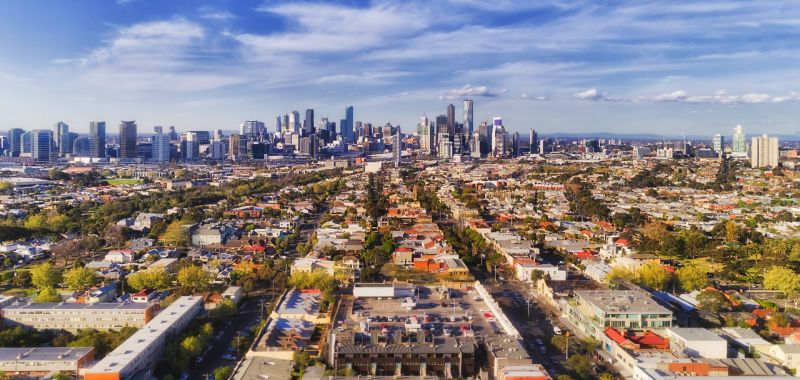 Published in the journal Solar Energy, the research, led by members of the ARC Centre of Excellence in Exciton Science based at Monash University, together with collaborators at the University of Lisbon, is the first of its kind anywhere in the world to model the viability and impact of window-integrated photovoltaics, alongside other solar technologies, at a city scale.
Published in the journal Solar Energy, the research, led by members of the ARC Centre of Excellence in Exciton Science based at Monash University, together with collaborators at the University of Lisbon, is the first of its kind anywhere in the world to model the viability and impact of window-integrated photovoltaics, alongside other solar technologies, at a city scale.To reach net zero, we must decarbonise shipping. But two big problems are getting in the way
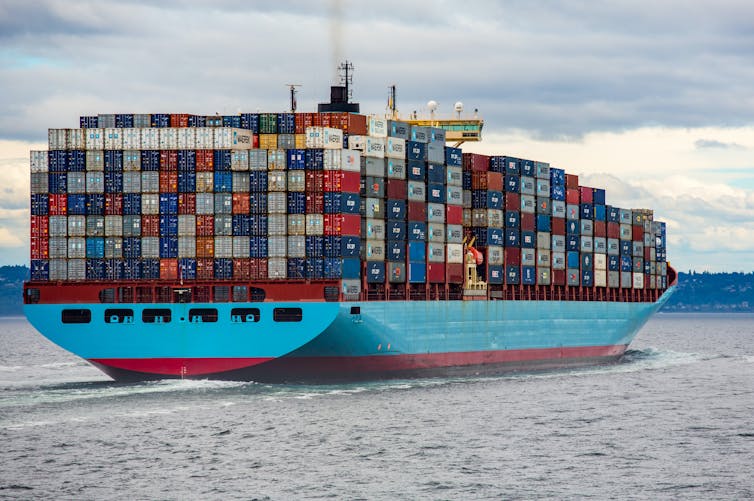
Shipping, which transports 90% of the world’s trade, contributes nearly 3% of global emissions – a little more than the carbon footprint of Germany. If gone unchecked, this share could increase to 17% by 2050 as the world’s GDP keeps growing.
Curbing shipping emissions has been a hot topic at the international climate summit in Glasgow, with 14 nations signing a declaration last week to bring shipping emissions down to net zero by 2050.
On Saturday, shipping industry heavyweights and senior government representatives met to iron out details of this lofty promise, ahead of the key transportation talks at COP26. Important differences emerged in whether market or regulatory rules will be most effective to push the industry towards net zero.
Shipping and aviation are notoriously difficult industries to decarbonise. They require vast amounts of fuel for international travel, and the questions of which country is responsible for emissions makes reaching agreements a mammoth and glacial task.
Growing Momentum
Shipping’s total emissions are set to increase this year for the first time since the global financial crisis of 2008.
If left unregulated, shipping and aviation will be responsible for almost 40% of all carbon dioxide emissions in 2050, according to a study published by the European Parliament.
With so much at stake, we’re finally starting to see change, with businesses (and their customers) placing more emphasis on shipping’s contribution to climate change. In October this year, nine big companies – including Amazon, Ikea, and Unilever – pledged to move their cargo only on ships using zero-carbon fuel by 2040.
What’s more, three of the world’s largest container shipping lines – Maersk, CMA CGM, and MSC – are actively pursuing the use of alternative fuels and aim to be net-zero compliant by 2050 or before.
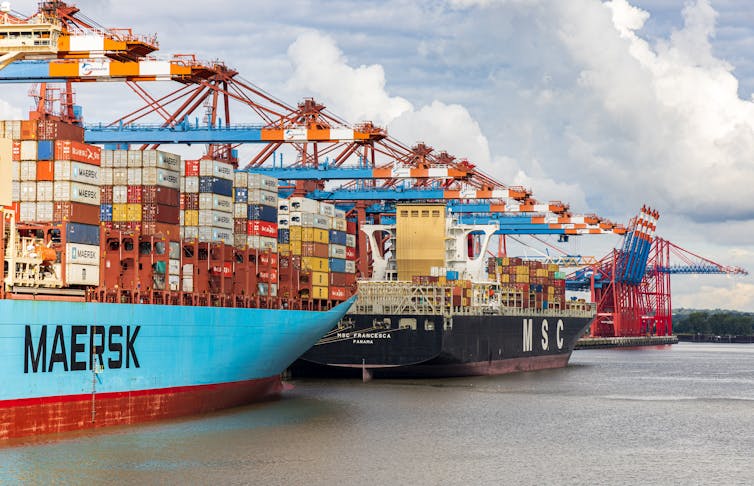
A Lack Of Technology
Most ship engines use a low-grade, carbon-heavy fuel oil, which creates significant air pollution. So some shipowners are moving to build new ships or convert existing ships to run on liquefied natural gas (LNG) instead.
While this presents a 25% reduction in CO₂ emissions compared to the current low-grade fuel, LNG still releases methane into the atmosphere – a heat-trapping gas roughly 30 times more potent than CO₂.
This points to a big problem getting in the way of decarbonising shipping: zero-carbon technologies that can be applied at scale to large ocean-going ships do not yet exist.
Read more: Shipping emissions must fall by a third by 2030 and reach zero before 2050 – new research
Commercially viable technologies that create alternative, zero-emissions fuels, such as hydrogen and ammonia, are still in development by ship engine manufacturers.
A significant challenge is the requirement for vast fuel storage on board ships, and replenishing these fuels in port, especially after long voyages. Battery power using renewable sources can only be used on short voyages such as ferries or on coastal trips.
Nuclear propulsion has also been considered, but there are associated risks and it doesn’t have the support of the general public.
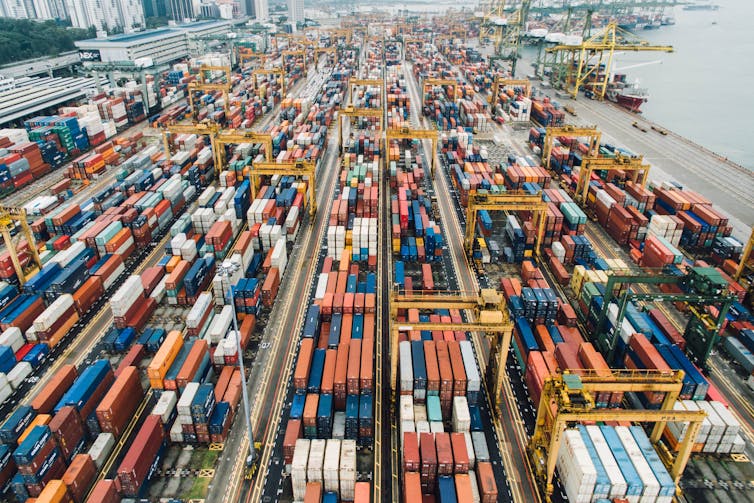
Global Disunity
In October, shipping was under fire from United Nations Secretary General Antonio de Guterres, who accused the industry of not doing enough to stop global warming. So, is he right?
One of the difficulties in cutting emissions in shipping is that it’s hard to decide which country the emissions should be assigned to.
Should it be based on where the ship’s fuel is sold, where a ship is registered, or the origins or destinations of the ship’s cargo? Each option would lead to radically different emissions responsibilities and associated costs for individual countries.
Read more: Cargo ships are emitting boatloads of carbon, and nobody wants to take the blame
The International Maritime Organization (IMO) is the UN body that addresses emissions from ships engaged in international trade. It’s currently coordinating measures to curb maritime emissions among its more than 170 member states. And each state has competing interests.
In April 2018, the IMO set a goal of halving greenhouse gas emissions by 2050 from 2008 levels. This has been met with fierce criticism from environmental organisations, who call it weak and unambitious.
This target falls well short of the net-zero by 2050 target declared by nations last week at COP26. The declaration was led by Denmark and includes the US. Notably, it was not signed by countries with big maritime shipping sectors, such as Japan and Greece.
The IMO has agreed, after collecting more data, to revisit their target in 2023. Given growing public interest in climate change and large companies demanding zero emissions in shipping their goods, I believe it’s likely the IMO will bolster its target, and start working towards net-zero emissions by 2050.
So What Needs To Happen Now?
At Saturday’s conference, it became clear most shipowners present were in favour using the market to solve the emissions problem, and suggested using a carbon price.
This echoes the calls of trade groups, representing more than 90% of the world’s merchant fleet. They have asked the IMO to prioritise a carbon tax for the industry to encourage shipowners to invest in alternative fuel technologies.
On the other hand, the representative for Japanese shipowners was in favour of letting politicians come up with the rules, saying the shipping industry would comply with them.
And shipowners that recently invested in ships fuelled by LNG were, understandably, advocating its use, saying no zero-carbon alternative fuels are currently available, and are still a long way off.
But before we can make any real headway to decarbonise shipping, we must have global unity. It is imperative more member states get on board with the net zero by 2050 declaration.
The IMO needs to set international standards around who’s responsible for emissions. Countries with large shipping fleets such as Japan and Greece need to come on board to expedite the process. IMO resolutions take years to develop and even longer to be ratified by its member countries.
A well-funded research and development program, which the industry has agreed to pay for within a global regulatory framework, needs to commence immediately under the supervision of the IMO.
The heightened interest we’re seeing across the supply chains and at COP26 is an important opportunity for the shipping industry to be on the front foot, and reduce their emissions sooner rather than later.

This story is part of The Conversation’s coverage of COP26, the Glasgow climate conference, by experts from around the world.
Amid a rising tide of climate news and stories, The Conversation is here to clear the air and make sure you get information you can trust. Read more.![]()
Peter van Duyn, Maritime Logistics Expert, Centre for Supply Chain and Logistics (CSCL), Deakin University
This article is republished from The Conversation under a Creative Commons license. Read the original article.
Feel alone in your eco-anxiety? Don’t – it’s remarkably common to feel dread about environmental decline
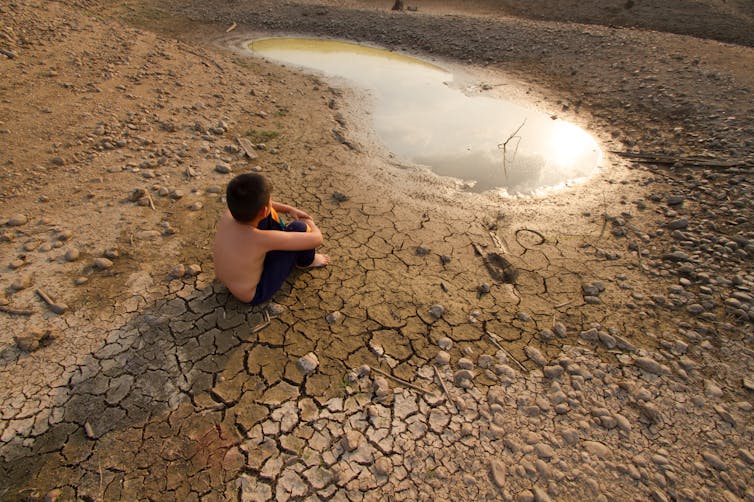
Feeling anxious about the ecological crises we face is entirely understandable, given the enormity of the threats.
Eco-anxiety is sometimes described as a mental health problem. It’s not. Eco-anxiety is a rational psychological and emotional response to the overlapping ecological crises we now face.
If you feel this way, you are not alone. We have found eco-anxiety is remarkably common. Almost two-thirds of Australian participants in our recent surveys reported feeling eco-anxiety at least “some of the time”.
The response can be triggered by media stories on environmental and climate crises as well as human efforts to combat them. This includes the barrage of media from the United Nations climate conference, or COP26, now underway in Glasgow.
In this age of ecological reckoning, eco-anxiety is not going to go away. That means we must learn how to cope with it – and perhaps even harness it to drive us to find solutions
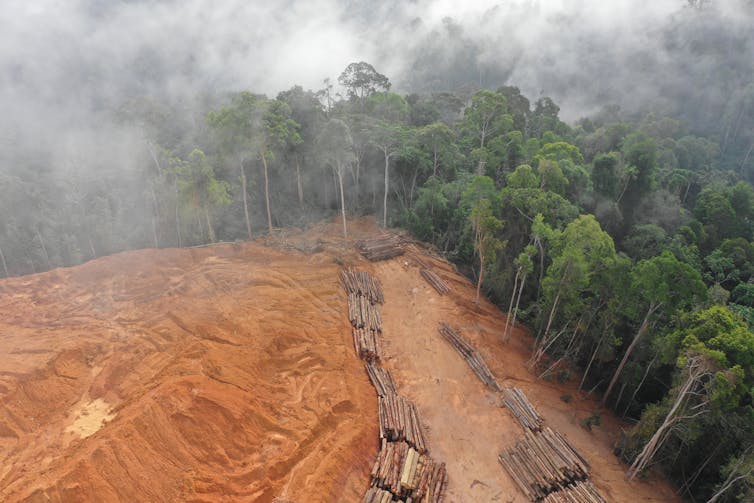
Dwelling On Problems We Contribute To
Our study found four key features of eco-anxiety:
- affective symptoms, such as feelings of anxiety and worry
- rumination, meaning persistent thoughts which can keep you up at night
- behavioural symptoms, such as difficulty sleeping, working, studying or socialising
- anxiety about your personal impact on the planet.
We found similar levels of eco-anxiety in our surveys of 334 Australians and 735 New Zealanders, with people affected in similar ways in both countries. This supports emerging research, which found more than half of young people surveyed across ten countries experienced climate anxiety. Feeling anxious about the state of the planet is likely to be universal.
When we asked Australians how it affected them, they told us eco-anxiety affected everything from their mood to their daily routine to their relationships. It even affected their ability to concentrate, work or study. For some, eco-anxiety made them feel restless, tense and agitated. New Zealanders reported similar impacts.
Read more: The rise of 'eco-anxiety': climate change affects our mental health, too
Our study found people were also anxious about their personal contribution to the deteriorating state of the planet. Some participants noted the state of the planet made them “extremely anxious”, so much so they “find it hard to think about anything else”.
Other research shows many people are anxious about how their personal behaviours impact the earth, such as consumerism or flying. Some young adults are choosing to have fewer children, or none at all, out of concern their children will contribute to the climate crisis or will inherit a degraded world.
These fears appeared in our study too, with one parent participant noting:
My biggest worry is that climate change will affect my child in their lifetime, and I get very upset that I won’t be able to protect him from the effects of it.
Is Eco-Anxiety Different To Generalised Anxiety?
Eco-anxiety has similarities with generalised anxiety and stress, but we found important differences, such as the focus on environmental issues and our contribution to the problem.
We also found people experience eco-anxiety independent of depression, anxiety and stress, suggesting it’s a unique experience.
While it is possible to experience eco-anxiety as someone who is otherwise mentally well, many people experience it on top of existing mental health issues.
What we need to do now is understand what eco-anxiety means for individual (and planetary) well-being, and provide support to people with varying degrees of this anxiety.
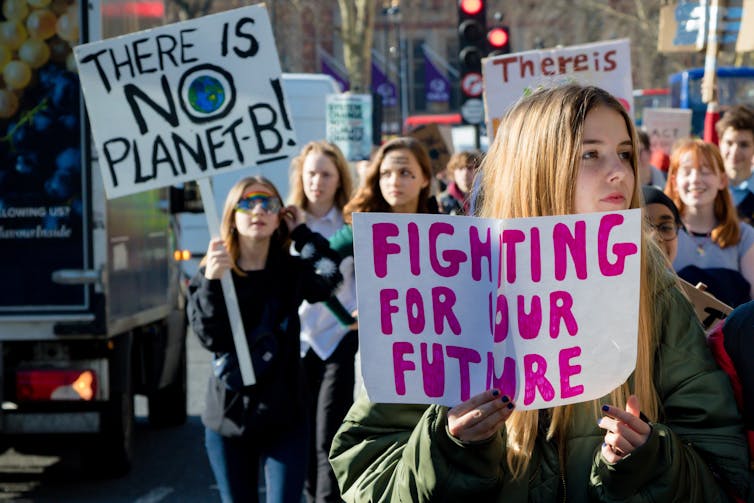
Four Ways To Cope With Your Eco-Anxiety
Eco-anxiety is not going to go away as an issue, given the range of environmental issues the world is confronting. To stop these feelings becoming overwhelming or debilitating, there are a range of behavioural, cognitive and emotional strategies people can use to cope.
Here are four techniques:
validation One part of managing your own anxiety is to validate it, by acknowledging it makes sense to feel anxious and distressed
time out Another technique is to take mental breaks and avoid your 24/7 news feed to give yourself time to restore a sense of balance
seek hope Cultivating a realistic sense of hope about the future can also reduce anxiety emerging from our awareness of ecological threats. That means appreciating the complexity of the problem, while also searching for alternative visions of the future and trusting that we, as a collective, will eventually resolve the crisis before it’s too late
take action Many of us struggle with a sense of overwhelming powerlessness in the face of a deteriorating climate. This can be self-reinforcing. To combat this, you can try action - whether changing your own behaviour or getting involved in campaigns.
As climate campaigner Greta Thunberg has said, “no one is too small to make a difference”.
Climate change has been described as the greatest collective action problem we have ever faced. That means the necessary changes will have to come from the collective action of all individuals, industries and governments. We all must act together now, just as we have in combating the COVID pandemic.
Eco-anxiety is increasingly common. But being concerned about environmental crises does not need to come at the cost of your health and wellbeing.
After all, psychological, emotional and behavioural burnout is not helpful for you – or the planet.![]()
Teaghan Hogg, PhD student, Clinical Psychology, University of Canberra; Léan O'Brien, Lecturer, University of Canberra, and Samantha Stanley, Research Fellow in Psychology, Australian National University
This article is republished from The Conversation under a Creative Commons license. Read the original article.
Yes, young people are concerned about climate change. But it can drive them to take action
Emma Sciberras, Deakin University and Julian Fernando, Deakin UniversityThe COP26 climate change conference in Glasgow is drawing to a close. And despite high hopes, many young people may be feeling disappointed with the progress at these landmark talks.
They may be feeling anxious about their future, considering they’ll be bearing the brunt of the impact of decisions made over the past two weeks.
Our soon-to-be published research in the journal Child and Adolescent Mental Health shows most young people in Australia are concerned about climate change.
But that’s not necessarily a problem. For some, a growing concern can motivate them to take action.
There’s A Word For This Concern – Eco-Anxiety
Eco-anxiety relates to worry and despair about climate change. Connected terms include “ecological grief”, which reflects grief related to ecological loss. People can also experience emotions such as fear, guilt and anger about climate change.
We know adults experience these types of climate-related emotions.
However, understanding young people’s views about climate change is important as they are more likely to be alive to experience its worst potential effects.
Young people have also had a prominent role in climate activism, including the School Strike 4 Climate movement involving millions of young people around the world.
Given the level of young people’s worry or concern about climate change we identified in our study, we may see their views becoming more influential as they reach voting age.
Listening to these climate change concerns is vital. However, only 13% of young people in Australia feel government leaders are listening to them.
We Asked Young People About Climate Change
In our study, we tracked concern and worrying about climate change in more than 2,200 Australian young people over a period of eight years. At the start of the study, participants were aged 10-11, so by the end, they were 18-19 years old.
At 18-19 years of age, most young people (75%) had at least some concern or worry about climate change. But we also identified different patterns of climate worry over time.
About half had increasing or had maintained moderate levels of worry over time. A total of 13% maintained high levels of worry over the eight years we tracked them.
But 17% had persistently low levels of worry. Some young people became less worried over time.
Read more: Greta Thunberg emerged from five decades of environmental youth activism in Sweden
Compared to those who were moderately worried, adolescents with high levels of persistent climate worry had higher depression symptoms at age 18-19. However, those who increased their climate-related worry over time did not.
This suggests developing an awareness and concern for the environment was not associated with general mental health difficulties.
Those with persistently high and increasing levels of climate worry had greater engagement with politics and news at 18-19 years.
There Are Some Positives
Some level of worry and anxiety is normal. Anxiety can play an important role in protecting ourselves from danger and threat.
Some worry may also motivate people to engage in constructive responses to climate change.
Although we did not specifically examine activism in our study, previous studies show climate worry is associated with greater feelings of personal responsibility to make changes to reduce the impacts of climate change.
However, anxiety can become a problem when it preoccupies us, leads us to avoid the thing that makes us anxious, gets in the way of daily life or stops us from doing the things we want to do.
Our study shows that for most young people, climate worry is not associated with general mental health difficulties.
However we don’t yet know the relationship between climate-related worry and mental health difficulties in younger children, as our study only looked at mental health outcomes at age 18-19.
Read more: The rise of 'eco-anxiety': climate change affects our mental health, too
What If Your Concerns Are Overwhelming?
Open communication about climate-related worry is essential. Parents play an important role and can talk with their children about these issues and listen to and validate their concerns.
Worrying about the environment is rational and grounded in reality, as we are increasingly seeing the impacts of climate change around us.
It’s OK for young people to feel worried. And we shouldn’t assume these worries are unproductive or necessarily associated with broader mental health difficulties.
Acknowledging and validating feelings is key, and supporting young people to engage in activities to take action, if they want to, may help.
Reassuringly, most young people in our study were not presenting with levels of worry that would warrant further assessment or treatment.
Read more: Treating a child's mental illness sometimes means getting the whole family involved
Where To Go For Support
If young people (and their parents) want additional support, seeing a GP is a good first step. Young people can also visit specialist youth mental health services such as headspace.
A psychologist or other mental health professional can help young people develop ways of coping with and managing their worries.
If this article has raised issues for you, or if you’re concerned about someone you know, call Lifeline on 13 11 14.![]()
Emma Sciberras, Associate Professor, Deakin University and Julian Fernando, Lecturer, Deakin University
This article is republished from The Conversation under a Creative Commons license. Read the original article.
Australian companies are facing more climate-focused ESG resolutions than ever before, and they are paying quiet dividends
Ian Ramsay, The University of Melbourne and Lloyd Freeburn, The University of MelbourneIn 2020, for the first time in Australia, more than half the shareholders of a public company voted in support of a climate change resolution put forward by shareholders in the face of opposition from the company’s board of directors.
The resolution, advanced at Woodside Petroleum’s annual general meeting, called for the company to establish hard targets to bring its own emissions and the emissions caused by the use of its products globally in line with the Paris Agreement to keep global warming below two degrees.
A similar resolution followed at this year’s AGL annual general meeting, gaining the support of 52% of the shareholders.
Although the Woodside vote was described as a “breakthrough moment”, it is part of an increase in shareholder activism around environmental, social and governance (ESG) issues that’s been building for several years.
Our analysis of shareholder ESG resolutions put forward in listed Australian companies between 2002 and 2019 finds they have increased in number, prominence and impact.
Shareholder ESG Resolutions Per Year
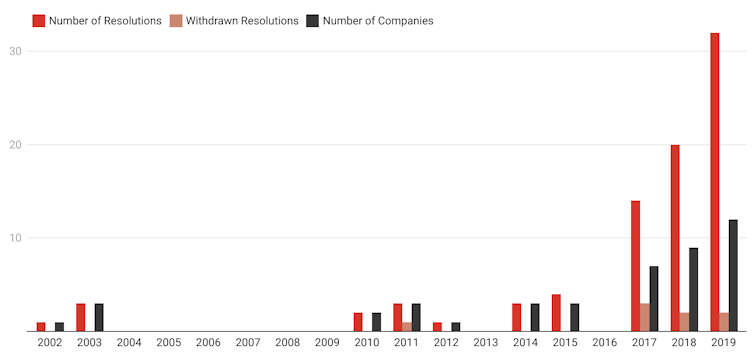
A record 36 shareholder ESG resolutions were put forward in 2020. So far in 2021 a further 20 have been put forward, with more foreshadowed.
The resolutions have been concentrated in a small number of companies and industries.
Four industries – energy, banking, insurance and materials – accounted for 83.5% of the resolutions, with the 139 resolutions recorded between 2002 and the first part of 2021 concentrated in only 28 companies.
They were generally the companies most exposed to the risk of climate change or which provide finance to these companies.
More Climate Resolutions Are Succeeding
Several have been subjected to more than one campaign a year. The company with the most is Origin Energy, facing 24 resolutions in the last six years.
Of the 83 shareholder ESG resolutions advanced between 2002 and 2019, 48 concerned climate change. A further 26 notionally related to governance, but the governance resolutions were often the ones needed to enable consideration of issues such as climate change.
The others related to workers’ rights, human rights, obtaining the consent of Aboriginal native title holders to fracking activities, and gambling.
Read more: Rio Tinto's climate resolution marks a significant shift in investor culture
Almost all were proposed by just two groups: the Australasian Centre for Corporate Responsibility and Market Forces.
Until last year the level of support garnered by shareholder ESG resolutions was small, averaging 9.7%. In 2020, support jumped to 14.7%.
In 2021 to date it has climbed to 28%, bolstered by two resolutions of Rio Tinto shareholders that attracted 99% after winning the support of Rio Tinto’s board.
Success Needn’t Mean Being Put To A Vote
Our study sought input from proponents of ESG resolutions, institutional shareholders, company directors, governance professionals and the Australian Securities and Investments Commission.
We found that winning votes isn’t the only objective of those who propose these resolutions.
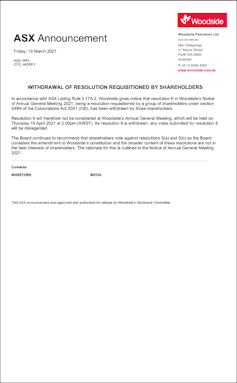
Another is to get companies to respond positively even though the resolutions will be defeated, and sometimes in return for the resolutions being withdrawn before the annual general meeting.
As an example, the Australasian Centre for Corporate Responsibility submitted a resolution for this year’s Woodside annual general meeting calling on the company to prepare an annual climate report that would include Woodside’s strategy to reduce its greenhouse gas emissions and put the report to a shareholder advisory vote.
It withdrew the resolution after Woodside announced it would put climate reporting to an advisory vote of shareholders at its 2022 annual general meeting.
Some of those we interviewed said shareholder ESG resolutions distracted the companies from what they should be doing.
Others said they ran the risk of blurring the distinct roles of directors and shareholders. Many said the process for getting shareholder ESG resolutions on the agenda for annual general meetings is cumbersome.
However, almost all of those interviewed – and not just the proponents of the resolutions – saw them as a valuable way of letting companies know what their shareholders really think about how they should respond to the challenges of climate change and other issues.![]()
Ian Ramsay, Emeritus Professor, Melbourne Law School, The University of Melbourne and Lloyd Freeburn, Research Fellow, Centre for Corporate Law, Melbourne Law School, University of Melbourne, The University of Melbourne
This article is republished from The Conversation under a Creative Commons license. Read the original article.
On Twitter, fossil fuel companies’ climate misinformation is subtle – here’s what I’m seeing during COP26

When oil and gas companies took to Twitter during the first half of the U.N.’s Glasgow climate conference, they often presented themselves as part of the solution to climate change and talked about energy security.
In many ways, their messaging on social media provides a window into how these companies want the public to see the future.
For example, while policymakers talk about a “low-carbon economy” – indicating that while there will be carbon in our lives, it will be as low as it can be – the tweets from some oil and gas accounts instead use the phrase “lower carbon.” A “lower carbon” economy is a far more nebulous goal that can involve continuing significant levels of fossil fuel use well into the future.
Social media is just the public face for these companies, many of which have lobbyists at the climate conference. Behind the scenes, the industry continues to invest in extracting fossil fuels that are driving climate change, and its CEOs have made clear that fossil fuel production will continue for decades to come.
Fossil Fuel Industry Misdirection
In 2015, when a colleague and I first researched what key fossil fuel trade groups were saying on Twitter about climate solutions during the landmark COP21 summit in Paris, we found they were largely promoting a narrative that the Obama administration’s climate policies lacked domestic support – despite public opinion research indicating otherwise.
This time around, using the consumer insights software Brandwatch, I studied recent English-language tweets from top oil, gas and coal producers globally during COP26, as well as from the American Petroleum Institute and the U.S. Chamber of Commerce. Executives from four oil companies, API and the U.S. Chamber of Commerce had been grilled by members of the House Committee on Oversight and Reform on Oct. 28, 2021, about their roles in the spread of misinformation about climate change.
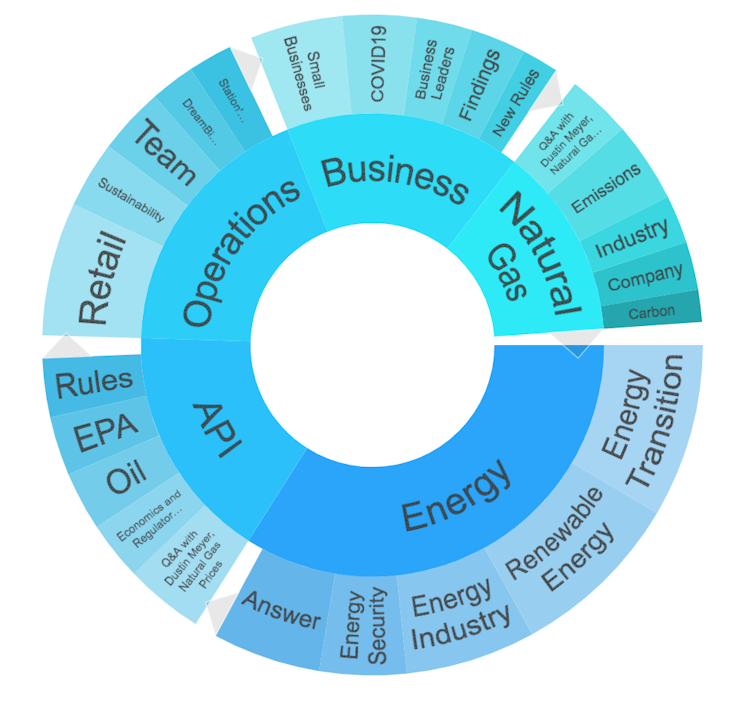
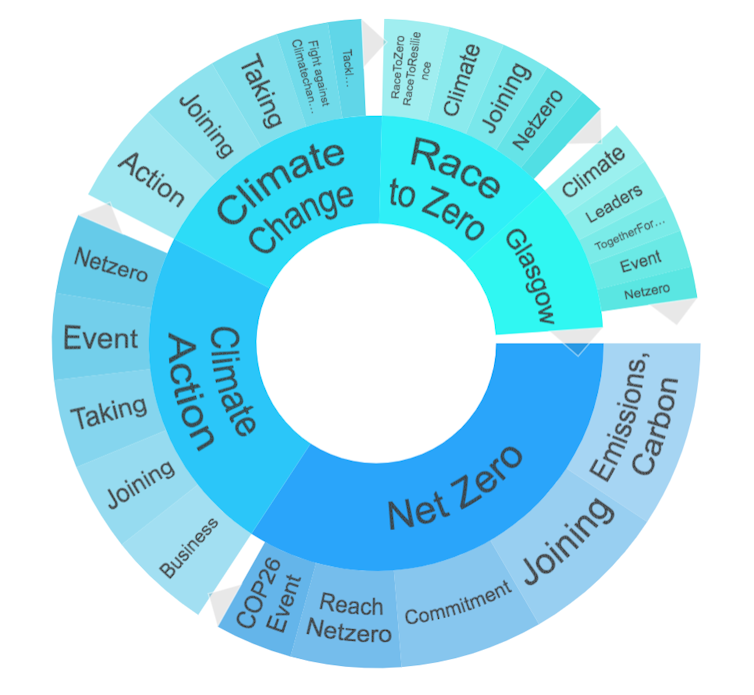
The corporate accounts today present themselves as part of the solution – for example, talking about renewable energy and electric vehicle charging infrastructure. Low-carbon projects are only a small part of the oil companies’ portfolios, though. And the same companies fueled the problem while knowing the risks.
This subtle form of misinformation, which scholars have called “fossil fuel solutionism,” involves cherry-picking data and talking points.
For example, a BP tweet saying that reducing methane emissions is key to “slowing the rate of warming” omits an important point. While addressing methane leaks from fossil fuel infrastructure is an important step, a fundamental shift away from fossil fuels is considered crucial.
The International Energy Agency predicts upstream oil and gas investment will increase by about 10% this year, though not to pre-pandemic levels, while clean energy investments remain “far short of what will be required to avoid severe impacts from climate change.”
The American Petroleum Institute in particular has been posting on themes of affordable, reliable, American-made energy and concern over gas prices while also claiming that restricting oil and gas drilling on federal land “would be counterproductive to our shared goal of reducing emissions.” API’s argument is that restrictions would increase use of coal and foreign imports.
Several posts employ a subtle shift in language to talk about technological innovation and energy transition in terms of “lower carbon,” rather than the more commonly heard discourse on “low carbon.” This shift appears to be recent. In the past, the theme appeared in discussions of natural gas as a “bridge fuel.”
The Black Box Of Digital Advertising
These accounts are only one piece of the industry’s social media ecosystem. The paid advertising footprint of oil and gas is much larger. It is also harder to track, especially on Twitter.
According to research by the nonprofit think tank InfluenceMap, the industry deploys Facebook ads at key political moments. For example, during Oct. 16-22, 2021, in the lead-up to the Congressional hearing with the oil CEOs and the recent elections, ExxonMobil spent $565,099 on Facebook ads targeting U.S. users.
Climate journalists Emily Atkin and Molly Taft found the lower-carbon theme in fossil fuel advertising within recent political newsletters.
For example, related to the U.N. climate conference, ExxonMobil is sponsoring the political news site The Hill’s energy and environment newsletter, along with the American Petroleum Institute. Some researchers refer to that as “fossil fuel corporate propaganda.” This amounts to a strategy to enhance corporate legitimacy while at the same time downplay the need for government regulation.
Part Of A Wider Problem
The structure of online social networks is characterized by polarization and echo chambers that allow misleading climate change content to spread.
An example is a tweet that got a lot of impressions at the start of COP26. It was a post from conservative commentator Ben Shapiro containing a logical fallacy in attempting to discredit the U.N.‘s climate work. Shapiro came in third for average reach during week one of the summit within a sample of climate change tweets, following only President Joe Biden and former President Barack Obama.
Social media companies have been under scrutiny for facilitating the wide spread of misinformation on several topics, including climate change.
In one analysis of Facebook pages, the environmental group Stop Funding Heat found nearly 39,000 posts with misinformation over eight months on 195 pages known for blatant climate misinformation. It also found a 76.7% increase in people interacting with those pages compared to the previous year, suggesting Facebook’s algorithm was sharing the content widely.
Taking a cue from climate disinformation researchers, Twitter launched what it calls “pre-bunks” – sending accurate messages out in search, explore and trends lists. But it didn’t plan to stop people and bots posting climate misinformation or label it as such. In the first 10 months of 2021, Twitter says climate change was mentioned 40 million times on its channels.
Read more: What Big Oil knew about climate change, in its own words
[Over 115,000 readers rely on The Conversation’s newsletter to understand the world. Sign up today.]![]()
Jill Hopke, Associate professor, DePaul University
This article is republished from The Conversation under a Creative Commons license. Read the original article.
Why the Australian government must listen to Torres Strait leaders on climate change
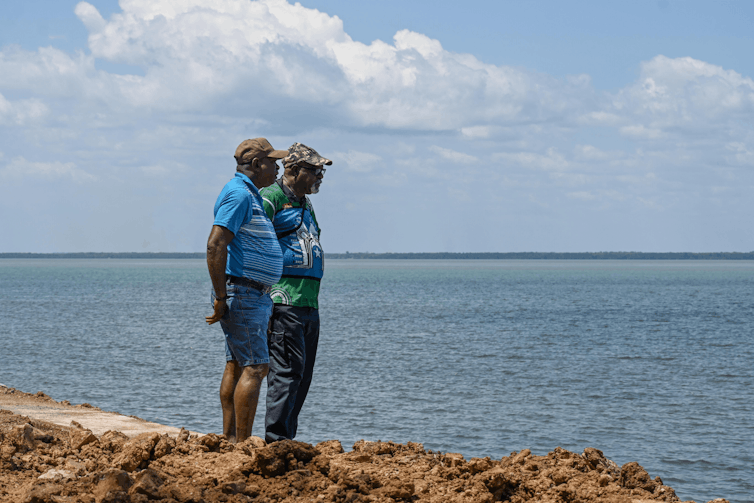
Last month, First Nations leaders Pabai Pabai and Paul Kabai filed a landmark class action against the Australian government to protect communities in the Torres Strait from climate change.
In the Torres Strait, First Nations communities are facing an existential threat as the planet warms. Rising seas are already inundating infrastructure and cultural sites, and some islands may be uninhabitable by the end of the century causing devastating harm to Torres Strait Islander Peoples and Ailan Kastom culture.
Mr. Pabai and Mr. Kabai have seen the impacts first hand. They have filed their class action to protect over 65,000 years of connection to land. Mr. Kabai has described the class action as answering their responsibility to community and culture.
We have a cultural responsibility to protect our communities, our culture and spirituality from climate change – for our ancestors and future generations.
Mr. Pabai and Mr. Kabai are part of a proud history of Torres Strait Islander Peoples fighting for their rights through the courts. They draw on the legacy of Eddie Mabo and his co-plaintiffs James Rice and David Passi, who took on the government and established that terra nullius was a lie, paving the way for Native Title recognition as we know it today.
Mr. Kabai and Mr. Pabai are also part of the foundational tradition of First Nation stewardship of land and water. As Traditional Owners, their knowledge and protection of Country is vital to tackling climate change.
Indigenous Peoples have always known this. Our communities have adapted and thrived together by caring for country for countless generations. The scientific community has only recently caught up.
In 2019, the Intergovernmental Panel on Climate Change recognised Indigenous Peoples, our knowledge and rights to land and water are key to tackling climate change.
Pabai And Kabai’s Case
In their class action, Mr. Pabai and Mr. Kabai will argue the Australian government has a duty to protect the people, islands, and culture of the Torres Strait. The duty arises from the common law of negligence, the Torres Strait Treaty (between Australia and Papua New Guinea, providing protection for the way of life of traditional peoples of the Torres Strait Protected Zone), and the Native Title rights of Torres Strait Islander Peoples.
The legal rights Torres Strait Islander Peoples hold as Traditional Owners of their lands and waters are central to Mr. Kabai and Mr. Pabai’s case. As is their deep spiritual and personal connection to the islands.
Mr. Kabai has further detailed that if the government’s climate failure continues they will lose everything.
Becoming climate refugees means losing everything: our homes, our culture, our stories and our identity […] If you take us away from this island then we’re nothing. It’s like the Stolen Generation, you take people away from their tribal land, they become nobodies.

The Australian government’s responsibility to Torres Strait Islander Peoples comes from the particular vulnerability of their communities to climate harms like sea level rise. Similar arguments have been made and won by the Sami people in Norway to protect their rights as part of climate change mitigation. Although in different legal and political contexts, both Indigenous rights and climate action are entrenched, structural priorities.
Mr. Pabai and Mr. Kabai will argue the government’s failure to reduce emissions will extinguish the Native Title rights of Torres Strait Islander Peoples as their traditional lands are lost beneath rising seas.
In court, they will urge the government to take pre-emptive steps to stop climate change impacts from destroying their islands – and with them, over 65,000 years of custom and culture protected by Native Title.
The government’s responsibility to act is also said to come from legal protections provided by the Torres Strait Treaty. Australia entered into the Treaty with Papua New Guinea in 1978, after grassroots political pressure from Torres Strait Islander leaders like Getano Lui Snr.
The Treaty created a protected zone to acknowledge and protect the traditional way of life of Torres Strait Islander Peoples and requires the Australian government to prevent damage to the marine environment of the Torres Strait.
These protections exist to preserve the deep spiritual connection First Nations communities have to their islands and waters.
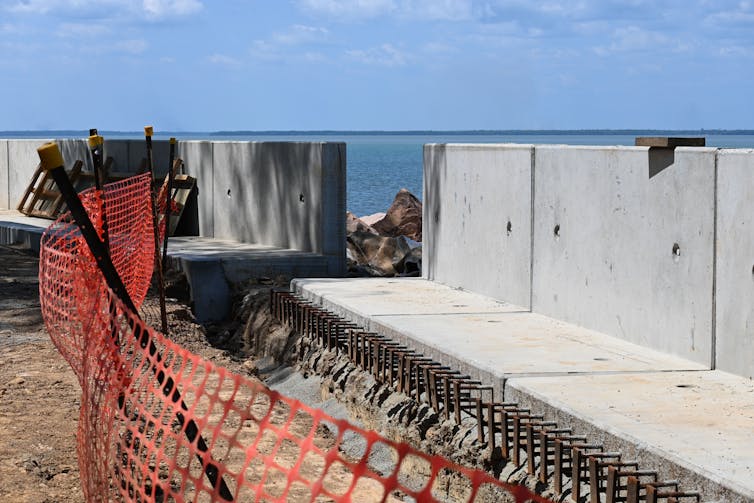
The importance of this connection to Country has been recognised by the High Court. In 2019, the court found the Northern Territory government was responsible for spiritual hurt caused to Ngaliwurru and Nungali native title holders by the building of roads and infrastructure on their traditional lands.
It is this combination of legal rights – unique to Torres Strait Islander Peoples – that Mr. Pabai and Mr. Kabai will rely on to ask the court to create a new duty of care.
Recent Developments
Earlier this year, the Federal Court found a novel duty of care not to cause climate harm to young people. The Court found that the minister for the environment had a responsibility to take reasonable care to avoid harm to children caused by greenhouse gas emissions when exercising her power to approve new coal mining.
Mr. Pabai and Mr. Kabai’s case is the first of its kind because it argues a far broader case: that the Australian government has a duty to protect the Torres Strait from climate harm.
While this may sound ambitious, these kinds of cases have worked before. Most notably, in the Netherlands, where the Urgenda Foundation and 886 people took the Dutch government to court for climate inaction – and won.
The Urgenda Foundation has partnered with Mr. Pabai and Mr. Kabai on their case, and the circumstances are similar. Both communities live on land perilously exposed to rising sea levels and face severe harm from climate change.
Read more: If governments fail to act, can the courts save our planet?
A Legacy Of Nation Shaping
First Nations communities have a history of bringing legal cases vital to the development of Australian law. Often against the odds.
Mabo’s legal victory placed the Torres Strait at the centre of a transformation in the way the Australian nation places itself in a long history of Indigenous ownership and connection. Mr. Kabai and Mr. Pabai are inspired by that legacy.
As world leaders meet in Glasgow for the COP26 climate summit, billed as a “last chance” for real climate action, Mr. Pabai and Mr. Kabai are asking the Australian government to step up and stop causing harm.
Their class action could prevent extreme climate harm for all Torres Strait Islander Peoples, and all Australians.
It is a vitally important case. It is also an action taken by traditional owners that highlights our continued commitment to country over countless generations, a commitment that is a proven practice of providing for all of existence.![]()
Eddie Synot, Lecturer, Griffith Law School, Griffith University
This article is republished from The Conversation under a Creative Commons license. Read the original article.
COP26: meat eating is a big climate issue – but isn’t getting the attention it deserves
Emma Garnett, University of CambridgeUK prime minister Boris Johnson launched the COP26 climate summit in Glasgow with the mantra of “coal, cars, cash and trees”. But thus far the summit has largely ignored the elephant in the room. Or rather, the cows, pigs, chickens and fish.
The global food system is currently responsible for about a quarter of all human made greenhouse gases, a figure that is projected to increase. The increase in food system emissions alone threatens warming above 1.5℃. There is no doubt we need to stop burning fossil fuels, but reducing livestock consumption in high- and middle-income countries is also vital to both protect the climate and restore nature.
Governments at COP26 have pledged to halt deforestation and cut methane emissions 30% by 2030. Eating lots of meat is a big driver of both, but so far no reduction targets have been announced. The pledge to protect nature signed by 45 governments didn’t mention meat consumption at all, while the US agriculture secretary claimed in an interview that Americans don’t need to produce or eat less meat at all.
Here are four reasons why less meat (and dairy) on our plates needs to be on the table at COP26.
1. Livestock Have High Carbon Footprints
It is not very efficient to feed plants to livestock when we could eat the plants directly ourselves. Even though cows, sheep and goats can eat grass, unlike humans, they still need lots of land for grazing which could otherwise store more carbon dioxide as natural forests, grasslands or bogs, or in some cases be used to grow plant crops for human consumption. These animals also produce substantial amounts of methane in their digestive systems, which is a powerful greenhouse gas.
The carbon footprint of beef and lamb is roughly three times higher than that of pork, poultry or farmed fish per 100g of protein, and 24 times higher than pulses such as beans and lentils. Livestock produces just 18% of global calories and 37% of protein, but is responsible for more than half of food’s greenhouse gas emissions.
Small amounts of meat and dairy have a role in sustainable food systems, while some plants have quite high environmental impacts and some nuts use lots of water. But in general, even meat with the lowest carbon footprints still has higher emissions than the highest emitting plant-based foods which are high in protein.
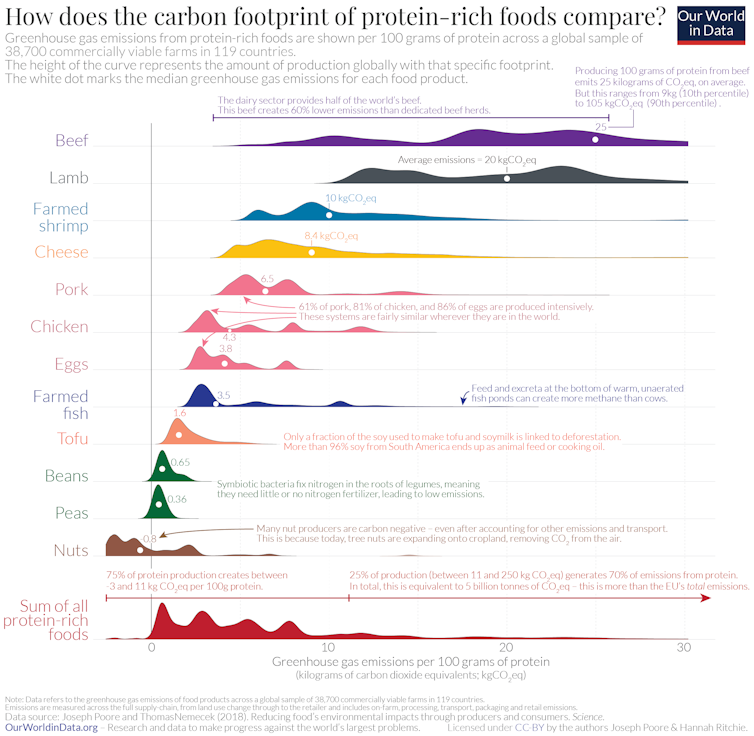
2. Reducing Livestock Production Would Protect Nature
Farmland takes up 50% of Earth’s habitable land, and the vast majority of that farmland is used for livestock and their feed. Farming is the leading cause of natural habitat loss, which is the biggest threat to wildlife. Beef production is the top driver of tropical forest loss.
Eating more meat means that more natural habitat needs to be cleared and deforested, and the diets of people in high- and middle-income countries can be key drivers of global deforestation. Conversely, reducing meat consumption would free up land which could be restored to benefit people and wildlife, and store carbon.

3. Meat Production Has Quadrupled Since The 1960s
Since 1961, meat production worldwide has quadrupled as meat supply per person has almost doubled (from 23kg to more than 43kg) and the human population has more than doubled (from 3 billion to 7 billion).
The number of animals slaughtered each year has consequently skyrocketed. The number of chickens killed each year has increased tenfold since the 1960s (from 6.6 billion to 68.8 billion), pigs have almost quadrupled (0.4 billion to 1.5 billion) and cows have increased from 0.2 billion to 0.3 billion.
Meat consumption is also very unevenly distributed. Just as richer countries tend to have higher greenhouse gas emissions, they also tend to eat more meat. For example, the average US citizen is supplied with 124kg of meat a year, whereas in China, Nigeria and India it’s 61kg, 7kg and 4kg respectively.
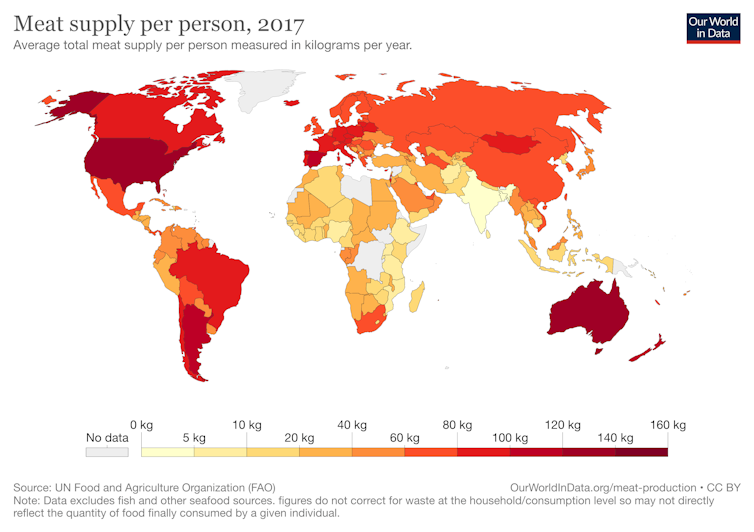
4. More Sustainable Means More Healthy
Healthy and sustainable diets broadly overlap: diets with small amounts of red and processed meat, and high in vegetables, wholegrains and pulses. There are some important exceptions: oily fish benefits health but the fuel used by fishing boats means it generally has higher greenhouse gas emissions than plant-based proteins, while many fish populations are overfished. Sugar, on the other hand, has a relatively low environmental impact but doesn’t have any nutritional value besides calories.
The Planetary Health Diet – a healthy diet designed to minimise environmental damage – recommends on average three small portions of meat, two small portions of fish and seven glasses of milk a week. However, many of the poorest people in low-income countries eat less meat and fish than this or don’t have access to healthy alternative foods. They could benefit from increasing, not decreasing, the amount of animal products they eat. This makes it even more vital that people eating lots of meat, fish and dairy cut back.
There are many different policies that could make healthy and sustainable diets more accessible. These include removing subsidies for livestock farming, helping livestock farmers to transition to alternative farming systems, making menus mostly plant-based, and promoting behaviour changes through prominent positioning and cheaper prices for healthy and sustainable food. Education and public information – while important – won’t be enough by themselves. We need to step up to the plate: the planet depends on it.

This story is part of The Conversation’s coverage on COP26, the Glasgow climate conference, by experts from around the world.
Amid a rising tide of climate news and stories, The Conversation is here to clear the air and make sure you get information you can trust. More. ![]()
Emma Garnett, Sustainability Research Fellow, University of Cambridge
This article is republished from The Conversation under a Creative Commons license. Read the original article.
COP26: why education for girls is crucial in the fight against climate change
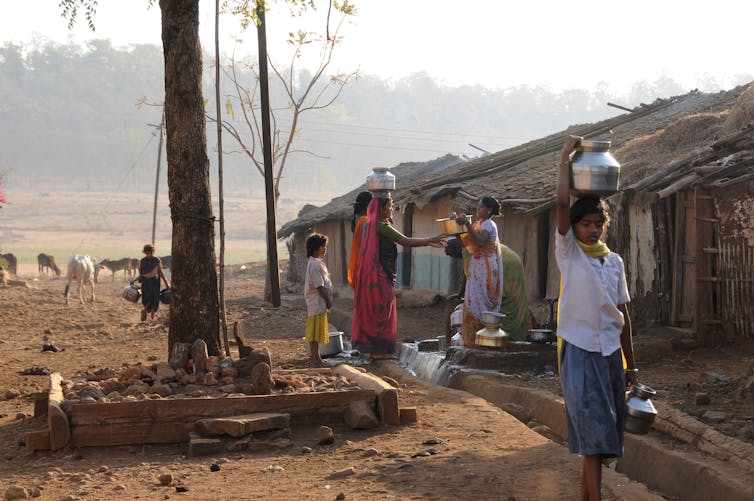
The Glasgow climate change conference is in its second week, with Tuesday November 9 dedicated to recognising gender equality, and the empowerment of women and girls in climate policy and action.
Gender inequality means women and girls will experience climate change in unique and different ways. They are more likely to die in extreme weather events than men. And as climate change brings about forced migration, loss of housing and income, they are vulnerable to gender-based violence.
Child marriage is a common coping mechanism for many families facing climate stress. For example, in 2016 a 15-year-old girl in Mozambique was married in exchange for 2,000 Mozambican Metical (approximately A$42) to forestall her family’s climate-induced poverty.
There is also strong evidence regarding the impact of climate change on girls’ education. In particular, it will exacerbate the already existing barriers girls face. These include learning disruptions due to inadequate funds for school fees, as well as food, water and menstrual hygiene products. During natural disasters girls experience an increase in care work and disruptions due to forced displacement or migration.
Read more: COVID is forcing millions of girls out of school in South-east Asia and the Pacific
The Malala Fund estimates the climate events of 2021 will prevent at least 4 million girls from completing their education. Similarly, a new report from NGO Plan International shows if current trends continue, by 2025 climate change will be a contributing factor in preventing at least 12.5 million girls each year from completing their education. The report states:
Even though girls are significantly impacted by climate change, they are also powerful agents of change, capable of strengthening a country’s response to climate change.
Why Education For Girls Is Crucial
In describing the COP26 summit as “a two-week long celebration of business as usual and blah, blah, blah,” activist Greta Thunberg summed up the attitude of many young people protesting around the world. That is, political leaders are protecting their own interests at the expense of future generations.
The growing youth activism is acknowledgement this damaged planet is theirs to inherit and fix. Young people in our region will endure an increase in severe weather events, a rise in food insecurity, challenges to their health from poorer air quality and pollution, and the impact of species’ extinction and biodiversity change.
In the face of these challenges, education for all young people is crucial. But in particular, education, empowerment and leadership of girls and young women is the key to climate resilience.
Project Drawdown, a global research project which identifies and assesses solutions to climate change, notes that education
shores up resilience and equips girls and women to face the impacts of climate change. They can be more effective stewards of food, soil, trees, and water, even as nature’s cycles change.

Education for girls can be a pathway for fighting the climate crisis in three key ways:
education in both the sciences and social sciences is necessary to address climate change. Girls’ participation in these fields will drive innovation in green technologies as well as a social approach to resilience built on equality
formal education can build on women and girls’ existing community-based knowledge regarding disaster risk reduction and help them respond to climate emergencies
education creates pathways to more independent decision-making for women and girls around work, family planning and community engagement. It also creates opportunities for leadership and participation in formal decision-making.
Girls and young women are already leading the way in climate responses in the region. For example, 17-year-old Anjali Sharma led a landmark class action – with seven other teenagers – in the Australian Federal Court against Australia’s environment minister Sussan Ley. The group was seeking an injunction to prevent Ley approving a coal mine expansion, arguing it would contribute to climate change which endangers their future.
The Malala Fund also iterates the importance of investing in girls’ education in the fight against climate change. It argues such investment increases social resilience and strengthens adaption and mitigation efforts.
Australia Can Do More
The Plan International report shows that in 2019, Australia spent A$516 million of its official development assistance on projects which targeted action against climate change.
That represents just 25% of Australia’s development assistance, putting Australia in 12th place among the OECD’s 30 development committee donors.
Plan International’s report also shows climate education is absent in Australia’s recent development policies and education strategies. For instance, Australia’s Partnerships for Recovery: Australia’s COVID-19 Development Response’ policy — launched in May 2020 — fails to mention climate change among the three pillars of Australia’s Department of Foreign Affairs and Trade.
Read more: Ever wondered what our curriculum teaches kids about climate change? The answer is 'not much'
Young people are demanding change from those in power, organising in their communities to educate one another, engaging in activities to protect the environment and adapt to its changes, and demanding to be heard.
Australia must be more ambitious in ensuring youth and young women are prepared for the challenges ahead. By prioritising girls’ education in its funding and partnerships for regional development, Australia can promote gender equitable climate leadership.
Political leaders have a responsibility not only to engage and respond to young people, but also to build their capacity to face climate change, now and in the future.![]()
Betty Barkha, PhD Candidate, Monash University and Katrina Lee-Koo, Associate Professor of International Relations, Monash University
This article is republished from The Conversation under a Creative Commons license. Read the original article.
Bushcare In Pittwater
Where we work Which day What time
Avalon
Angophora Reserve 3rd Sunday 8:30 - 11:30am
Avalon Dunes 1st Sunday 8:30 - 11:30am
Avalon Golf Course 2nd Wednesday 3 - 5:30pm
Careel Creek 4th Saturday 8:30 - 11:30am
Toongari Reserve 3rd Saturday 9 - 12noon (8 - 11am in summer)
Bangalley Headland 2nd Sunday 9 to 12noon
Bayview
Winnererremy Bay 4th Sunday 9 to 12noon
Bilgola
North Bilgola Beach 3rd Monday 9 - 12noon
Algona Reserve 1st Saturday 9 - 12noon
Plateau Park 1st Friday 8:30 - 11:30am
Church Point
Browns Bay Reserve 1st Tuesday 9 - 12noon
McCarrs Creek Reserve Contact Bushcare Officer To be confirmed
Clareville
Old Wharf Reserve 3rd Saturday 8 - 11am
Elanora
Kundibah Reserve 4th Sunday 8:30 - 11:30am
 Mona Vale
Mona Vale Mona Vale Beach Basin 1st Saturday 8 - 11am
Mona Vale Dunes 2nd Saturday +3rd Thursday 8:30 - 11:30am
Newport
Bungan Beach 4th Sunday 9 - 12noon
Crescent Reserve 3rd Sunday 9 - 12noon
North Newport Beach 4th Saturday 8:30 - 11:30am
Porter Reserve 2nd Saturday 8 - 11am
North Narrabeen
Irrawong Reserve 2nd Saturday 2 - 5pm
Palm Beach
North Palm Beach Dunes 3rd Saturday 9 - 12noon
Scotland Island
Catherine Park 2nd Sunday 10 - 12:30pm
Elizabeth Park 1st Saturday 9 - 12noon
Pathilda Reserve 3rd Saturday 9 - 12noon
Warriewood
Warriewood Wetlands 1st Sunday 8:30 - 11:30am
Whale Beach
Norma Park 1st Friday 9 - 12noon
Western Foreshores
Coopers Point, Elvina Bay 2nd Sunday 10 - 1pm
Rocky Point, Elvina Bay 1st Monday 9 - 12noon
Gardens And Environment Groups And Organisations In Pittwater
Avalon Golf Course Bushcare Needs You


Pittwater Reserves + Others
A History Of The Campaign For Preservation Of The Warriewood Escarpment by David Palmer OAM and Angus Gordon OAM
Angophora Reserve - Angophora Reserve Flowers
Annie Wyatt Reserve - A Pictorial
Avalon's Village Green: Avalon Park Becomes Dunbar Park - Some History + Toongari Reserve and Catalpa Reserve
Bairne Walking Track Ku-Ring-Gai Chase NP by Kevin Murray
Bangalley Headland Bangalley Mid Winter
Banksias of Pittwater
Barrenjoey Headland: Spring flowers Barrenjoey Headland after fire
Bayview Baths
Bayview Wetlands
Beeby Park
Bilgola Beach
Botham's Beach
Bungan Beach Bush Care
Careel Bay Saltmarsh plants
Careel Bay Birds
Careel Bay Clean Up day
Careel Bay Playing Fields History and Current
Careel Creek
Careel Creek - If you rebuild it they will come
Centre trail in Ku-ring-gai Chase National Park
Chiltern Track- Ingleside by Marita Macrae
Clareville Beach
Clareville/Long Beach Reserve + some History
Coastal Stability Series: Cabbage Tree Bay To Barrenjoey To Observation Point by John Illingsworth, Pittwater Pathways, and Dr. Peter Mitchell OAM
Cowan Track by Kevin Murray
Curl Curl To Freshwater Walk: October 2021 by Kevin Murray and Joe Mills
Currawong and Palm Beach Views - Winter 2018
Currawong-Mackerel-The Basin A Stroll In Early November 2021 - photos by Selena Griffith
Currawong State Park Currawong Beach + Currawong Creek
Deep Creek To Warriewood Walk photos by Joe Mills
Drone Gives A New View On Coastal Stability; Bungan: Bungan Headland To Newport Beach + Bilgola: North Newport Beach To Avalon + Bangalley: Avalon Headland To Palm Beach
Dunbar Park - Some History + Toongari Reserve and Catalpa Reserve
Dundundra Falls Reserve: August 2020 photos by Selena Griffith - Listed in 1935
Elsie Track, Scotland Island
Elvina Track in Late Winter 2019 by Penny Gleen
Elvina Bay Walking Track: Spring 2020 photos by Joe Mills
Elvina Bay-Lovett Bay Loop Spring 2020 by Kevin Murray and Joe Mills
Fern Creek - Ingleside Escarpment To Warriewood Walk + Some History photos by Joe Mills
Ingleside
Ingleside Wildflowers August 2013
Irrawong - Ingleside Escarpment Trail Walk Spring 2020 photos by Joe Mills
Irrawong - Mullet Creek Restoration
Katandra Bushland Sanctuary - Ingleside
McCarrs Creek
McCarr's Creek to Church Point to Bayview Waterfront Path
McKay Reserve
Mona Vale Beach - A Stroll Along, Spring 2021 by Kevin Murray
Mona Vale Headland, Basin and Beach Restoration
Mount Murray Anderson Walking Track by Kevin Murray and Joe Mills
Mullet Creek
Narrabeen Creek
Narrabeen Lagoon Catchment: Past Notes Present Photos by Margaret Woods
Narrabeen Lagoon State Park
Narrabeen Lagoon State Park Expansion
Narrabeen Rockshelf Aquatic Reserve
Nerang Track, Terrey Hills by Bea Pierce
Newport Bushlink - the Crown of the Hill Linked Reserves
Newport Community Garden - Woolcott Reserve
Newport to Bilgola Bushlink 'From The Crown To The Sea' Paths: Founded In 1956 - A Tip and Quarry Becomes Green Space For People and Wildlife
Pittwater spring: waterbirds return to Wetlands
Pittwater's Lone Rangers - 120 Years of Ku-Ring-Gai Chase and the Men of Flowers Inspired by Eccleston Du Faur
Pittwater's Parallel Estuary - The Cowan 'Creek
Riddle Reserve, Bayview
Salvation Loop Trail, Ku-Ring-Gai Chase National Park- Spring 2020 - by Selena Griffith
Stapleton Reserve
Stapleton Park Reserve In Spring 2020: An Urban Ark Of Plants Found Nowhere Else
The Chiltern Track
The Resolute Beach Loop Track At West Head In Ku-Ring-Gai Chase National Park by Kevin Murray
Towlers Bay Walking Track by Joe Mills
Trafalgar Square, Newport: A 'Commons' Park Dedicated By Private Landholders - The Green Heart Of This Community
Turimetta Beach Reserve by Joe Mills, Bea Pierce and Lesley
Turimetta Beach Reserve: Old & New Images (by Kevin Murray) + Some History
Turimetta Headland
Warriewood Wetlands and Irrawong Reserve
Whale Beach Ocean Reserve: 'The Strand' - Some History On Another Great Protected Pittwater Reserve
Winji Jimmi - Water Maze

New Shorebirds WingThing For Youngsters Available To Download
A Shorebirds WingThing educational brochure for kids (A5) helps children learn about shorebirds, their life and journey. The 2021 revised brochure version was published in February 2021 and is available now. You can download a file copy here.
If you would like a free print copy of this brochure, please send a self-addressed envelope with A$1.10 postage (or larger if you would like it unfolded) affixed to: BirdLife Australia, Shorebird WingThing Request, 2-05Shorebird WingThing/60 Leicester St, Carlton VIC 3053.

 Shorebird Identification Booklet
Shorebird Identification Booklet
The Migratory Shorebird Program has just released the third edition of its hugely popular Shorebird Identification Booklet. The team has thoroughly revised and updated this pocket-sized companion for all shorebird counters and interested birders, with lots of useful information on our most common shorebirds, key identification features, sighting distribution maps and short articles on some of BirdLife’s shorebird activities.
The booklet can be downloaded here in PDF file format: http://www.birdlife.org.au/documents/Shorebird_ID_Booklet_V3.pdf
Paper copies can be ordered as well, see http://www.birdlife.org.au/projects/shorebirds-2020/counter-resources for details.
Download BirdLife Australia's children’s education kit to help them learn more about our wading birdlife
Shorebirds are a group of wading birds that can be found feeding on swamps, tidal mudflats, estuaries, beaches and open country. For many people, shorebirds are just those brown birds feeding a long way out on the mud but they are actually a remarkably diverse collection of birds including stilts, sandpipers, snipe, curlews, godwits, plovers and oystercatchers. Each species is superbly adapted to suit its preferred habitat. The Red-necked Stint is as small as a sparrow, with relatively short legs and bill that it pecks food from the surface of the mud with, whereas the Eastern Curlew is over two feet long with a exceptionally long legs and a massively curved beak that it thrusts deep down into the mud to pull out crabs, worms and other creatures hidden below the surface.
Some shorebirds are fairly drab in plumage, especially when they are visiting Australia in their non-breeding season, but when they migrate to their Arctic nesting grounds, they develop a vibrant flush of bright colours to attract a mate. We have 37 types of shorebirds that annually migrate to Australia on some of the most lengthy and arduous journeys in the animal kingdom, but there are also 18 shorebirds that call Australia home all year round.
What all our shorebirds have in common—be they large or small, seasoned traveller or homebody, brightly coloured or in muted tones—is that each species needs adequate safe areas where they can successfully feed and breed.
The National Shorebird Monitoring Program is managed and supported by BirdLife Australia.
This project is supported by Glenelg Hopkins Catchment Management Authority and Hunter Local Land Services through funding from the Australian Government’s National Landcare Program. Funding from Helen Macpherson Smith Trust and Port Phillip Bay Fund is acknowledged.
The National Shorebird Monitoring Program is made possible with the help of over 1,600 volunteers working in coastal and inland habitats all over Australia.
The National Shorebird Monitoring program (started as the Shorebirds 2020 project initiated to re-invigorate monitoring around Australia) is raising awareness of how incredible shorebirds are, and actively engaging the community to participate in gathering information needed to conserve shorebirds.
In the short term, the destruction of tidal ecosystems will need to be stopped, and our program is designed to strengthen the case for protecting these important habitats.
In the long term, there will be a need to mitigate against the likely effects of climate change on a species that travels across the entire range of latitudes where impacts are likely.
The identification and protection of critical areas for shorebirds will need to continue in order to guard against the potential threats associated with habitats in close proximity to nearly half the human population.
Here in Australia, the place where these birds grow up and spend most of their lives, continued monitoring is necessary to inform the best management practice to maintain shorebird populations.
BirdLife Australia believe that we can help secure a brighter future for these remarkable birds by educating stakeholders, gathering information on how and why shorebird populations are changing, and working to grow the community of people who care about shorebirds.
To find out more visit: http://www.birdlife.org.au/projects/shorebirds-2020/shorebirds-2020-program
Aussie Bread Tags Collection Points

Iris Murdoch: what the writer and philosopher can teach us about friendship

Making friends might come easier to some people than others, but in general, we all use the same criteria for forming relationships. We are drawn to people who share our interests, or who we simply like and admire.
Once we make friends, we tend to hold them in high esteem. We speak positively about our friends, sometimes ignoring or downplaying their negative qualities. For many people, this positive outlook is the core of friendship – being a “good” friend is a matter of thinking and feeling positively about them, as well as acting in caring ways towards them.
This type of friendship is what I’ll call “knowledge-free” – it involves no requirement to really know or understand the other person. On the flip side, this view of friendship suggests that having negative beliefs about your friends (even if those beliefs are warranted) makes you a worse friend.
As an ethicist who has researched friendship and virtue, this view of friendship just doesn’t seem right to me. It doesn’t capture all of what we want from friendship. I have studied the work of British-Irish novelist and philosopher Iris Murdoch – and I suggest that her writings provide us with a fuller view of friendship.
Murdoch occupied a rare niche in 20th century philosophy, as a woman working in a fairly male-dominated field. She was also a Platonist interested in the reality of “the Good” in an era when such metaphysical theorising was deeply unpopular. A highly successful novelist, Murdoch’s many books explore the trials and tribulations of intimate relationships.
Love Is Knowledge
Much of Murdoch’s philosophical work examines the moral significance of love (which I take to be part of friendship). She regarded love as a central part of our moral life that had been unjustly ignored in the moral philosophy of her era, in favour of an endless focus on the function of moral language.
Unlike the view of friendship I described earlier, Murdoch’s conception of love is not “knowledge-free”. Instead, she suggests that understanding the other person is an integral part of love (and therefore of friendship, which plausibly involves love).
Take the following passages:
Love is the perception of individuals. … Love … is the discovery of reality. (The Sublime and The Good, 1959)
Love is knowledge of the individual. (The Sovereignty of Good, 1970)
You can see in these quotes Murdoch’s view of love is knowledge of the other person, or seeing them as they really are –- it involves understanding them as a person, both their positive and negative qualities.
Notably, Murdoch thinks that really knowing or understanding another person is a difficult task: “It is a task to come to see the world as it is”. According to the Freudian psychology Murdoch subscribes to in The Sovereignty of Good, humans are prone to “fantasy” – refusing to face the truth because it can damage our fragile egos.
So while we may have a natural, selfish tendency to believe reassuring fantasies about the goodness of other people (especially our friends), true friendship requires us to be patient, kind and accepting of their negative qualities too.
Loving Attention
Being a good friend to others thus involves what Murdoch calls “loving attention”: regarding them in a patient, caring way, and always trying to do justice to who they really are.
In a Murdochian view of friendship, being a good friend involves knowing or understanding our friends more fully. Think about the way a friendship develops: One might initially know a few facts about a friend’s interests, such as that they enjoy classical music. Over time, a good friend would not simply know that their friend enjoys classical music, but exactly what kind of music they like, what it is that they like about it, and the importance that it has in their life. This deepening understanding of the other person naturally leads to a more fulfilling friendship.
Murdochian friendship therefore rules out the idea that being a good friend requires having positive – but false – beliefs about one’s friends. If friendship involves true knowledge of another person, it can’t require us to have untrue beliefs about them.
How might this relate to the other things we usually expect of friends, such as that they treat us well, and help us when we need it? Once we truly, lovingly see and understand another person, the right way to behave towards them will follow naturally. We won’t have to ask ourselves things like “should I bother helping my friend who is in need?”, because seeing their need will itself compel us to act rightly.
Think about Iris Murdoch the next time a friend of yours does or says something you disagree with. Instead of ignoring their flaw or mistake, try to accept it as part of their whole – it may even strengthen your friendship.![]()
Cathy Mason, Leverhulme Early Career Fellow in Philosophy, University of Cambridge
This article is republished from The Conversation under a Creative Commons license. Read the original article.
Free Training To Support Push For The Bush This Summer
November 5, 2021
Young people are being encouraged to skill up this summer and support the regions with 10,000 free training places across more than 800 courses now available to study.
The NSW Government today launched its Summer Skills program, offering free training in critical industries delivered by TAFE NSW and 120 registered training providers.
Deputy Premier and Minister for Regional NSW Paul Toole said in-demand short courses including construction, agriculture, hospitality, animal studies, shearing and wool harvesting, were available to study for free for people aged 16-24 years.
“We’re encouraging young people to go bush and combine learning with on-the-job experience this summer to support regional industries,” Mr Toole said.
“Now is the perfect time to get out, go and pick fruit in the regions, learn how to make a great coffee working for a local cafe or lend a hand to our farmers with free training funded by the NSW Government.”
Minister for Skills and Tertiary Education Geoff Lee said it was a great opportunity for young people to take advantage of new freedoms in NSW.
“It’s been a challenging period especially for our young people, which is why we’re committed to skilling them up to take on a job anywhere in NSW ahead of a bumper summer,” Mr Lee said.
“This is about giving school leavers a leg up in their career and the opportunity to put their skills to use after what has been a challenging year.”
Minister for Regional Youth Bronnie Taylor said the program will ensure young people have the confidence and skills they need for the next steps in their life.
“Our young people have really felt the impacts of this pandemic, whether it was having to learn from home, losing their part-time job or not being able to catch up with their mates,” Mrs Taylor said.
“This program is great news for our young people and will open so many future employment opportunities close to home, ensuring our rural and regional communities continue to thrive.”
Celebrity Chef and Thankful4Farmers ambassador Matt Moran said encouraging young people to explore the regions and learn new skills was a great solution to the skills shortages the regions are facing.
“This is a fantastic opportunity to have a fun-filled adventure in our backyard, while also making a real difference in the community, learning valuable skills and forging new friendships along the way,” Mr Moran said.
Summer Skills program is funded under the joint Federal and State JobTrainer program and is available to people aged 16 to 24 who have left school and are living or working in NSW.
Summer Skills short courses include:
- Accounting
- Agriculture
- Animal Studies
- Hospitality
- Construction
- Process Manufacturing
- Transport and Logistics
- Shearing and Wool Harvesting
- Drone Essentials
- Care Roles Skillset
Online Service To Match Jobseekers To Jobs
Scholarships Open For Vulnerable Youth
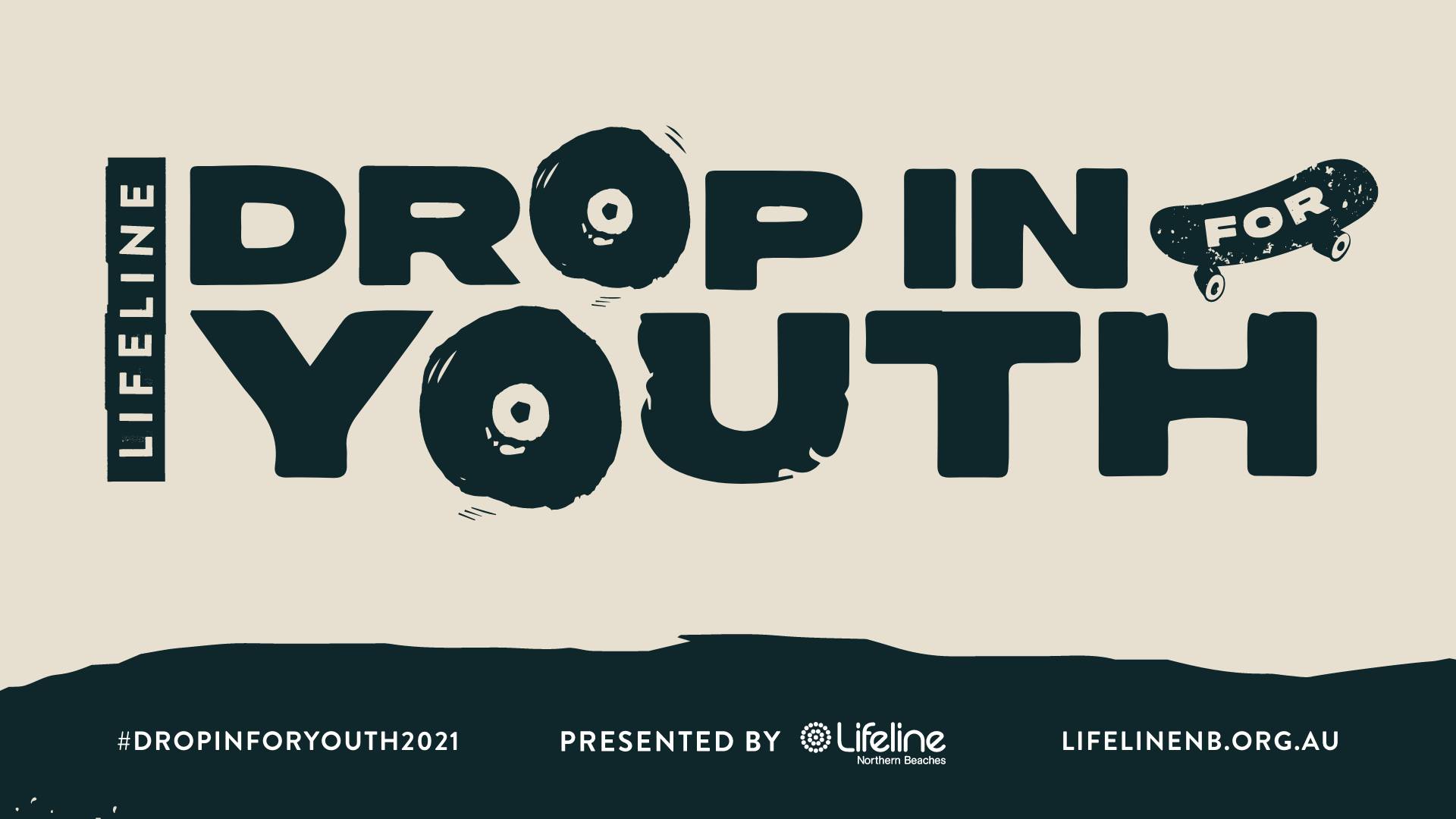
JOIN Ruby “Rockstar” Trew at DROP IN for YOUTH 2021
SKATE VERT COMP
+ Skate Park Fun - BEST Limbo, Highest Ollie, Board Jump and Trick Jam
OVER $10,000 in CASH - PRIZES - GIVEAWAYS to be WON!
DJ - FOOD TRUCKS - CAFE
SATURDAY 11 DECEMBER 2021 9:30AM
@MONA VALE SKATE PARK, 1604 Pittwater Road, Mona Vale
Saturday, 11 December 2021; 09:30 am- $15 entry online. $20 entry on event day, rego opens 9:30am. Vert Comp kicks off 10:30am.
Tickets: https://lifelinenb.grassrootz.com/drop-in-for-youth-2021
SKATE VERT COMP Kicks off 10:30am
Divisions:
- - 6 & Under - Girls and Boys
- - 8 & Under - Girls and Boys
- - 12 & Under - Girls and Boys
- - 16 & Under - Girls and Boys
- - Open Women’s - All Ages
- - Open Men’s - All Ages
- - Masters 45+ - Women's and Men's
EVENT T&C's
Participants can only compete in a single category for the event. Age Group participants are competing for prizes. Entry into the Open category is for anyone who wants to compete for prize money.
Open and Masters participants are competing for ca$h and GLORY!
Skate Park Fun - BEST Limbo, Highest Ollie, Board Jump and Trick Jam competitions are for everyone to have some fun!
Presented by: Avalon Youth Hub - Business Education Network (THE BEN) - Hurley ANZ - Lifeline Northern Beaches - Modest Eyewear Co - Monster Skate Park - Rotaract - Skater HQ
Lifeline Northern Beaches is offering FREE face-to-face counselling at the Avalon Youth Hub for people aged 15-24. Counselling is safe and confidential, and our service is available with or without a referral. For more information, visit www.lifelinenb.org.au/avalon-youth-hub. To book an appointment, call Lifeline Northern Beaches on 9949 5522 or email counselling@lifelinenb.org.au
TAFE NSW Grows Workers To Stem National Skills Shortage
TAFE NSW is helping the arboriculture industry tackle a growing national skills shortage by training up and instilling a passion for the industry in workers like Sydney-based arborist Dalton Wills.
The 30-year-old from Coogee was working in the tree business as a labourer when he decided to upskill and enrolled in a Certificate III in Arboriculture at TAFE NSW Ryde.
He said joining the world-class horticultural college at Ryde led to a full-time position with Woollahra Municipal Council and gave him a deep appreciation for the beauty, environmental value, and public benefit of trees.
“Before, my work was just about making money, but the team at TAFE NSW helped me understand that it’s a really important responsibility to take care of trees and our public green spaces,” Dalton said.
“It’s given me a whole new perspective and it’s no longer just a job but a career that I love. Our team at Woollahra Council manages more than 20,000 trees. It’s our responsibility to care for them and ensure they remain healthy now and for future generations.”
Arboriculture Australia, the national peak body representing the industry, describes the current national skills shortage as “critical” while a Department of Education, Skills and Employment occupation report reveals only 15% of job vacancies in the industry are filled.
Dalton said TAFE NSW teachers taught him all the skills to step straight into work as well as a philosophical understanding of arboriculture, such as the broader context for why trees are so important to society.
“We learn to treat removal as a last resort because trees hold so much social, environmental, and economic value in the ground. It’s a very holistic approach to tree management,” Dalton explained.
“The teaching staff at TAFE NSW are experienced arborists with so much knowledge and practical skills. I graduated with all the skills I needed for a successful career as well as learning to understand and respect the role trees play in our city and our culture.”
TAFE NSW’s horticultural college enjoys a decades-old partnership maintaining some of Sydney’s most cherished public spaces, including the Royal Botanic Garden, the heritage-listed Rookwood Cemetery, Centennial Park, and the grounds of many major hospitals and institutions.
Head Teacher of Arboriculture at TAFE NSW Ryde, John Douglas, said the partnership gives students like Dalton the opportunity to grow their skills in some of the city’s most magnificent parks and gardens, embedding a deep sense of responsibility as they help shape Sydney’s green spaces.
“The city gets the tree work done for free while we have a perfect training ground for our students. It’s a wonderful symbiotic relationship,” Mr Douglas said.
“The students work on trees in places that are incredibly special to the people of Sydney, so they take pride in the work, and it helps build their skills, knowledge, and respect for the job.”
Explore hundreds of courses and pursue your passion with life-changing training at TAFE NSW. For more information visit www.tafensw.edu.au or phone 131 601.
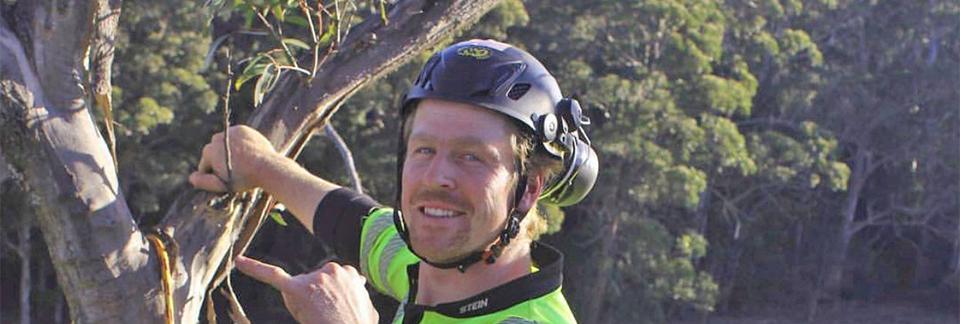
How much time should you spend studying? Our ‘Goldilocks Day’ tool helps find the best balance of good grades and well-being

For students, as for all of us, life is a matter of balance, trade-offs and compromise. Studying for hours on end is unlikely to lead to best academic results. And it could have negative impacts on young people’s physical, mental and social well-being.
Our recent study found the best way for young people to spend their time was different for mental health than for physical health, and even more different for school-related outcomes. Students needed to spend more time sitting for best cognitive and academic performance, but physical activity trumped sitting time for best physical health. For best mental health, longer sleep time was most important.
It’s like a game of rock, paper, scissors with time use. So, what is the sweet spot, or as Goldilocks put it, the “just right” amount of study?
Read more: Back to school: how to help your teen get enough sleep
Using our study data for Australian children aged 11 and 12, we are developing a time-optimisation tool that allows the user to define their own mental, physical and cognitive health priorities. Once the priorities are set, the tool provides real-time updates on what the user’s estimated “Goldilocks day” looks like.
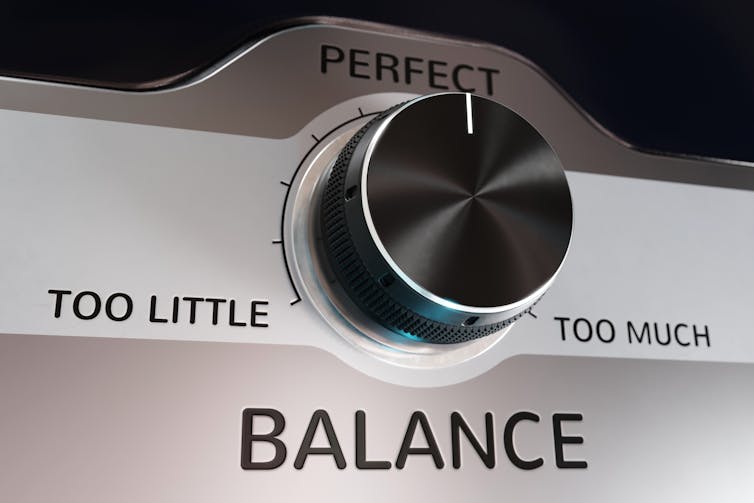
More Study Improves Grades, But Not As Much As You Think
Over 30 years of research shows that students doing more homework get better grades. However, extra study doesn’t make as much difference as people think. An American study found the average grades of high school boys increased by only about 1.5 percentage points for every extra hour of homework per school night.
What these sorts of studies don’t consider is that the relationship between time spent doing homework and academic achievement is unlikely to be linear. A high school boy doing an extra ten hours of homework per school night is unlikely to improve his grades by 15 percentage points.
There is a simple explanation for this: doing an extra ten hours of homework after school would mean students couldn’t go to bed until the early hours of the morning. Even if they could manage this for one day, it would be unsustainable over a week, let alone a month. In any case, adequate sleep is probably critical for memory consolidation.
Read more: What's the point of homework?
As we all know, there are only 24 hours in a day. Students can’t devote more time to study without taking this time from other parts of their day. Excessive studying may become detrimental to learning ability when too much sleep time is lost.
Another US study found that, regardless of how long a student normally spent studying, sacrificing sleep to fit in more study led to learning problems on the following day. Among year 12s, cramming in an extra three hours of study almost doubled their academic problems. For example, students reported they “did not understand something taught in class” or “did poorly on a test, quiz or homework”.
Excessive study could also become unhelpful if it means students don’t have time to exercise. We know exercise is important for young people’s cognition, particularly their creative thinking, working memory and concentration.
On the one hand, then, more time spent studying is beneficial for grades. On the other hand, too much time spent studying is detrimental to grades.
We Have To Make Trade-Offs
Of course, how young people spend their time is not only important to their academic performance, but also to their health. Because what is the point of optimising school grades if it means compromising physical, mental and social well-being? And throwing everything at academic performance means other aspects of health will suffer.
US sleep researchers found the ideal amount of sleep for for 15-year-old boys’ mental health was 8 hours 45 minutes a night, but for the best school results it was one hour less.
Clearly, to find the “Goldilocks Zone” – the optimal balance of study, exercise and sleep – we need to think about more than just school grades and academic achievement.
Looking For The Goldilocks Day
Based on our study findings, we realised the “Goldilocks Day” that was the best on average for all three domains of health (mental, physical and cognitive) would require compromises. Our optimisation algorithm estimated the Goldilocks Day with the best overall compromise for 11-to-12-year-olds. The breakdown was roughly:
10.5 hours of sleep
9.5 hours of sedentary behaviour (such as sitting to study, chill out, eat and watch TV)
2.5 hours of light physical activity (chores, shopping)
1.5 hours of moderate-to-vigorous physical activity (sport, running).
We also recognised that people – or the same people at different times — have different priorities. Around exam time, academic performance may become someone’s highest priority. They may then wish to manage their time in a way that leads to better study results, but without completely neglecting their mental or physical health.
To better explore these trade-offs, we developed our time-use optimisation tool based on Australian data. Although only an early prototype, the tool shows there is no “one size fits all” solution to how young people should be spending their time. However, we can be confident the best solutions will involve a healthy balance across multiple daily activities.
Just like we talk about the benefits of a balanced diet, we should start talking about the benefits of balanced time use. The better equipped young people and those supporting them are to find their optimal daily balance of sleep, sedentary behaviours and physical activities, the better their learning outcomes will be, without compromising their health and well-being.![]()
Dot Dumuid, Senior Research Fellow, Allied Health & Human Performance, University of South Australia and Tim Olds, Professor of Health Sciences, University of South Australia
This article is republished from The Conversation under a Creative Commons license. Read the original article.
Land ahoy: study shows the first continents bobbed to the surface more than 3 billion years ago
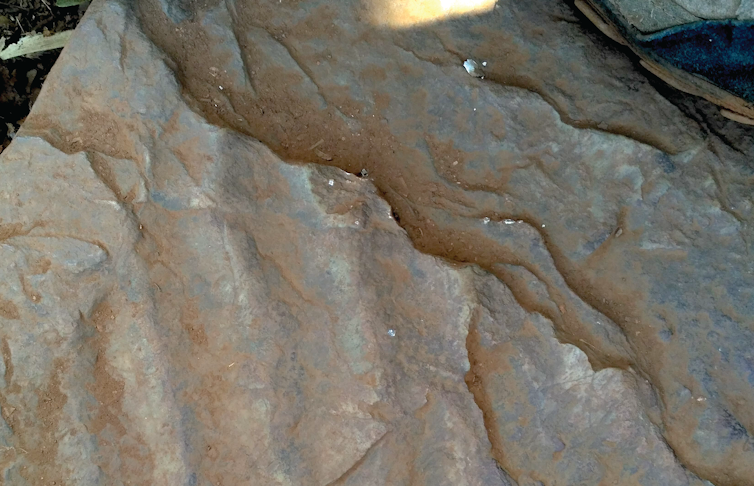
Most people know that the land masses on which we all live represent just 30% of Earth’s surface, and the rest is covered by oceans.
The emergence of the continents was a pivotal moment in the history of life on Earth, not least because they are the humble abode of most humans. But it’s still not clear exactly when these continental landmasses first appeared on Earth, and what tectonic processes built them.
Our research, published in Proceedings of the National Academy of Sciences, estimates the age of rocks from the most ancient continental fragments (called cratons) in India, Australia and South Africa. The sand that created these rocks would once have formed some of the world’s first beaches.
We conclude that the first large continents were making their way above sea level around 3 billion years ago – much earlier than the 2.5 billion years estimated by previous research.
A 3-Billion-Year-Old Beach
When continents rise above the oceans they start to erode. Wind and rain break rocks down into grains of sand, which are transported downstream by rivers and accumulate along coastlines to form beaches.
These processes, which we can observe in action during a trip to the beach today, have been operating for billions of years. By scouring the rock record for signs of ancient beach deposits, geologists can study episodes of continent formation that happened in the distant past.
The Singhbhum craton, an ancient piece of continental crust that makes up the eastern parts of the Indian subcontinent, contains several formations of ancient sandstone. These layers were originally formed from sand deposited in beaches, estuaries and rivers, which was then buried and compressed into rock.
We determined the age of these deposits by studying microscopic grains of a mineral called zircon, which is preserved within these sandstones. This mineral contains tiny amounts of uranium, which very slowly turns into lead via radioactive decay. This allows us to estimate the age of these zircon grains, using a technique called uranium-lead dating, which is well suited to dating very old rocks.
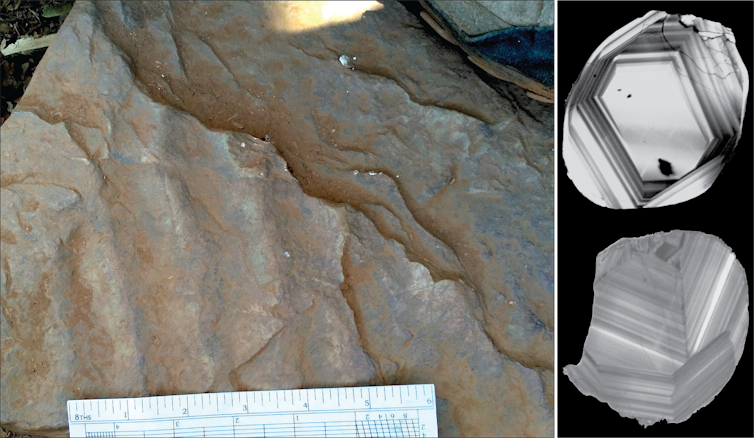
The zircon grains reveal that the Singhbhum sandstones were deposited around 3 billion years ago, making them some of the oldest beach deposits in the world. This also suggests a continental landmass had emerged in what is now India by at least 3 billion years ago.
Interestingly, sedimentary rocks of roughly this age are also present in the oldest cratons of Australia (the Pilbara and Yilgarn cratons) and South Africa (the Kaapvaal Craton), suggesting multiple continental landmasses may have emerged around the globe at this time.
Read more: What's Australia made of? Geologically, it depends on the state you're in
Rise Above It
How did rocky continents manage to rise above the oceans? A unique feature of continents is their thick, buoyant crust, which allows them to float on top of Earth’s mantle, just like a cork in water. Like icebergs, the top of continents with thick crust (typically more than 45km thick) sticks out above the water, whereas continental blocks with crusts thinner than about 40km remain submerged.
So if the secret of the continents’ rise is due to their thickness, we need to understand how and why they began to grow thicker in the first place.
Most ancient continents, including the Singhbhum Craton, are made of granites, which formed through the melting of pre-existing rocks at the base of the crust. In our research, we found the granites in the Singhbhum Craton formed at increasingly greater depths between about 3.5 billion and 3 billion years ago, implying the crust was becoming thicker during this time window.
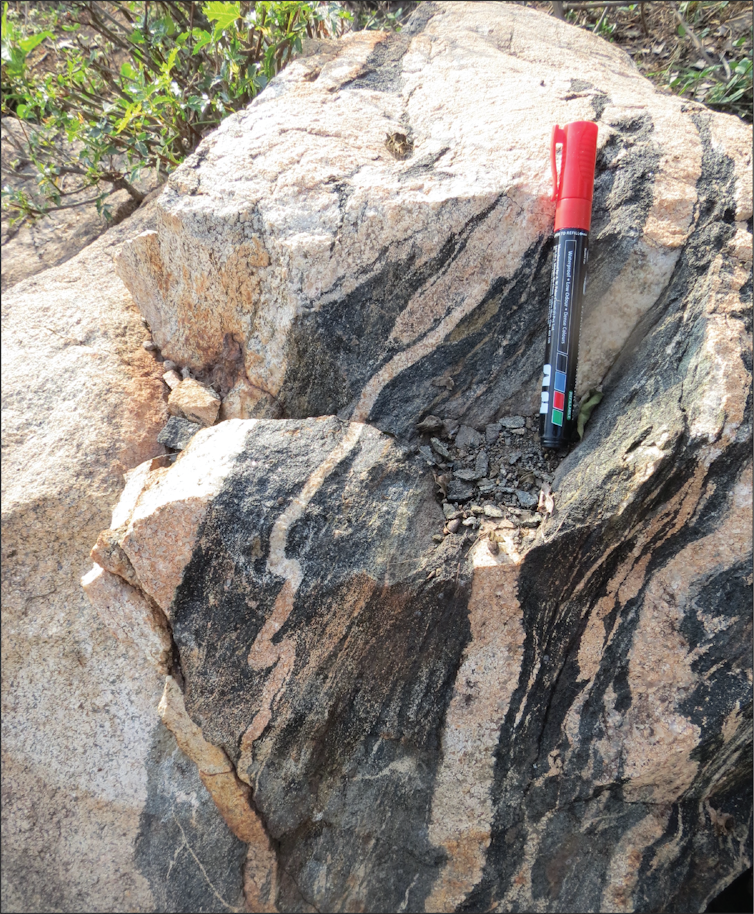
Because granites are one of the least dense types of rock, the ancient crust of the Singhbhum Craton would have become progressively more buoyant as it grew thicker. We calculate that by around 3 billion years ago, the continental crust of the Singhbhum Craton had grown to be about 50km thick, making it buoyant enough to begin rising above sea level.
The rise of continents had a profound influence on the climate, atmosphere and oceans of the early Earth. And the erosion of these continents would have provided chemical nutrients to coastal environments in which early photosynthetic life was flourishing, leading to a boom in oxygen production and ultimately helping to create the oxygen-rich atmosphere in which we thrive today.
Erosion of the early continents would have also helped in sequestering carbon dioxide from the atmosphere, leading to global cooling of the early Earth. Indeed, the earliest glacial deposits also happen to appear in the geological record around 3 billion years ago, shortly after the first continents emerged from the oceans.![]()
Priyadarshi Chowdhury, Postdoctoral research fellow, Monash University; Jack Mulder, Research Associate, The University of Queensland; Oliver Nebel, Associate Professor, Monash University, and Peter Cawood, Professor and ARC Laureate Fellow, Monash University
This article is republished from The Conversation under a Creative Commons license. Read the original article.
Mountain biking gives this Tasmanian town a sustainable future. Logging does not
Richard Buning, The University of QueenslandIn the late 19th century it was tin mining that drove the economic life of Derby, about 100 km from Launceston in north-eastern Tasmania. But the mine has long closed. From a peak of more than 3,000, by the 2016 census Derby’s population was 178, with a 20% unemployment rate.
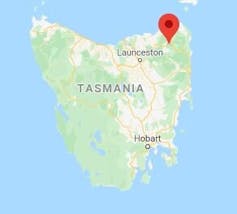
What has saved Derby from becoming another mining ghost town is finding a more sustainable mountain resource: mountain biking.
This transition could be considered a role model for the world, a story of hope for mining communities seeking to transition away from unsustainable resource extraction to something more about maintaining balance with nature.
But there’s something competing against this vision. As in many parts of Tasmania, and elsewhere, the forests through which the Blue Derby Trail Network trails have been built are still threatened by logging.
Origins Of The The Derby Venture
In 2015, with funding from the federal government, two local councils (Dorset Council and Break O'Day Council) opened the first 20 km section of the Blue Derby Trail Network, a system of mountain-bike trails that now extends 125 km through temperate old-growth rainforest, catering to a range of skill levels and riding styles.
There are easy trails such as “Crusty Rusty”, a “mostly undulating” track with two crossings of the local Cascade River. There are extremely difficult trails, such as “23 Stitches”, 800 metres of “fast, descending jump trail, littered with dirt jumps, rollers and tabletops”.
The attractions of Blue Derby Trail Network were quickly acknowledged by interstate and international mountain-bike enthusiasts. By 2017 Dorset Council mayor Greg Howard was boasting the trails were attracting 30,000 visitors a year, with the initial investment of $3.1 million returning $30 million a year.
Turmoil Amid Renewal
Logging of Tasmania’s public forests is overseen by the state-owned business known as Sustainable Timber Tasmania (previously Forestry Tasmania). It manages 816,000 hectares of public forest designated as “Permanent Timber Production Zone land”. This area represents about 12% of Tasmania’s total land area and 24% of its forests.
Each year Sustainable Timber Tasmania is required to extract 137,000 cubic metres of sawlogs from these forests. It maintains a “Three Year Plan” for what parts of Tasmania it is going to log. It updated this document in July 2021.
This plan includes logging two coupes (CC105A and C119A) covering 85 hectares that border the Blue Derby Trail Network by the end of the year. A third coupe, covering 40 hectares, is scheduled for clear-felling in 2022.

Local views on this logging are mixed. Dorset Council mayor Greg Howard has said it won’t make any difference to the mountain bike trails. Conservationists and others are more defiant. Local conservation group Blue Derby Wild has organised protests) involving cyclists, hikers and activists.
Read more: Trails on trial: which human uses are OK for protected areas?
This battle between logging and outdoor recreation in Derby exemplifies the conflict between extraction and conservation affecting communities across Tasmania, Australia and the world.
The Value Of Mountain Bike Tourism
This week more than 180 Tasmanian tourism businesses signed an open letter calling for the state government to end logging in native forests. The letter says:
Brand Tasmania promises an island at the bottom of the world where ancient forests and wild rivers await to reconnect people to their wild side, through nature based tourism experiences found nowhere else on earth.
Mountain biking has become an increasingly valuable part of this tourism mix since the late 1990s, when communities in iconic destinations such as Moab, Utah and Whistler, British Columbia began building mountain-bike trails.
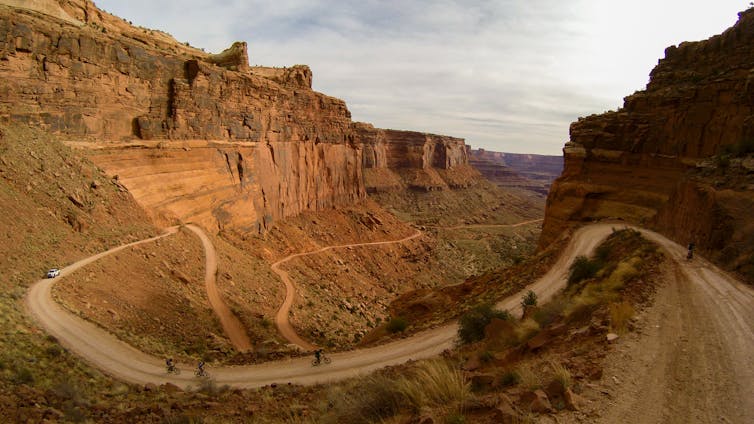
While the size and value of the industry internationally is difficult to assess, mountain bike tourists are typically affluent. They travel an average 12 nights a year, spending US$130 to US$23O each day of their visit. A study published in March 2021 (commissioned by the group AusCycling and funded by the federal government’s Building Better Region Fund), estimates Australia’s mountain bike market is worth about A$600 million a year, supporting more than 6,000 jobs.
How does the mountain-bike tourism compare with the value of logging? Again, while there are no studies that directly quantify this, comparisons between logging and ecotourism more generally point strong to the latter. A study on the economic contribution of ecotourism versus logging in the Wet Tropics of Queensland area, for example, found ecotourism was worth up to ten times more than logging.
In Tasmania, the tourism industry directly employs about 21,000 poeple, compared with about 2,500 in logging (at the time of the 2016 census).
Clear-Cut Choice
Derby has been pioneer in mountain-bike tourism. Communities looking to emulate its success include Harcourt in Victoria, York in Western Australia. and Mogo in New South Wales – which is also battling logging plans threatening the mountain bike trails.
Read more: Don't hike so close to me: How the presence of humans can disturb wildlife up to half a mile away
Mountain bikers predominantly seek out destinations based on the quality of the trail systems, the attractiveness of the terrain and appeal of the natural scenery. But just as important is support from the local community and politicians.
In Derby the choice between logging and sustainable tourism should be clear-cut. Mining didn’t last. Nor can logging. Long-term protections are needed now.![]()
Richard Buning, Lecturer in Tourism, School of Business, The University of Queensland
This article is republished from The Conversation under a Creative Commons license. Read the original article.
Don’t hike so close to me: How the presence of humans can disturb wildlife up to half a mile away
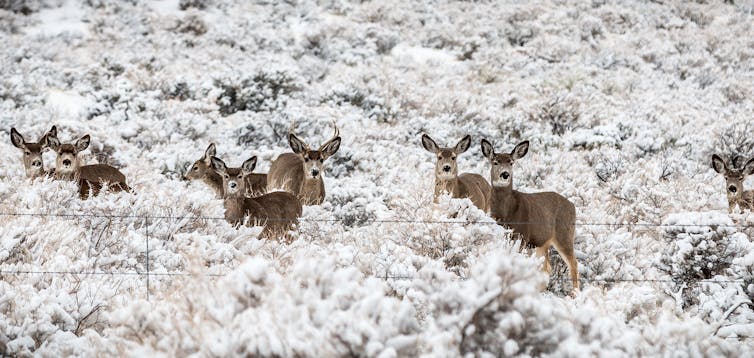
Millions of Americans are traveling this summer as pandemic restrictions wind down. Rental bookings and crowds in national parks show that many people are headed for the great outdoors.
Seeing animals and birds is one of the main draws of spending time in nature. But as researchers who study conservation, wildlife and human impacts on wild places, we believe it’s important to know that you can have major effects on wildlife just by being nearby.
In a recent review of hundreds of studies covering many species, we found that the presence of humans can alter wild animal and bird behavior patterns at much greater distances than most people may think. Small mammals and birds may change their behavior when hikers or birders come within 300 feet (100 meters) – the length of a football field. Large birds like eagles and hawks can be affected when humans are over 1,300 feet (400 meters) away – roughly a quarter of a mile. And large mammals like elk and moose can be affected by humans up to 3,300 feet (1,000 meters) away – more than half a mile.
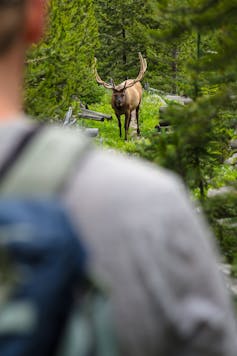
Many recent studies and reports have shown that the world is facing a biodiversity crisis. Over the past 50 years, Earth has lost so many species that many scientists believe the planet is experiencing its sixth mass extinction – due mainly to human activities.
Protected areas, from local open spaces to national parks, are vital for conserving plants and animals. They also are places where people like to spend time in nature. We believe that everyone who uses the outdoors should understand and respect this balance between outdoor recreation, sustainable use and conservation.
How Human Presence Affects Wildlife
Pandemic lockdowns in 2020 confined many people indoors – and wildlife responded. In Istanbul, dolphins ventured much closer to shore than usual. Penguins explored quiet South African Streets. Nubian ibex grazed on Israeli playgrounds. The fact that animals moved so freely without people present shows how wild species change their behavior in response to human activities.
Decades of research have shown that outdoor recreation, whether it’s hiking, cross-country skiing or riding all-terrain vehicles, has negative effects on wildlife. The most obvious signs are behavioral changes: Animals may flee from nearby people, decrease the time they feed and abandon nests or dens.
Other effects are harder to see, but can have serious consequences for animals’ health and survival. Wild animals that detect humans can experience physiological changes, such as increased heart rates and elevated levels of stress hormones.
And humans’ outdoor activities can degrade habitat that wild species depend on for food, shelter and reproduction. Human voices, off-leash dogs and campsite overuse all have harmful effects that make habitat unusable for many wild species.
Effects Of Human Presence Vary For Different Species
For our study we examined 330 peer-reviewed articles spanning 38 years to locate thresholds at which recreation activities negatively affected wild animals and birds. The main thresholds we found were related to distances between wildlife and people or trails. But we also found other important factors, including the number of daily park visitors and the decibel levels of people’s conversations.
The studies that we reviewed covered over a dozen different types of motorized and nonmotorized recreation. While it might seem that motorized activities would have a bigger impact, some studies have found that dispersed “quiet” activities, such as day hiking, biking and wildlife viewing, can also affect which wild species will use a protected area.
Put another way, many species may be disturbed by humans nearby, even if those people are not using motorboats or all-terrain vehicles. It’s harder for animals to detect quiet humans, so there’s a better chance that they’ll be surprised by a cross-country skier than a snowmobile, for instance. In addition, some species that have been historically hunted are more likely to recognize – and flee from – a person walking than a person in a motorized vehicle.
Generally, larger animals need more distance, though the relationship is clearer for birds than mammals. We found that for birds, as bird size increased, so did the threshold distance. The smallest birds could tolerate humans within 65 feet (20 meters), while the largest birds had thresholds of roughly 2,000 feet (600 meters). Previous research has found a similar relationship. We did not find that this relationship existed as clearly for mammals.
We found little research on impact thresholds for amphibians and reptiles, such as lizards, frogs, turtles and snakes. A growing body of evidence shows that amphibians and reptiles are disturbed and negatively affected by recreation. So far, however, it’s unclear whether those effects reflect mainly the distance to people, the number of visitors or other factors.
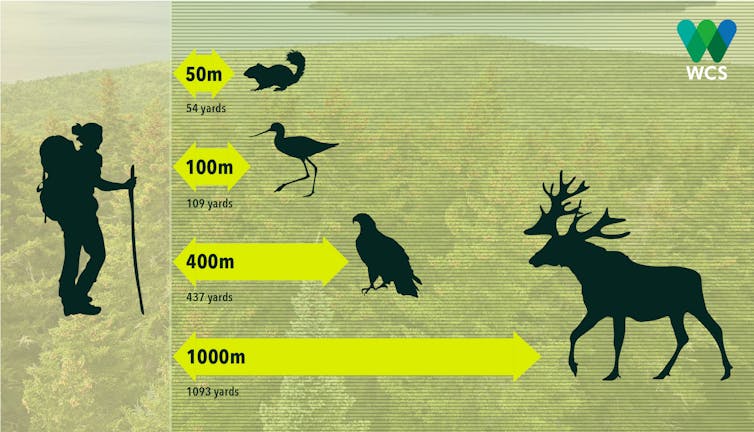
How To Reduce Your Impact On Wildlife
While there’s much still to learn, we know enough to identify some simple actions people can take to minimize their impacts on wildlife. First, keep your distance. Although some species or individual animals will become used to human presence at close range, many others won’t. And it can be hard to tell when you are stressing an animal and potentially endangering both it and yourself.
Second, respect closed areas and stay on trails. For example, in Jackson Hole, Wyoming, wildlife managers seasonally close some backcountry ski areas to protect critical habitat for bighorn sheep and reduce stress on other species like moose, elk and mule deer. And rangers in Maine’s Acadia National Park close several trails annually near peregrine falcon nests. This reduces stress to nesting birds and has helped this formerly endangered species recover.
Getting involved with educational or volunteer programs is a great way to learn about wildlife and help maintain undisturbed areas. As our research shows, balancing recreation with conservation means opening some areas to human use and keeping others entirely or mostly undisturbed.
As development fragments wild habitat and climate change forces many species to shift their ranges, movement corridors between protected areas become even more important. Our research suggests that creating recreation-free wildlife corridors of at least 3,300 feet (1,000 meters) wide can enable most species to move between protected areas without disturbance. Seeing wildlife can be part of a fun outdoor experience – but for the animals’ sake, you may need binoculars or a zoom lens for your camera.
[Get our best science, health and technology stories. Sign up for The Conversation’s science newsletter.]![]()
Jeremy Dertien, PhD Candidate in Forestry and Environmental Conservation, Clemson University ; Courtney Larson, Adjunct Assistant Professor, University of Wyoming, and Sarah Reed, Affiliate Faculty in Fish, Wildlife and Conservation Biology, Colorado State University
This article is republished from The Conversation under a Creative Commons license. Read the original article.
Students’ choice of university has no effect on new graduate pay, and a small impact later on. What they study matters more
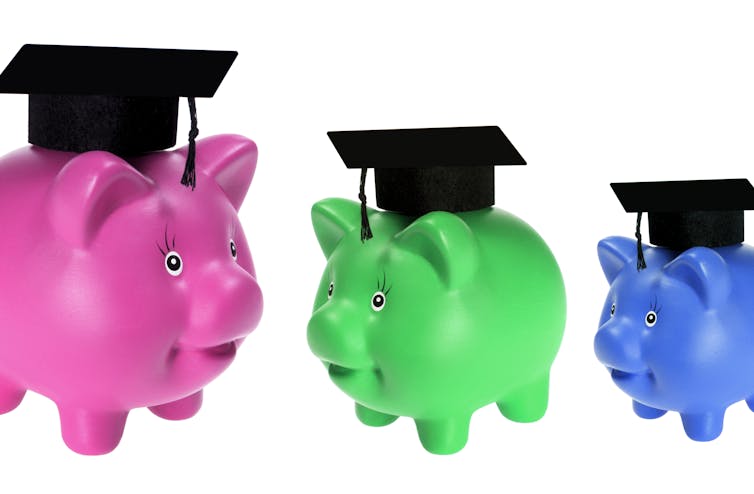
Every year in Australia school leavers suffer ATAR anxiety, worrying about whether they will get into their preferred course and university. New research by the Commonwealth Department of Education, using Australian Taxation Office earnings data, examines in detail how much difference what a person studies, and where, makes to their future income.
It finds students’ course choices matter more than their choice of university. Qualifications in some fields of study lead to much higher incomes nine years after graduation. Which university a student attends has little influence on short-term graduate earnings, but differences emerge over time.
Read more: Let's not focus on graduate incomes when assessing the worth of education
Why Might Graduates Of Some Universities Earn More?
We would expect some university effect on earnings. Universities vary in their teaching quality, at least as measured by student satisfaction. In theory, those whose graduates learn more could expect labour market rewards.
Whether justified by objective learning gains or not, some universities are better known and more prestigious than others. This could influence employers when choosing between job applicants.
And some universities, especially those with many full-time and on-campus undergraduates, offer greater networking opportunities. The people met at university could open up employment and business opportunities.
Why Might Graduates Of Some Courses Earn More?
Previous research shows graduate earnings vary greatly according to a degree’s field of education.
Some degrees are entry points to specific occupations. The pay for those jobs is a major influence on graduate earnings. Other degrees provide more general skills that are valued to a greater or lesser extent in the labour market.
These differences reflect market conditions, occupational regulation and political decisions more than how good either the university or the graduate might be. University and graduate factors can influence who gets hired and promoted, but job markets set the salary range.
Read more: Want to improve your chances of getting a full-time job? A double degree can do that
What Do The Department’s Results Show?
The Department of Education’s graduate income report and accompanying spreadsheets show earnings at various time points after graduation. I will mainly discuss the medium-term results, as at 2017-18 for people who graduated in the late 2000s.
As the chart shows, bachelor degree earnings differ significantly by the field of study nine years after graduation. At the high end, half of medical graduates reported annual incomes of A$149,500 or more (the median). A quarter earned $206,900 or more (the 75th percentile). The equivalent figures for performing arts were $53,000 and $80,300.
The overall results (including fields not shown here) were a median of $77,100 and a 75th percentile of $102,600.
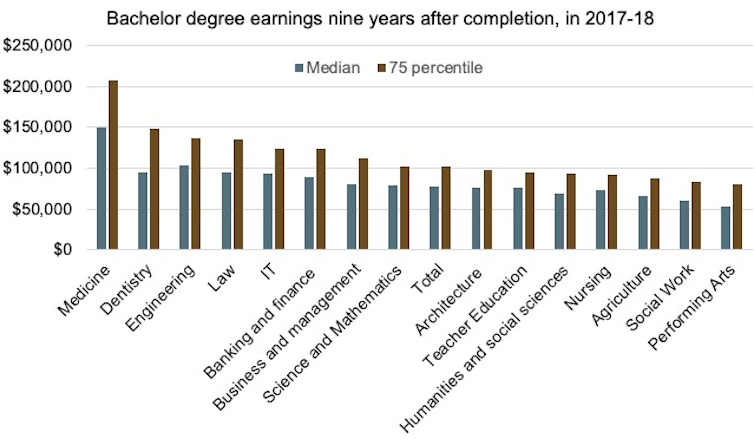
The department’s statistical analysis shows substantial course differences persist after taking into account university attended and personal characteristics such as gender, socioeconomic background and ATAR. For example, compared to business and management graduates, law and engineering graduates earn an extra $11,000 a year.
Much of the apparent variation in earnings between universities reflects differences in enrolment patterns. For example, universities with more graduates in high-paying fields such as medicine, law and engineering end up with higher median earnings than universities that focus on teaching or nursing.
Read more: Think our unis are all much the same? Look more closely and you will find diversity
The department’s analysis does show, however, that a decade after leaving university Group of Eight (Go8) graduates earn about $4,300 a year more than others from a comparison group of universities. Australian Technology Network (ATN) university graduates also earn more than non-Go8 graduates. These findings take into account course taken and personal characteristics such as gender, socioeconomic background and ATAR.
Does This Change Our Understanding Of Graduate Outcomes?
These findings confirm general patterns observed in previous research. They do so in ways that give us more confidence in earlier results.
Several studies have found either no or a small Go8 salary advantage for new graduates, after taking into account other factors known to influence graduate pay. The short-term results (one to two years after graduation) using ATO data also report no such advantage.
These findings count against strong prestige effects. If there were such effects, we would expect these to be greatest early in graduates’ careers, before they have had a chance to demonstrate their quality to employers.
Before now, longer-term earnings by university have been very difficult to analyse. Few data sources record both income and university attended more than three years after graduation.
The main exception has been the HILDA survey. Its data were used in a study I co-authored at the Grattan Institute in 2014 and a later one by Curtin University researchers.
Both these studies found small university and larger course effects on income. The Grattan paper also found Go8 and ATN graduates doing slightly better. The Curtin paper found an earnings disadvantage for regional university graduates, with other university grouping differences not statistically significant.
Read more: How does your choice of university affect your future?
At the time of the Grattan paper there was some surprise that the university differences were not larger. Given the modest number of graduates in the HILDA sample, including people who finished university at many different times, its findings needed to be checked using other data sources.
The Department of Education’s analysis includes most graduates who finished in the same year. It both provides a much larger sample and lets us compare people at similar points in their career who faced common economic conditions. The strong parallels between the HILDA and ATO-based findings give us confidence the conclusions are right.
Read more: Surveys are not the best way to measure the performance of Australian universities
Caveats And Suggestions
While a significant step forward, the ATO data source has some weaknesses. It relies on students borrowing under the HELP loan scheme to create the link between tax file numbers and enrolment records. The analysis excludes international students and domestic students who paid their fees up-front.
For future work using the ATO data I suggest looking at the effects of local labour markets. After taking into account courses taken and student characteristics, most of the universities showing earnings premiums are in NSW or the ACT.
Have universities there found a special strategy for improving graduate outcomes? Or are there simply more well-paid jobs in Sydney and Canberra? With the Grattan and Curtin papers both finding a NSW premium, the second explanation looks most plausible.
Will Student Choices Change?
The ATO data show significant differences in earnings by course taken, but this is already well-known and probably won’t change students’ course choices. Student interests primarily shape these choices.
Within a prospective student’s range of interests, labour market prospects affect choices, but job availability is the main driver of shifts in applications. Nursing, which recorded a big increase in applications for 2021, may not lead to high salaries but is a reliable source of flexible employment.
On university choice, the main message is that earnings should only be a small factor in students’ decision-making. University attended explains only a small proportion of all the variation in graduate income.
A degree from a Go8 university is not going to open many doors that would otherwise be closed. A wide range of personal, occupational, firm, industry and broader economic factors influence long-term earnings.![]()
Andrew Norton, Professor in the Practice of Higher Education Policy, Australian National University
This article is republished from The Conversation under a Creative Commons license. Read the original article.
Why Australian uni students have a right to know class sizes before they sign up

Proliferating metrics and rankings in recent decades have, for better or worse, reshaped the priorities of universities around the world. Despite this “metric tide”, Australian universities provide little reliable, publicly available data on their class sizes. To this day, there is no mechanism for reporting how many students are allocated to the various types of classes at universities in Australia.
The result is a clear lack of systematic evidence on how universities organise their teaching in terms of class sizes. We also don’t know for sure how this may have changed over the years.
Read more: What to look for when choosing a university as the digital competition grows
3 Reasons We Need To Know About Class Sizes
From a policy perspective, having reliable, publicly available data on Australian universities’ class sizes matters for a number of reasons.
First, class size metrics would provide prospective students with more meaningful information about a key aspect of their future learning experience.
University rankings such as the Academic Ranking of World Universities are mostly geared towards research performance. They provide little guidance on how universities value and approach their teaching.
Student-staff ratios are part of some rankings at least, but this information is similarly limited. These ratios do not provide accurate information on the actual sizes of the various classes students attend. They also generally do not distinguish between different fields of study.
All this means student-staff ratios are a limited source of information.
Second, class sizes could have impacts on students’ learning outcomes and levels of satisfaction.
Some studies suggest student outcomes get worse as classes at universities get larger. Other studies paint a more complex picture. These suggest the the effect of increasing class size on students’ achievement differs substantially between academic disciplines. It also depends on the student demographics.
Read more: Think our unis are all much the same? Look more closely and you will find diversity
The picture of the relationship between class sizes and student satisfaction remains similarly inconclusive.
It is ultimately undeniable, however, that smaller classes provide students with better access to and more interaction with their lecturer or tutor. This is particularly important for tutorial classes, which are meant to enable high levels of interaction. It is reasonable to assume smaller tutorial classes make it easier to provide students with more detailed and targeted feedback.
Third, publishing reliable information on class sizes would eventually lead to better understanding of trends and their potential impacts on students’ learning experiences.
Ample anecdotal evidence suggests Australian universities’ class sizes have increased dramatically over recent decades. For example, tutorial class sizes of more than 35 students are not uncommon these days. Only a decade ago an upper limit of 20 students appears to have been the norm.
Unsurprisingly, these numbers are a long way from what tutorial classes looked like before mass higher education. A 2017 study has shown UK universities in the 1960s, for example, had tutorial classes of only about four students on average. The picture at Australian universities would probably not have been too different given the similarities of these two higher education systems.
Read more: The mass university is good for equity, but must it also be bad for learning?
How Could Class Sizes Be Reported?
To make university class-size data usable for prospective students and other stakeholders, consistent reporting standards would need to be agreed. Any published class-size metrics should clearly distinguish different modes of delivery, such as online or face-to-face, and different levels of education, such as undergraduate or postgraduate.
Metrics should also reflect the variety of sessions students typically attend. These include lectures, seminars, tutorials or lab classes. Information on class sizes is much more meaningful for group-based and highly interactive teaching activities such as tutorials than for less interactive activities such as lectures.
Logistically, collating class-size metrics should not be too onerous for universities. The information already exists in their learning management or business intelligence systems. The public reporting of data on class sizes could use existing mechanisms such as the annual Quality Indicators for Leaning and Teaching (QILT).
Overall, from a higher education policy perspective, publishing relevant class-size metrics would greatly enhance the transparency of Australian universities’ teaching offerings. It would provide students with meaningful information about what to expect at the university of their choice.![]()
Peter Woelert, Senior Lecturer, Melbourne Graduate School of Education, The University of Melbourne
This article is republished from The Conversation under a Creative Commons license. Read the original article.
The Moon’s top layer alone has enough oxygen to sustain 8 billion people for 100,000 years
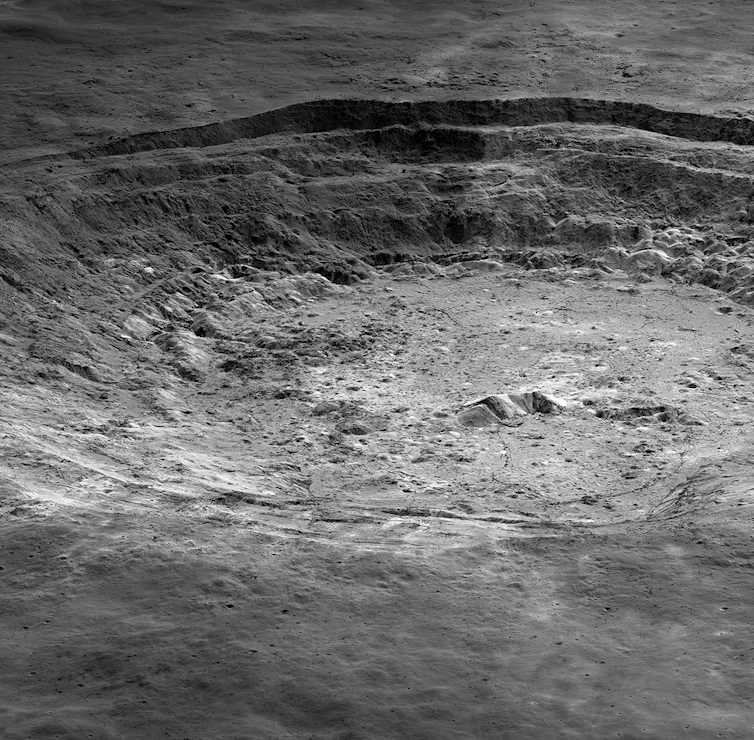
Alongside advances in space exploration, we’ve recently seen much time and money invested into technologies that could allow effective space resource utilisation. And at the forefront of these efforts has been a laser-sharp focus on finding the best way to produce oxygen on the Moon.
In October, the Australian Space Agency and NASA signed a deal to send an Australian-made rover to the Moon under the Artemis program, with a goal to collect lunar rocks that could ultimately provide breathable oxygen on the Moon.
Although the Moon does have an atmosphere, it’s very thin and composed mostly of hydrogen, neon and argon. It’s not the sort of gaseous mixture that could sustain oxygen-dependent mammals such as humans.
That said, there is actually plenty of oxygen on the Moon. It just isn’t in a gaseous form. Instead it’s trapped inside regolith — the layer of rock and fine dust that covers the Moon’s surface. If we could extract oxygen from regolith, would it be enough to support human life on the Moon?
The Breadth Of Oxygen
Oxygen can be found in many of the minerals in the ground around us. And the Moon is mostly made of the same rocks you’ll find on Earth (although with a slightly greater amount of material that came from meteors).
Minerals such as silica, aluminium, and iron and magnesium oxides dominate the Moon’s landscape. All of these minerals contain oxygen, but not in a form our lungs can access.
On the Moon these minerals exist in a few different forms including hard rock, dust, gravel and stones covering the surface. This material has resulted from the impacts of meteorites crashing into the lunar surface over countless millennia.
Some people call the Moon’s surface layer lunar “soil”, but as a soil scientist I’m hesitant to use this term. Soil as we know it is pretty magical stuff that only occurs on Earth. It has been created by a vast array of organisms working on the soil’s parent material — regolith, derived from hard rock — over millions of years.
The result is a matrix of minerals which were not present in the original rocks. Earth’s soil is imbued with remarkable physical, chemical and biological characteristics. Meanwhile, the materials on the Moon’s surface is basically regolith in its original, untouched form.
One Substance Goes In, Two Come Out
The Moon’s regolith is made up of approximately 45% oxygen. But that oxygen is tightly bound into the minerals mentioned above. In order to break apart those strong bonds, we need to put in energy.
You might be familiar with this if you know about electrolysis. On Earth this process is commonly used in manufacturing, such as to produce aluminium. An electrical current is passed through a liquid form of aluminium oxide (commonly called alumina) via electrodes, to separate the aluminium from the oxygen.
In this case, the oxygen is produced as a byproduct. On the Moon, the oxygen would be the main product and the aluminium (or other metal) extracted would be a potentially useful byproduct.
It’s a pretty straightforward process, but there is a catch: it’s very energy hungry. To be sustainable, it would need to be supported by solar energy or other energy sources available on the Moon.
Extracting oxygen from regolith would also require substantial industrial equipment. We’d need to first convert solid metal oxide into liquid form, either by applying heat, or heat combined with solvents or electrolytes. We have the technology to do this on Earth, but moving this apparatus to the Moon – and generating enough energy to run it – will be a mighty challenge.
Earlier this year, Belgium-based startup Space Applications Services announced it was building three experimental reactors to improve the process of making oxygen via electrolysis. They expect to send the technology to the Moon by 2025 as part of the European Space Agency’s in-situ resource utilisation (ISRU) mission.
How Much Oxygen Could The Moon Provide?
That said, when we do manage to pull it off, how much oxygen might the Moon actually deliver? Well, quite a lot as it turns out.
If we ignore oxygen tied up in the Moon’s deeper hard rock material — and just consider regolith which is easily accessible on the surface — we can come up with some estimates.
Each cubic metre of lunar regolith contains 1.4 tonnes of minerals on average, including about 630 kilograms of oxygen. NASA says humans need to breathe about 800 grams of oxygen a day to survive. So 630kg oxygen would keep a person alive for about two years (or just over).
Now let’s assume the average depth of regolith on the Moon is about ten metres, and that we can extract all of the oxygen from this. That means the top ten metres of the Moon’s surface would provide enough oxygen to support all eight billion people on Earth for somewhere around 100,000 years.
This would also depend on how effectively we managed to extract and use the oxygen. Regardless, this figure is pretty amazing!
Having said that, we do have it pretty good here on Earth. And we should do everything we can to protect the blue planet — and its soil in particular — which continues to support all terrestrial life without us even trying.![]()
John Grant, Lecturer in Soil Science, Southern Cross University
This article is republished from The Conversation under a Creative Commons license. Read the original article.
How Meditation Can Help You Make Fewer Mistakes
.jpg?timestamp=1636999248613)
ASIC Sues Timeshare Company Ultiqa For Poor Financial Advice Outcomes
- provide relevant training to its authorised representatives
- monitor and supervise its authorised representatives appropriately, and
- have documented policies and procedures in place to support the advice process.
- the long-term nature of contracts, which typically range from 20 to 99 years
- the high upfront costs of joining which average $23,000
- the ongoing annual costs of membership which average $800
- the fact that many consumers often need to borrow to make the membership purchase, with 48% of consumers taking out a loan to buy a membership
- the high cost of loans taken to purchase membership, with an average loan cost of $19,699 and an average interest rate of 13.51%
- the fact that timeshare memberships are often difficult to exit.
Friday essay: beautiful, available and empty – how landscape photographers reinvented the colonial project in Australia
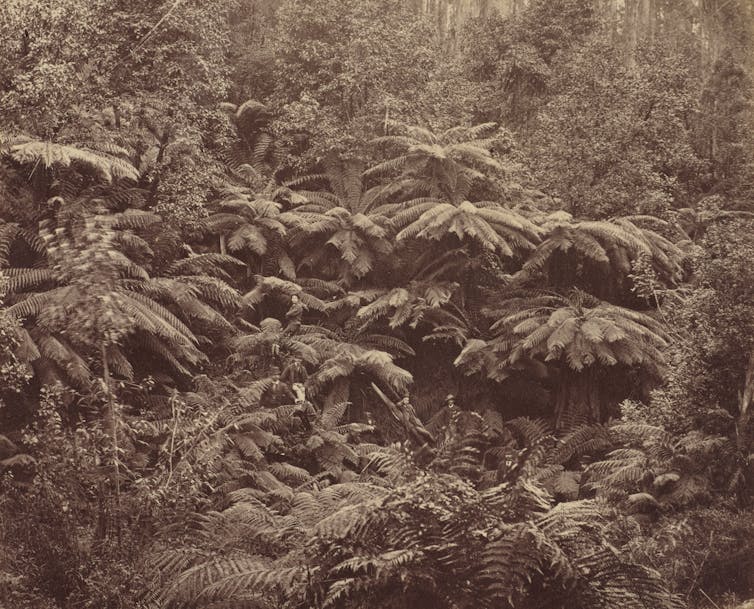
Colonial history overflows with commodities. From the early 1800s, wool generated extraordinary wealth for squatters and pastoralists and substantial investment in the Australian colonies. In the 1850s, gold motivated tens of thousands of people to work the earth or service the diggings. Coal, copper, tin, wheat, barley and cotton all assumed importance at different times.
In those great cathedrals of late 19th century colonial self-representation, the International Exhibitions, any visitor would have immediately noticed the way New South Wales, Victoria and Tasmania sought to identify with the commodities produced in these places.
In a photograph from 1879, the NSW Department of Mines filled its portion of the exhibition building, the Garden Palace, with gold ingots, silver ores and samples of tin. On the balconies above were coal sections and geological maps.

Walking through these displays a visitor would also have noticed walls of landscape photographs, which, mirroring the extractive logic of settler colonialism itself, worked to bring all these raw materials together in a vision of abundant nature.
Photographers captured images of budding settlements, seemingly empty vistas, and stunning panoramas of emerging colonial cities.
The increasing popularity of these photographs throughout the final decades of the 19th century shows colonial expansion was not just generated by the search for raw materials to extract and exploit. Colonial Australia was also a product of vision and imagery: literally developed through chemicals, glass and light.

I have studied over 2000 early landscape photographs, taken by six settler photographers between the 1850s and the 1930s. They show how colonisation was re-enacted in the imagination of places, rather than simply through the movement of people from one site to another, the Lockean mixture of labour and earth, or the transfer of deeds.
Visions of nature allowed for a different kind of investment in the colonial earth. They paid off in feelings of belonging even for those who never turned a sod. These photos reveal, as the American environmental historian William Cronon has insisted, that nature itself is a profoundly human artefact.
In settler colonies, landscape photography framed nature as beautiful, available and empty. In Victoria and Tasmania especially, landscape photography flourished. And although this mode of photography was not uniquely antipodean – it was pioneered, then perfected in the American West by photographers like Carleton Watkins and Eadweard Muybridge – it did have remarkable purchase in the Australian colonies.

A Photographic Sleight Of Hand
Figures such as Nicholas Caire, John Lindt, and John Beattie took up the camera to encourage settlers to feel at home in Australian environments. This perspective disguised the ancestral ownership and continuing presence of First Nations peoples, turning their homelands into a wilderness through a photographic sleight of hand.
Read more: Indigenous knowledge and the persistence of the 'wilderness' myth
The best example of this was in Victoria, where Caire and Lindt began framing the stretch of bush between Healesville and Narbethong as a kind of wilderness retreat from the late 1870s.
Caire, born in Guernsey in 1837, came to this collaborative work via South Australia, the forests of Gippsland and the Goldfields. Lindt, originally from Frankfurt, had just finished photographing Bundjalung and Gumbaynggir people along the Clarence River in northern NSW.
Around 1878 Caire captured Fairy Scene at the Landslip, Blacks’ Spur, which quickly became one of his most popular photographs.

In it, Caire focuses on a glade of tree-ferns clustered on the side of a gully. Writing in 1904, Caire and Lindt boasted about the wildness of this pocket of the Great Forest, the ancient age of the trees, and the “refreshing” seclusion of Fernshaw. Lindt wrote that the allure of places like this came back to their capacity to “carry you back to the morning of time”.
The empty natures of the Yarra Ranges relied on the removal and containment of Woiwurrung, Bunurong, and Taungurong people at the Coranderrk mission. Located just kilometres away from Lindt and Caire’s “refreshing” forest, Coranderrk helped the photographers create a partition between the environment and its ancestral owners.
The mission became a complementary site of interest. When promoting the natural features of the Yarra Ranges, Lindt and Caire wrote about Coranderrk as a place where tourists could mimic the anthropologist, just as they mimicked the geographer or explorer while traipsing through sylvan glades or gazing up at giant mountain ash.
At about the same time that Caire and Lindt were developing their visions of nature in the Yarra Ranges, the photographer Fred Kruger was taking influential shots of life on the reservation. One of the key challenges for aspiring landscape photographers in the 1870s and 1880s was to deal with this presence of Aboriginal people in landscapes that were becoming coveted for their natural beauty.
Caire and Lindt took up an established tradition of photography at Coranderrk, combining it with a new interest in wilderness, balancing the apparent contradiction between Indigenous presence and absence.
The Tasmanian Sublime
In Tasmania, too, photographers began constructing a similar wilderness tradition from the 1870s. Emigrating from Scotland in 1878, John Beattie, the so-called “prince of landscape photographers in Australasia”, settled with his family in New Norfolk, about 30 kilometres up the Derwent valley from Hobart.
This was a perfect location for a budding photographer, and Beattie made attractive pictures of the river and its hop gardens in the 1890s, but the interior of the island offered a different order of beauty.
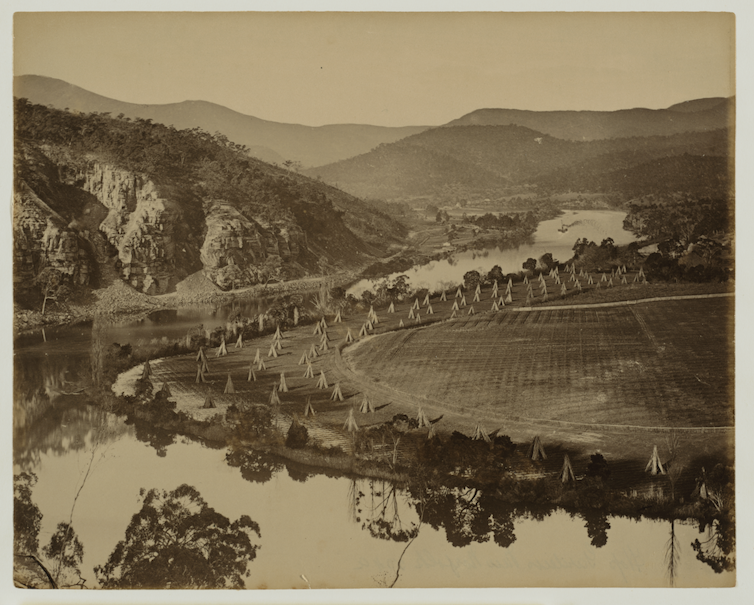
In 1879 Beattie began making expeditions into the bush around the valley, onto the central highlands, and eventually all the way to the remote Lake St. Clair. In 1882 he joined the Anson Brothers’ photographic studio and quickly became their most important artist.
An Anson Brothers image from 1887 is quite likely Beattie’s work, showing a stand of ferns on the Huon Road. Unlike Caire’s shot, however, this image includes a group of settlers enjoying exactly the kind of immersion in nature that these photographs were designed to evoke.
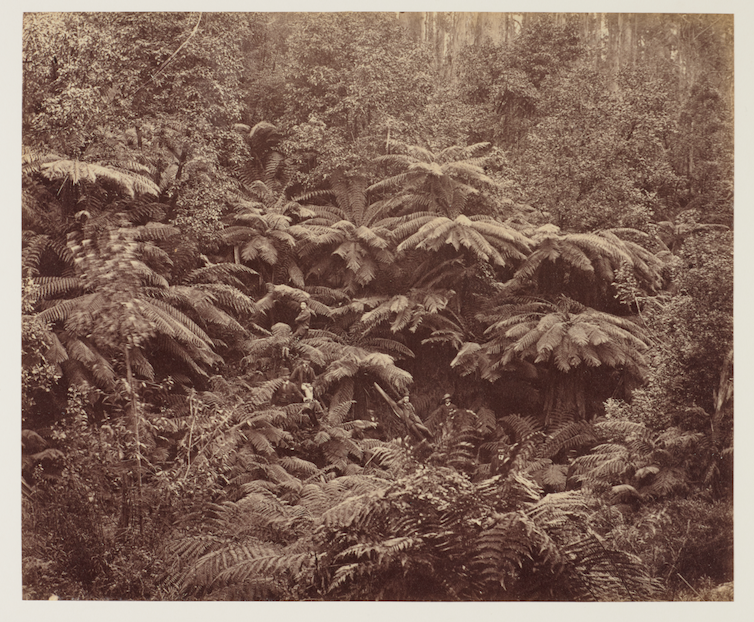
Many of Beattie’s photographs are deeply Romantic. Between 1896 and 1906 he conducted regular presentations in Hobart and Launceston based on the wild features of the Tasmanian landscape, cultivating a high wilderness aesthetic in his magic lantern shows.
Read more: Friday essay: journey through the apocalypse
Photographs of Lake Marion and the Du Cane Range and another of Lake Perry and The Pinnacles trade in the sublime. Beattie evoked the great American transcendentalist poets in his respect for the mountaintop, which often moved him to wordlessness: “I am struck dumb, but oh! my soul sings.”

These sublime sentiments relied on old Romantic ideas that stretched back to Edmund Burke and William Wordsworth, but they rested just as heavily on new experiences of space. Beattie’s breakthrough years were in the 1890s, a decade in which depictions of wilderness in Australian Romantic painting went into terminal decline and were replaced by photographic visions of nature.
Romanticism, through photography, came to influence how environments were envisioned and how histories of dispossession were remembered. The high wilderness imagery of settler photography came to support a fantasy of spatial control, delivering reproducible, enduring symbols of the natural world.
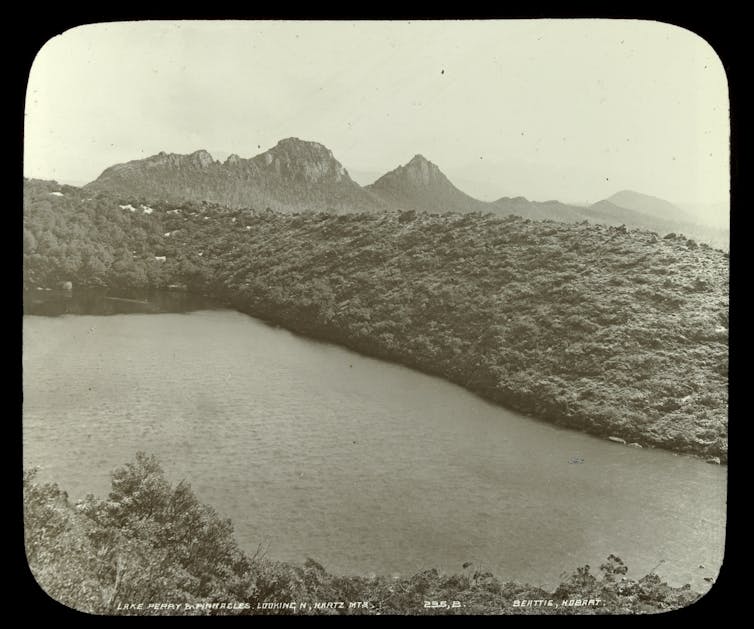
Aboriginal Extinction And Romantic Communion
Just as Caire did, Beattie divided his visions of nature and his portraits of native people. He was an insatiable and opportunistic collector of photographs of the “last” Tasmanians, leaning into and commercialising the myth of Tasmanian Aboriginal extinction.
Sometimes advertisements for these pictures featured on the back covers of Beattie’s landscape collections, gently leading interested audiences to the other side of the partition.
Read more: Friday essay: painting 'The Last Victorian Aborigines'
Most of Beattie’s photographs of Aboriginal people were simple reproductions of the portraits that Francis Nixon, the first Bishop of Tasmania and amateur photographer, took in 1858 at putalina (Oyster Cove). Nixon took pictures of the few remaining Aboriginal people, who had survived exile on Wybelenna Station on Flinders Island and a decade of surveillance at the former penal probation station just south of Hobart.
In the 1890s Beattie copied these images and labelled each of them with the phrase “the last of the race”.
It is no simple coincidence that this language was adopted by one of Australasia’s most successful landscape photographers. Aboriginal extinction and Romantic communion with the wilderness were the twin fantasies that shaped settler visions of nature in the late 19th century.
This dynamic influenced landscape photography well beyond the Australian colonies. Across the Tasman in New Zealand, the Dunedin photographer Alfred Burton became famous for an 1885 album called The Maori at Home, which delicately balanced ethnographic and wilderness imagery, much as Caire did.
Burton used the camera to carve the the local Māori from their ancestral homes, creating a “terra incognita”. He created visual partitions between the traditional custodians, Ngāti Maniopoto, and the landscapes of the Waikato and divided the people of Ngāti Tūwharetoa from the monumental geography around Tongariro, Ngāuruhoe, and Ruapehu.

Burton and a party of adventurers returned a year later, in 1886, to immerse themselves more fully in these sublime environments. More settlers would follow in Burton’s footsteps from the mid 1890s, when, after a long struggle with Ngāti Tūwharetoa, the heights around Tongariro became New Zealand’s first national park.
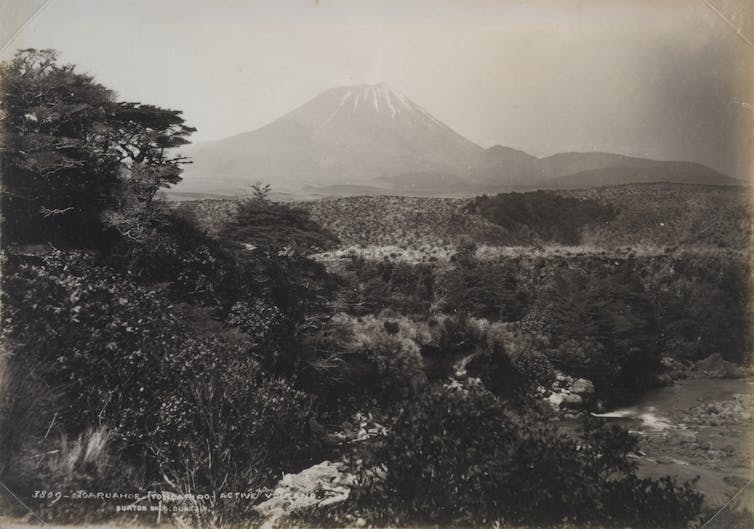
The same kind of processes shaped settler attitudes to one of the United States’ most famous national parks, Yosemite, where photographers like Watkins and Muybridge erected similar partitions between their natural and human subjects.
This division was spectacularly represented in a set of photographs that used the still waters of Yosemite’s reflective lakes to capture stunning landmarks. In these works, the myth of empty wilderness was turned into the beautiful motif of a glassy lake.
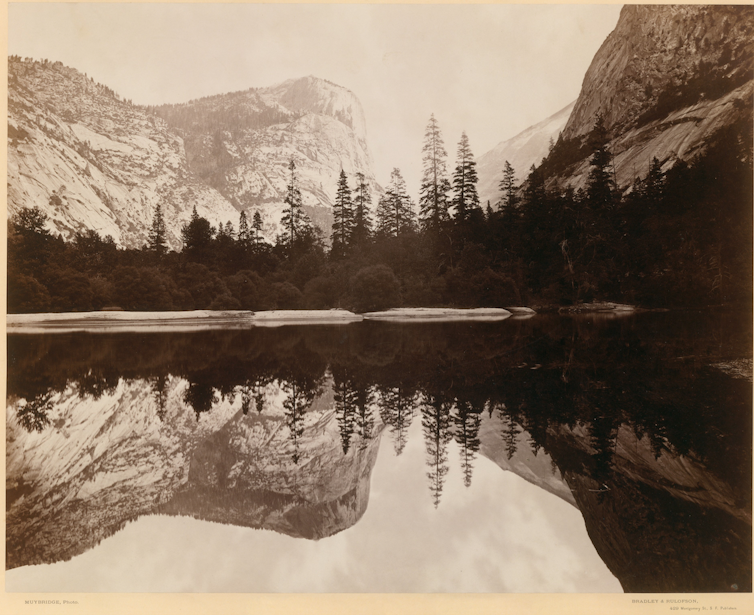
We might expect that Caire, Beattie, and Burton consciously adopted this technique from their American kin but there is no evidence this was the case.
Control Over Land
It’s more likely that comparable visions of nature developed in parallel, drawing from similar histories of dispossession and environmental transformation in different settler colonies.
In a whole range of places where pastoralists failed to graze their herds and geologists struggled to identify economic deposits, photographers helped colonists continue the cultural work of establishing dominion over stolen land.
The earliest visions of nature in Australia perfectly captured this drive, fixing its orientation to the physical world and its settler colonial history onto glass negatives, lantern slides and paper cards.
And here is where the commodities come back into the story. Settlers adopted the holistic vision of landscape photography to exert control over land. Figures like Caire and Beattie perfected a kind of environmental image-making and storytelling that encouraged settlers to feel an affinity with the natural world.
Their customers were drawn to breathe in the highly oxygenated forest air or pursue the Romantic thrill of summiting a mountain. These experiences became a commodity in and of themselves, and so did the photographs documenting them. They adorned sitting rooms, galleries and exhibition halls – summoning memories and lending a new assurance to the settler enterprise.
Jarrod Hore’s book, Visions of Nature: How Landscape Photography Shaped Settler Colonialism, is available for pre-order now.![]()
Jarrod Hore, Co-Director & Postdoctoral Fellow, New Earth Histories Research Program, UNSW
This article is republished from The Conversation under a Creative Commons license. Read the original article.
Predictive Falls Risk Model For Aged Care In Development
New Aged Care Visitor Access Code Released For Public Consultation
Start Of COVID-19 Booster Vaccination Program
Anxiety Effectively Treated With Exercise
Sitting More Linked To Increased Feelings Of Depression And Anxiety
We revisited Parramatta’s archaeological past to reveal the deep-time history of the heart of Sydney

We know quite a lot about the past 200 years of history in Parramatta. Located in Sydney’s geographical centre, on the Parramatta River, it was the first township to be established outside Sydney Cove’s penal colony after the First Fleet arrived at Port Jackson in 1788.
Parramatta became the breadbasket of the early European colony, with land clearing and farming dispossessing the Darug people of the Cumberland Plain. This formed the focus of Aboriginal resistance, culminating in the 1797 Battle of Parramatta led by the great freedom fighter Pemulwuy.
Parramatta’s European history is evident to those who wander through it today — with the remains of old buildings and signs of historical events on almost every corner.
But What About Before 1788?
Parramatta has seen intensified development in recent years. High-rise buildings, light rail, road upgrades and landscaping have all impacted the remaining archaeological record of both its deep history and more recent colonial past.
New South Wales’s current state planning laws require each new development to have an archaeological investigation conducted before it proceeds. The aim is to identify archaeological evidence before development starts, and make sure it is managed appropriately.
Where sites are of high cultural or scientific significance, there is an emphasis on protection. Otherwise, the evidence is recorded and recovered before development proceeds. There have been more than 40 such studies in the past 15 or so years.
In our article published today we review these studies to provide a definitive understanding of their results, and reiterate the importance of Parramatta’s culturally significant deep-time history.
14,000 Years Of Indigenous History
Paramatta’s urban centre has grown upon a more than 3-metre-thick layer of sand. This sand began to be deposited by the Parramatta River 50,000-60,000 years ago as a result of massive floods and other extreme environmental conditions. It continued to be deposited sporadically until about 5,000 years ago.
It’s estimated about 800,000 tonnes of sand were deposited across two kilometres of the CBD, where it is still found today. This is all the more impressive when you consider the Parramatta River is fed by only a relatively small catchment upstream.
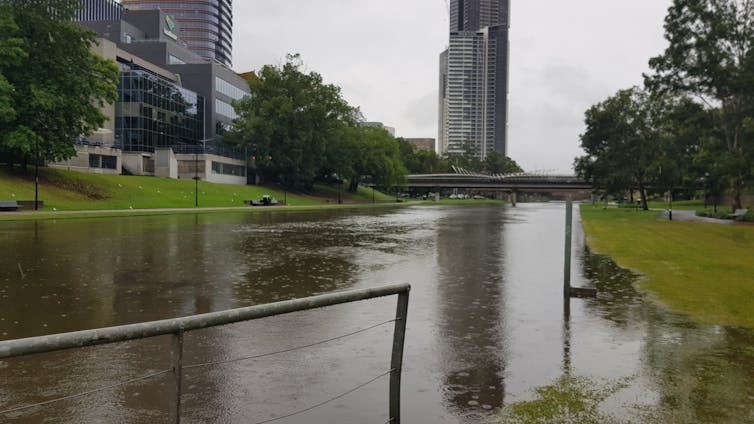
This sand was blown around during the last Ice Age (or the “Last Glacial Maximum”) between 20,000 and 30,000 years ago. Ultimately this reworking resulted in a sand sheet of about 70 hectares, or roughly 100 football fields. Unfortunately, our study found some 29% of these deposits have been destroyed through development over the past 15 years or so.
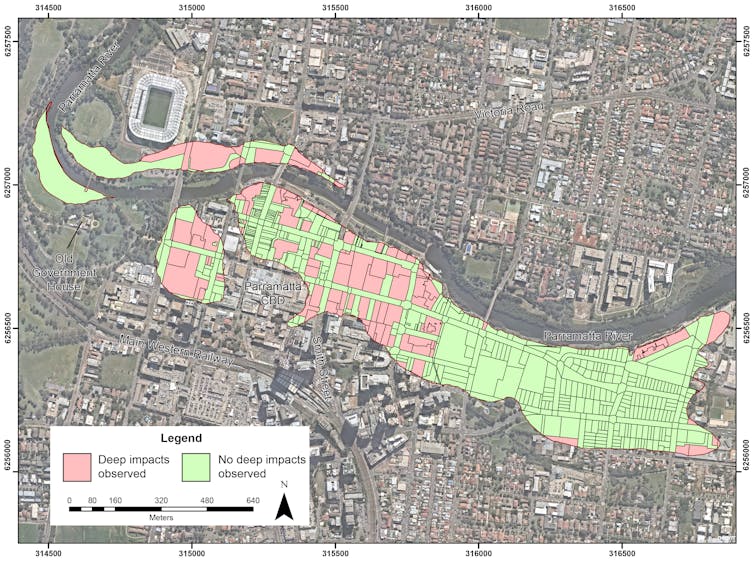
This sand body has been in place since the First Nations people arrived on the continent 50,000 (or more) years ago. It retains an amazing archive of evidence that reveals their use of the landscape in deep time, and also records major climatic changes.
Read more: When did Aboriginal people first arrive in Australia?
So far, our earliest evidence for Aboriginal people in the Sydney region is from along the Hawkesbury-Nepean River around 36,000 years ago.
While the Parramatta sand sheet does provide glimmers of evidence for people using it back then, our analyses show they mostly visited this part of the Parramatta River after the Ice Age, which is supported by layers of artefacts in the area dated to this time.
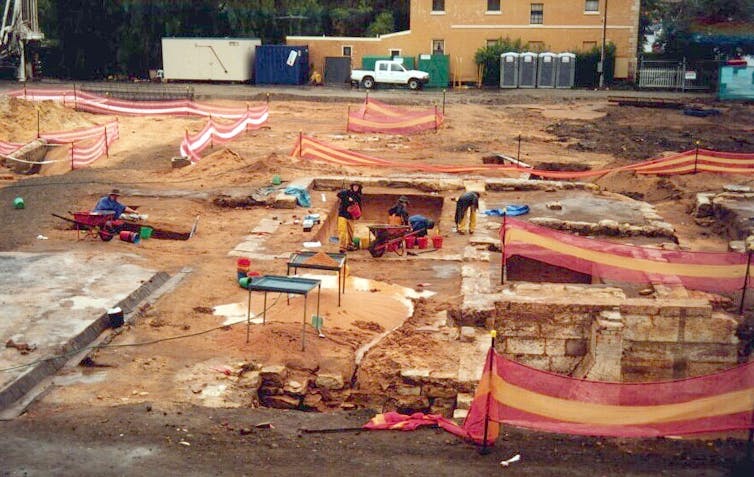
Moving With The Tide
Specifically, our paper explores three archaeological projects on the sand sheet at George Street, Hassall and Wigram Streets, and in the grounds of the Bayanami School. All of these sites show increased human use at a time of significant sea-level change.
About 14,000 years ago, the large ice sheets that characterised the glacial period began to melt rapidly. By 9,000 years ago, the sea level in Australia went from 125 metres below current levels to current levels.
This inundation of more than 2 million square kilometres drove people off the continental shelf all around Australia, including from the Sydney Basin. We find fewer sites in Sydney, or indeed the entire southeast corner of Australia, that date to before this sea-level rise.
Read more: Australia's coastal living is at risk from sea level rise, but it's happened before
A previous study of one of these key archaeological sites showed people were highly mobile as a result of this sea-level rise beginning 14,000 years ago. One stone artefact dated to 14,000 years ago was sourced from the Megalong Valley, west of the Blue Mountains, 70km from Parramatta. Most earlier artefacts were sourced from the Hawkesbury River gravels, about 40km away.

Then, over the past 10,000 years, we see a massive increase in local site use and visitation. People used a different stone material for artefacts sourced widely from across the Cumberland Plain (western Sydney), reflecting greater local knowledge of stone resources, longer occupations and likely different trade and exchange networks.
A range of tools have also been found, including grindstones, axe-heads, backed artefacts (such as spear barbs), hearths with heat retainers and heat-treated raw materials — all of which indicate repeated residence over long periods.
Similarly, parts of the sand body with more artefacts also show evidence of camping sites which have retained their structure, demonstrating repeated use. One rare finding at the corner of Charles and George Streets was a pierced shark tooth that was probably used as a hair decoration.
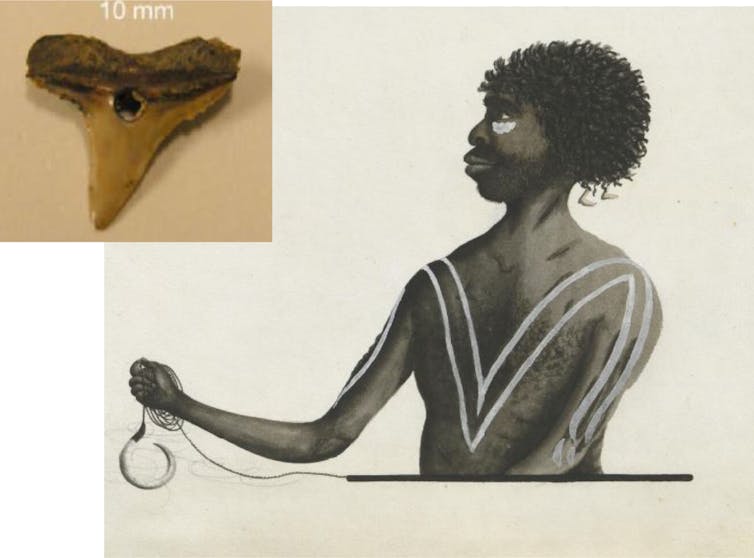
Our analysis fills an important gap in the Indigenous past of one of the oldest townships in Australia. It reinforces the importance of undertaking heritage assessments in areas which are thought to already be “disturbed”.
It also provides a timely reminder these archaeological and cultural landscapes are finite, and are being lost at an unprecedented rate.
Read more: The last ice age tells us why we need to care about a 2℃ change in temperature ![]()
Alan N Williams, Associate Investigator, ARC Centre of Excellence for Australian Biodiversity and Heritage, UNSW and Jo McDonald, Director, Centre for Rock Art Research + Management, The University of Western Australia
This article is republished from The Conversation under a Creative Commons license. Read the original article.
'Cold Bone': Researchers Discover First Dinosaur Species That Lived On Greenland 214 Million Years Ago

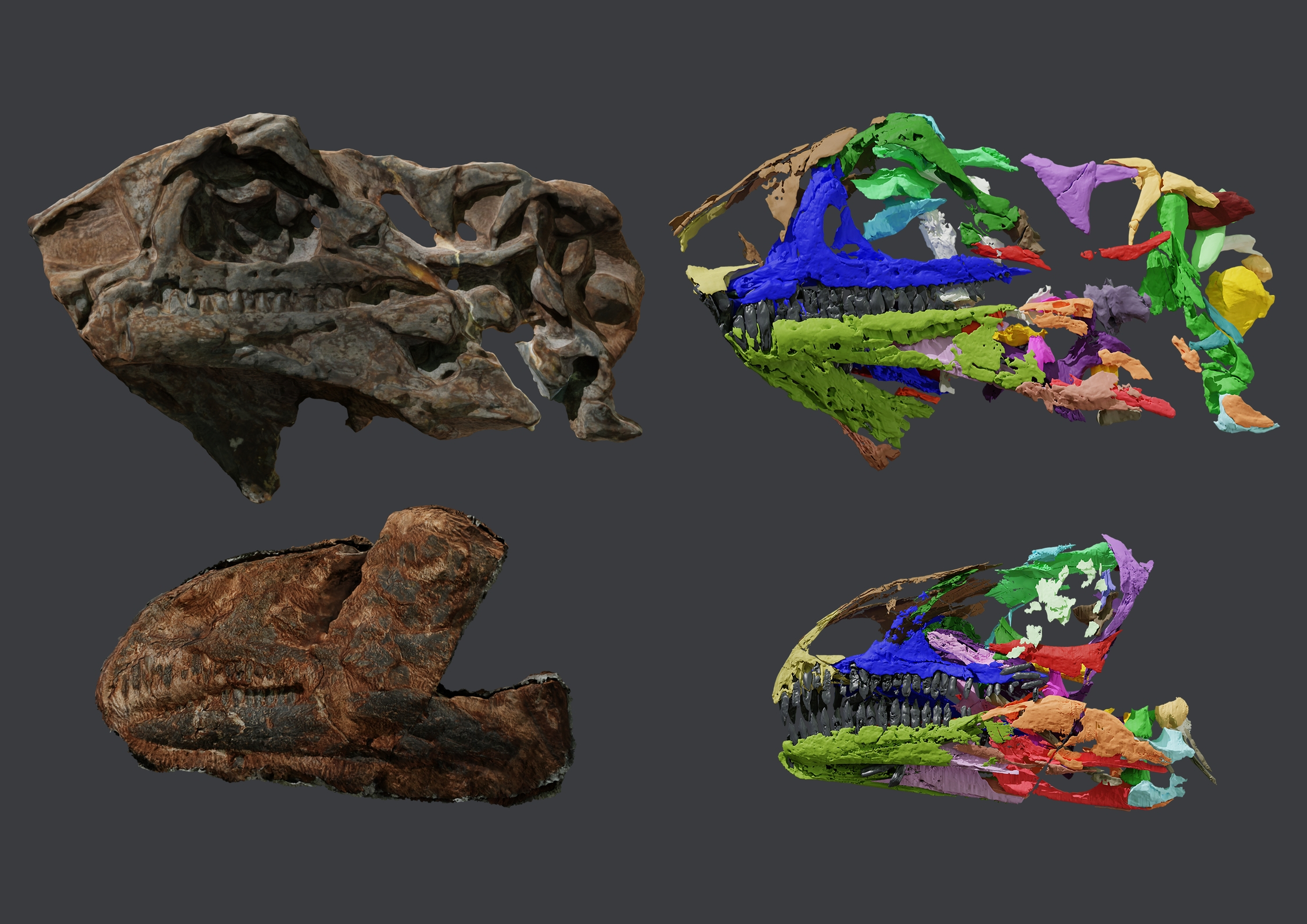
A Quantum Leap In Faster And Safer Travel In NSW
First Sod Turned On $80 Million NSW Institute Of Applied Technology For Construction
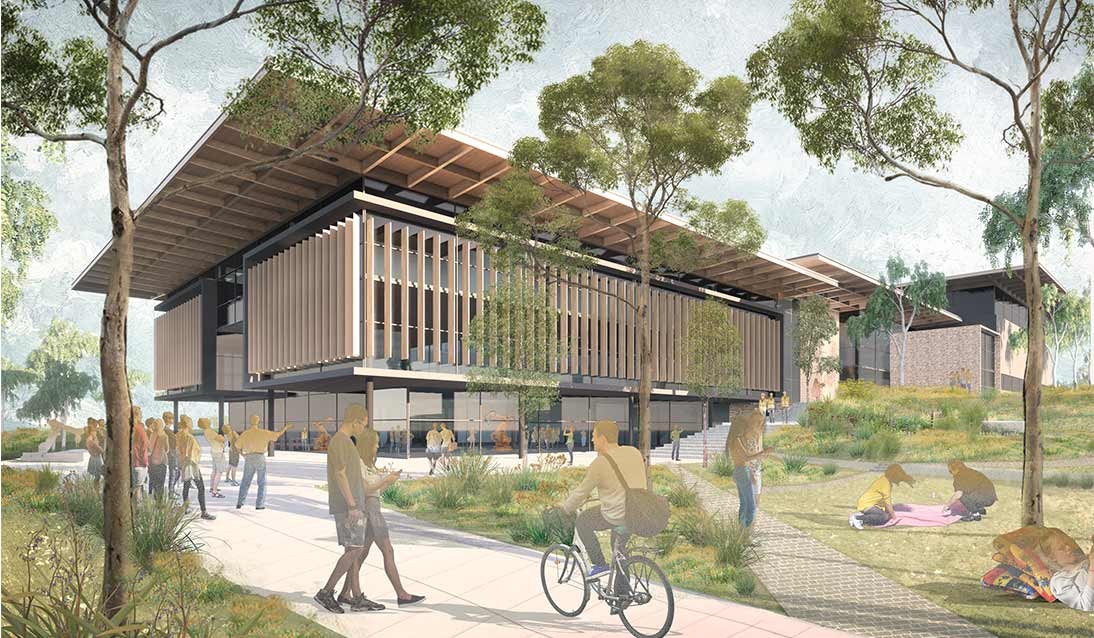
AFP's Heart And Soul On Display At Canberra Museum And Gallery
Microbiome Discovery Could Help Save Kids’ Hearing
Global Temperatures Over Last 24,000 Years Show Today's Warming 'Unprecedented'
- It verified that the main drivers of climate change since the last ice age are rising greenhouse gas concentrations and the retreat of the ice sheets.
- It suggests a general warming trend over the last 10,000 years, settling a decade-long debate about whether this period trended warmer or cooler in the paleoclimatology community.
- The magnitude and rate warming over the last 150 years far surpasses the magnitude and rate of changes over the last 24,000 years.
Global River Database Documents 40 Years Of Change
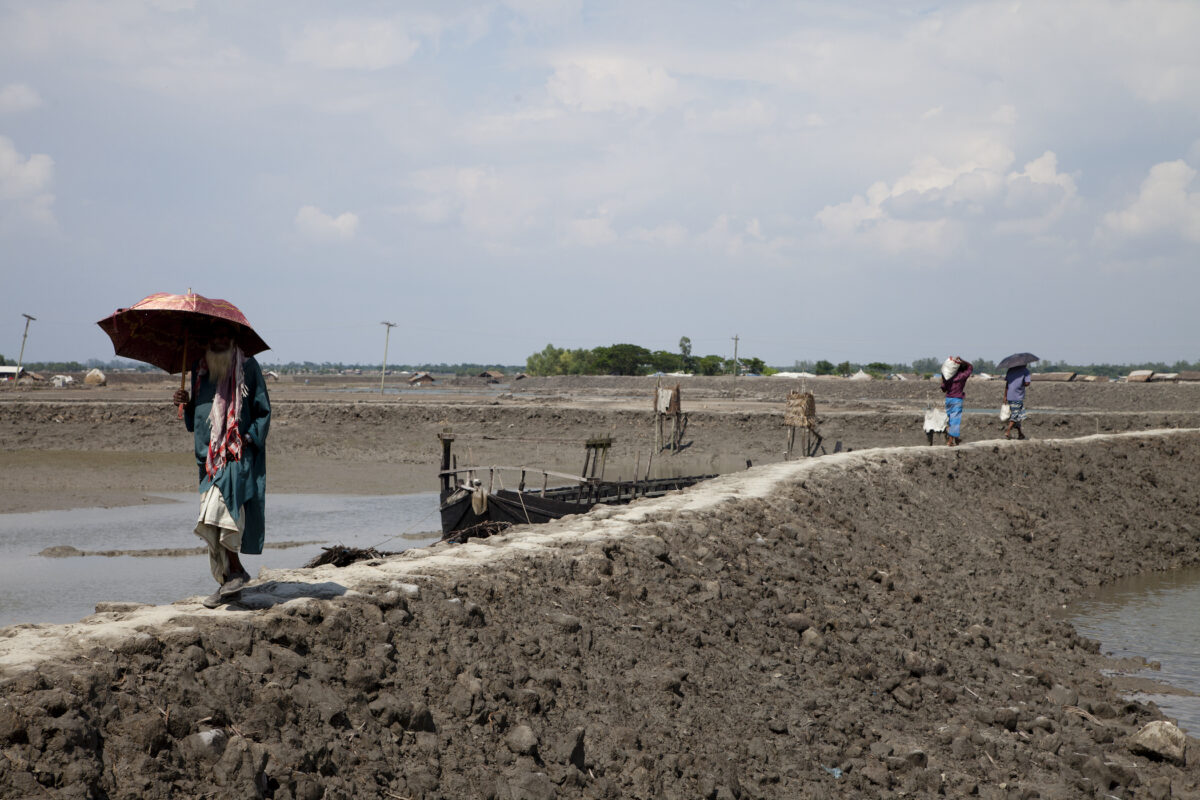
Can't Find Your Keys?; You Need A Chickadee Brain
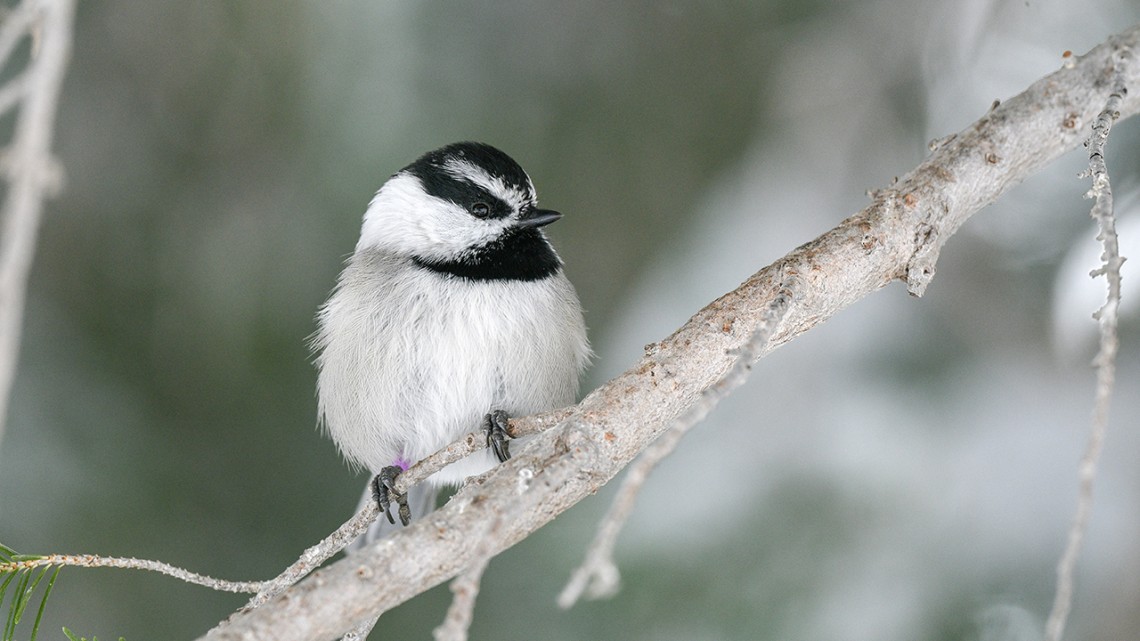
Disclaimer: These articles are not intended to provide medical advice, diagnosis or treatment. Views expressed here do not necessarily reflect those of Pittwater Online News or its staff.